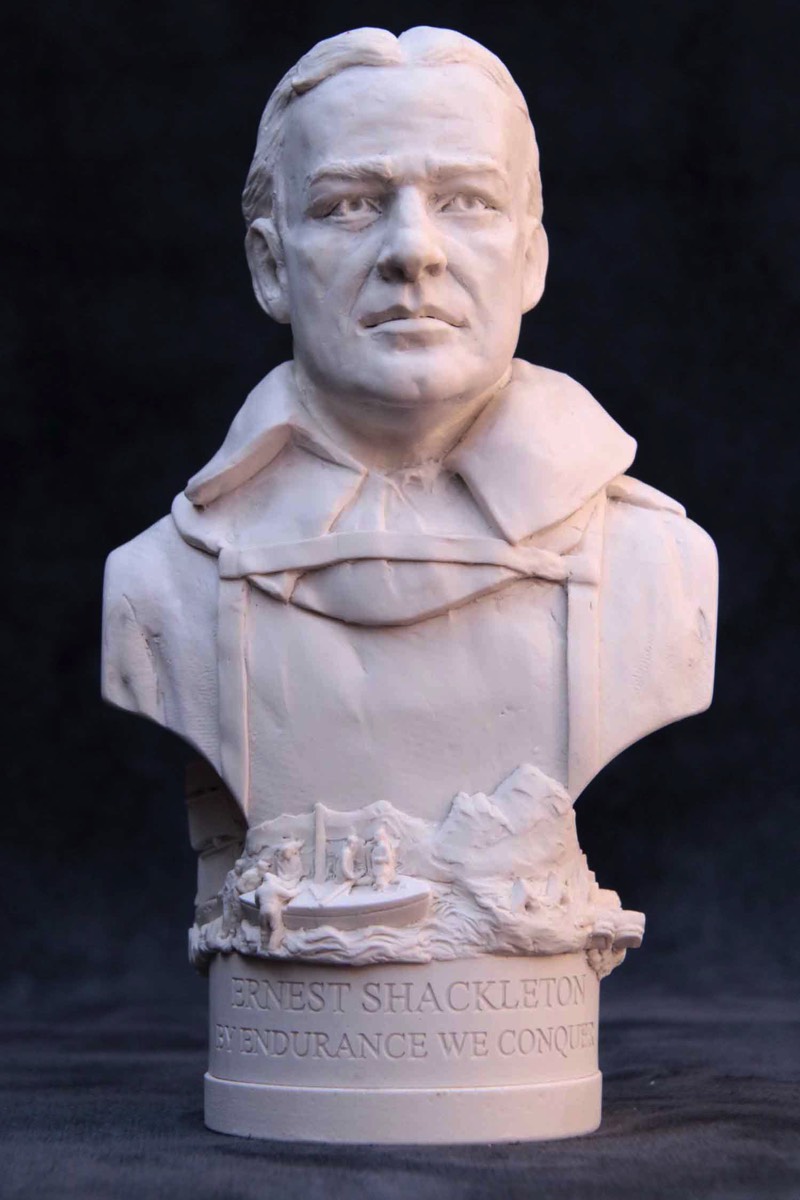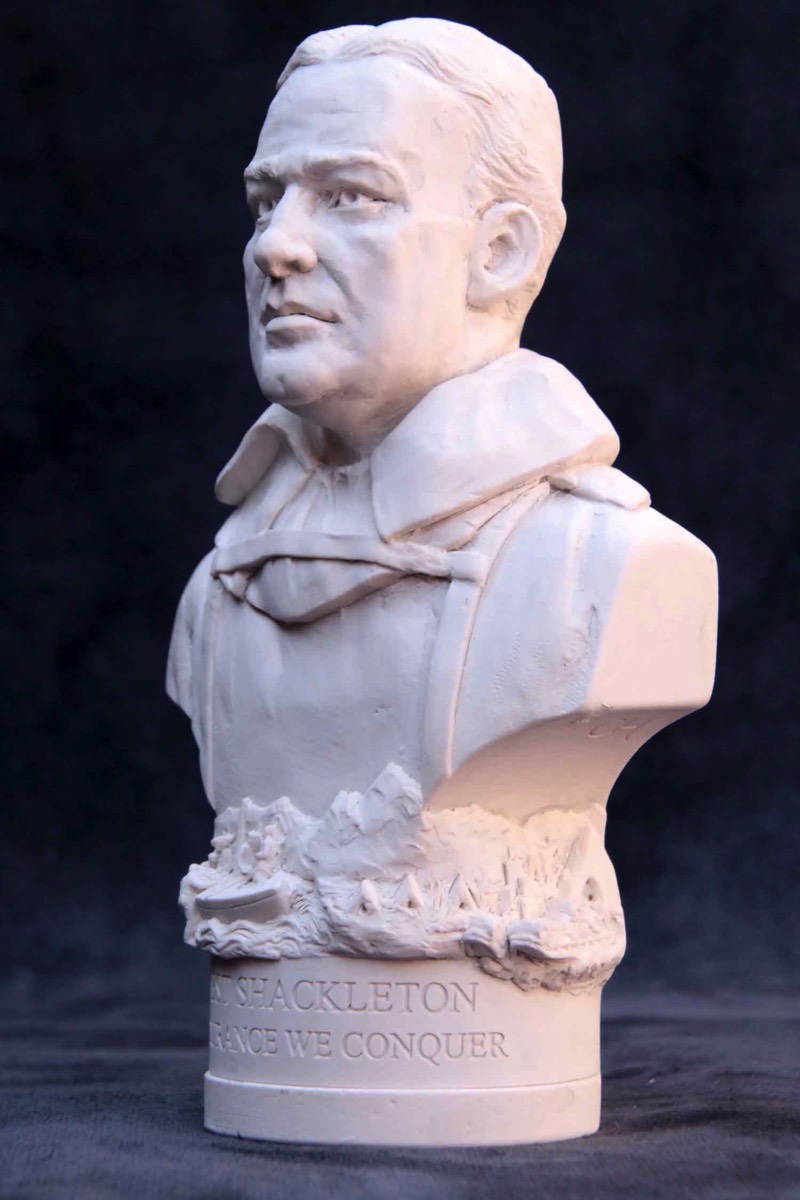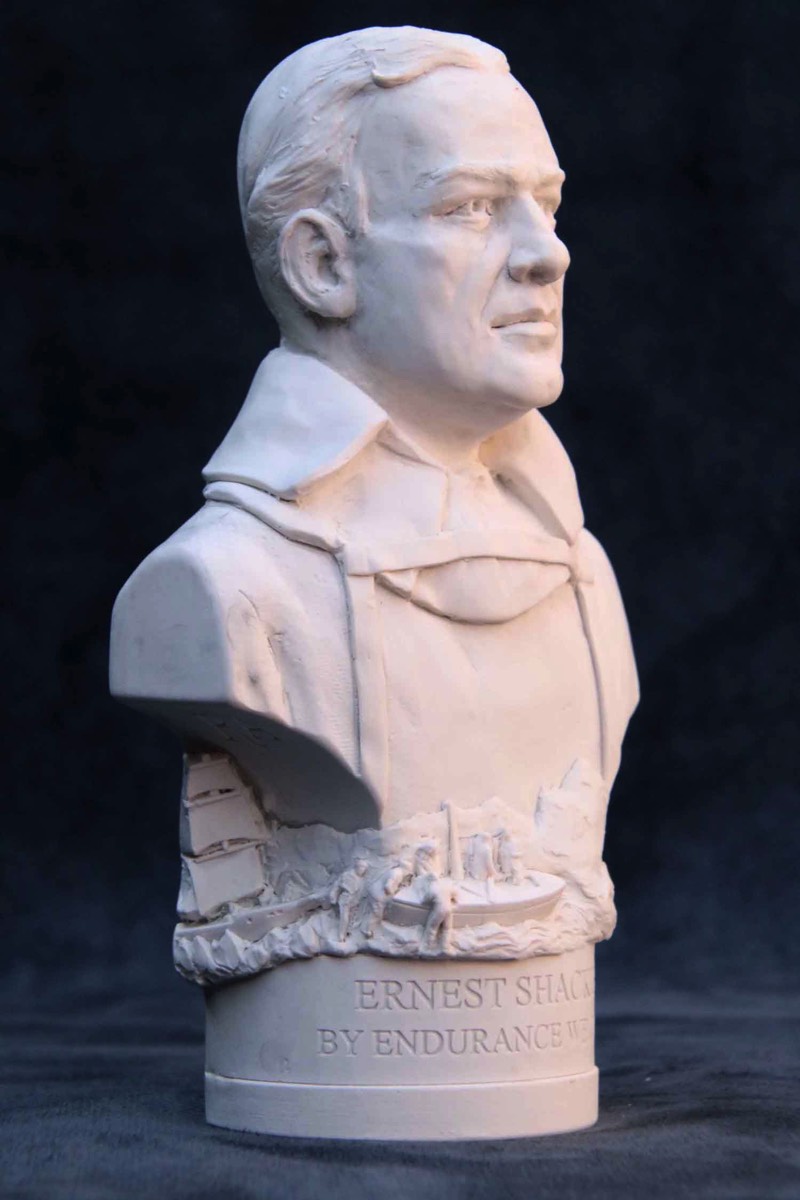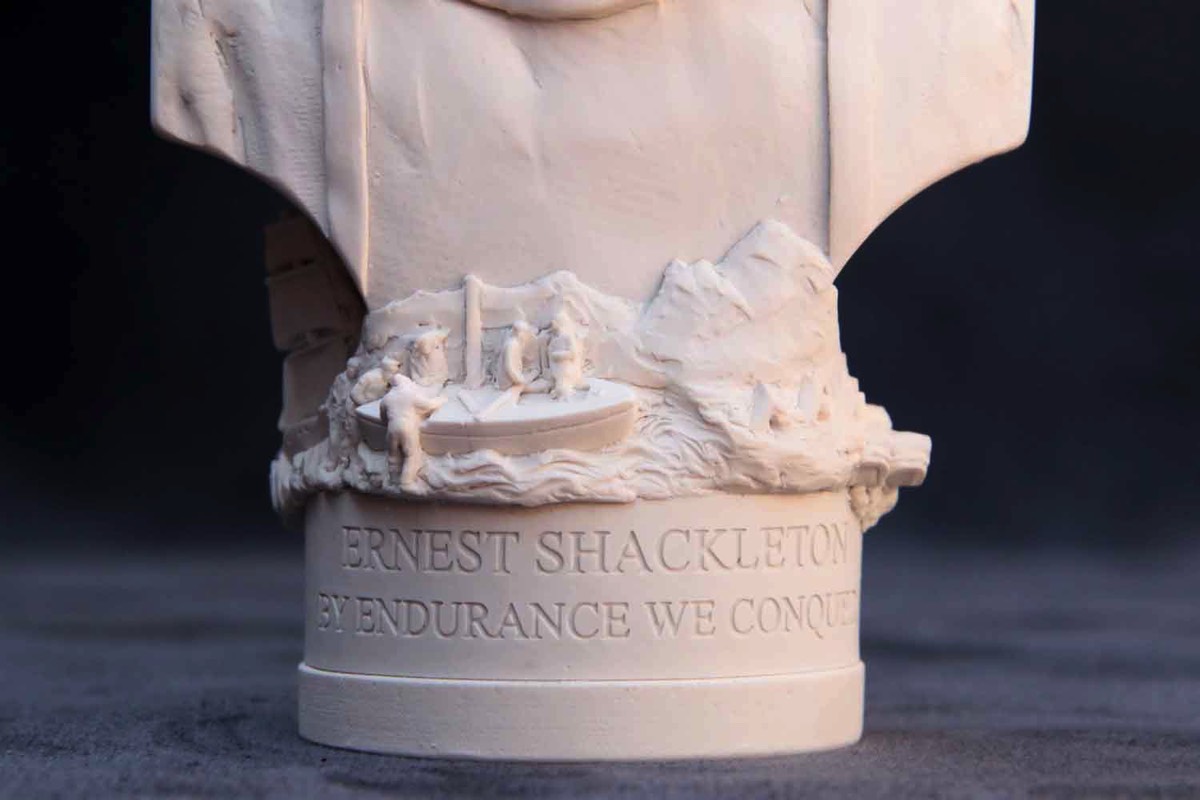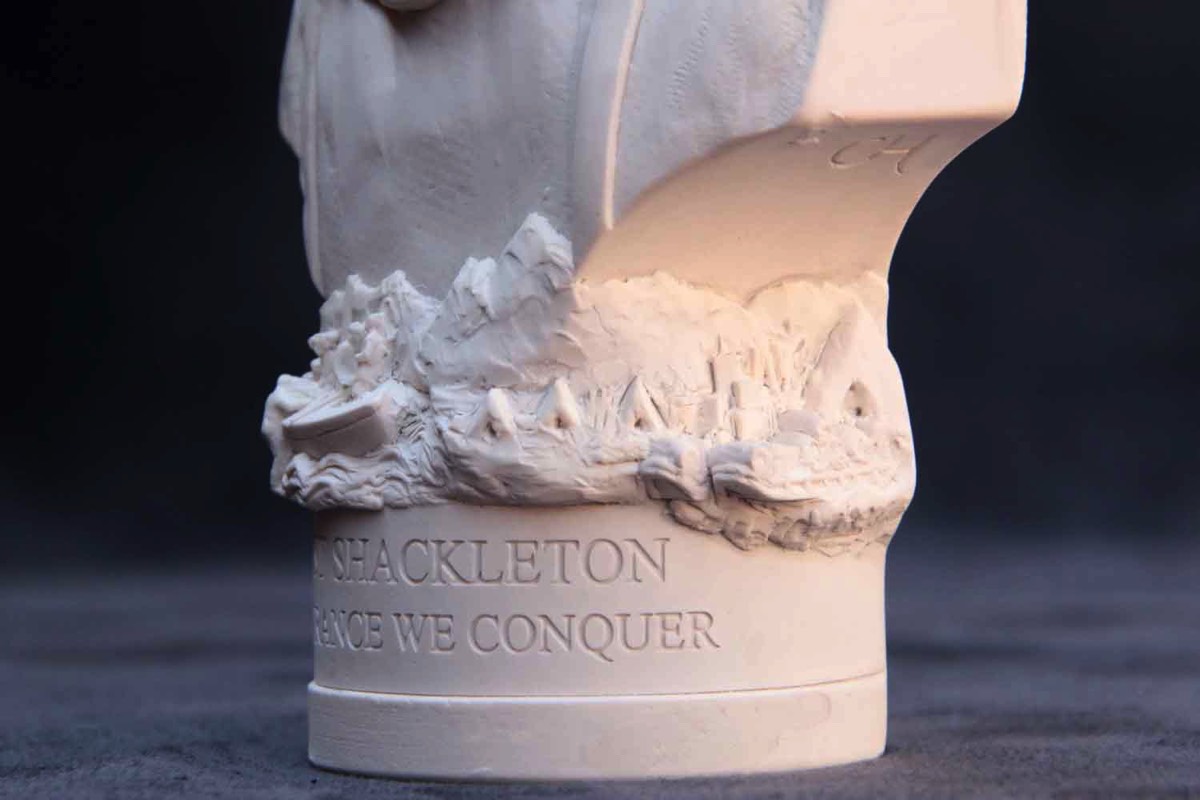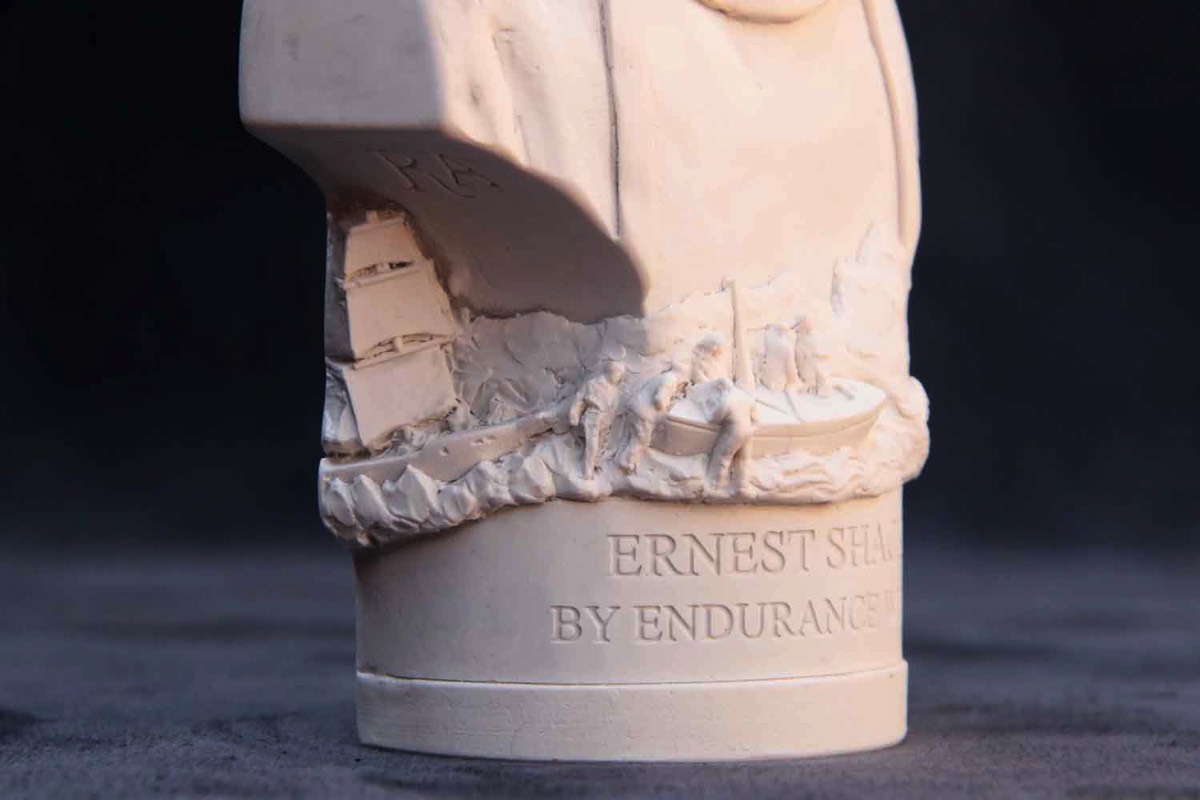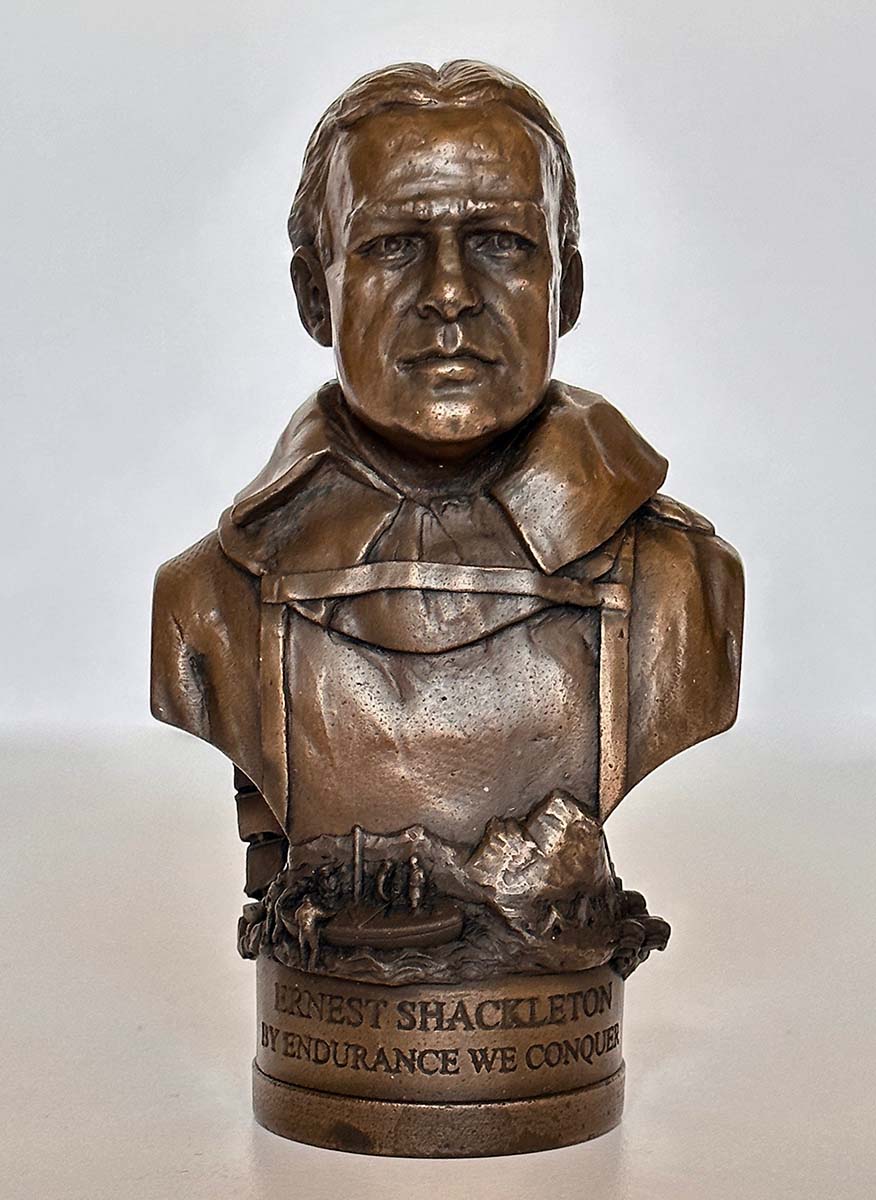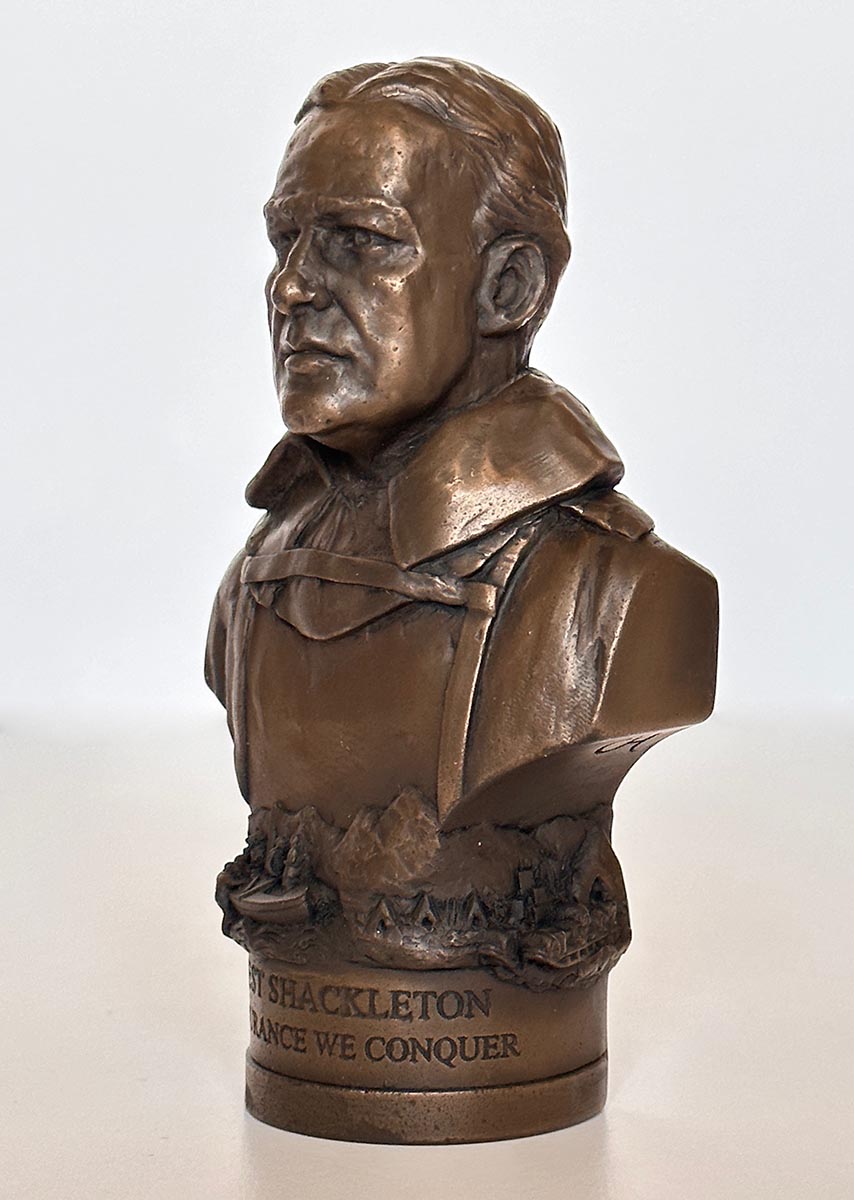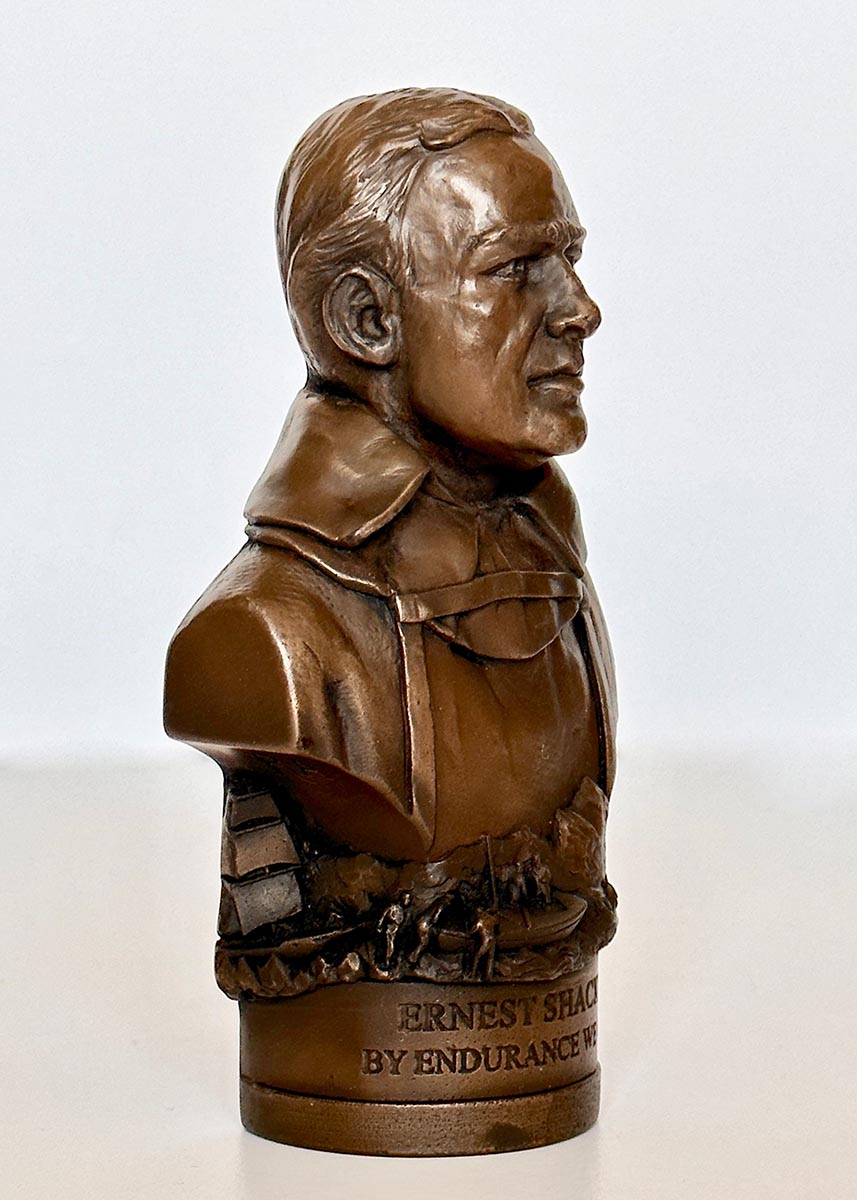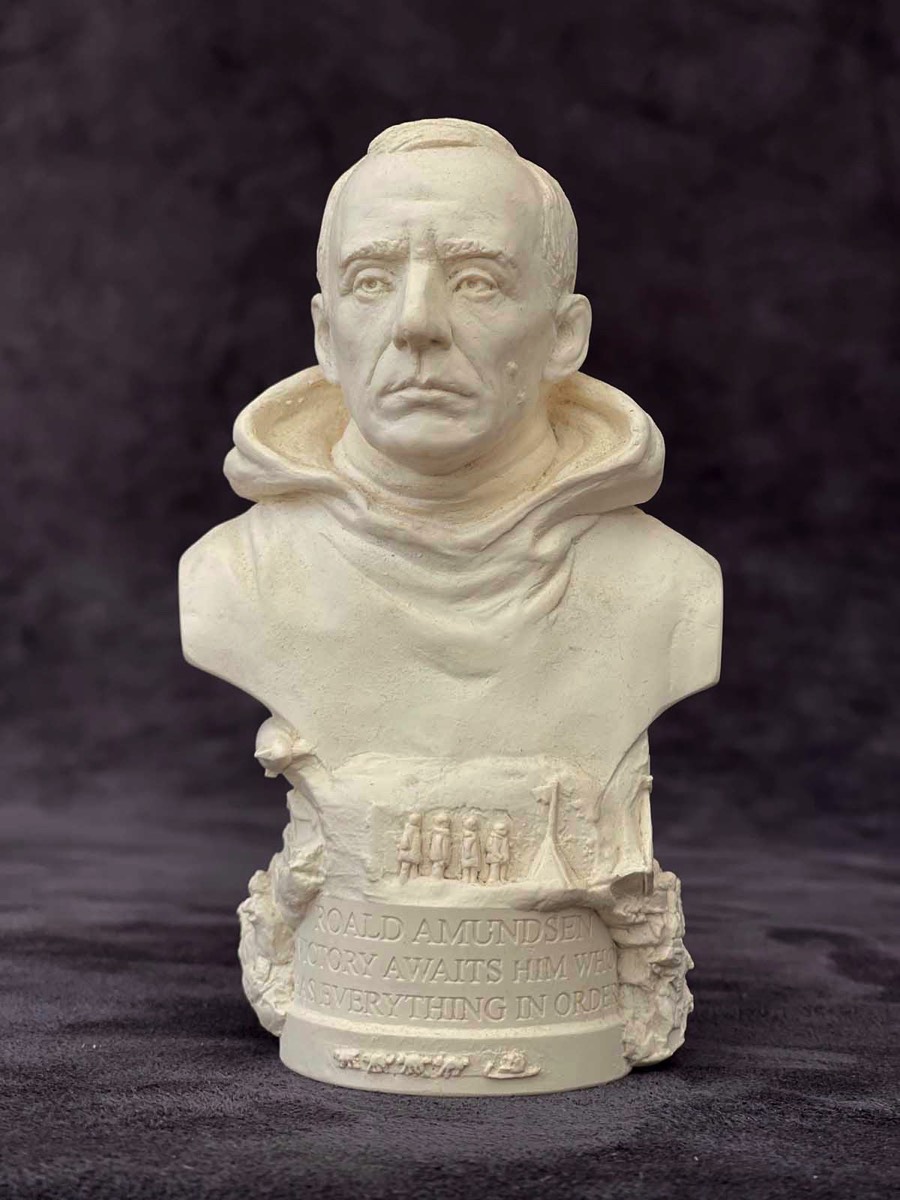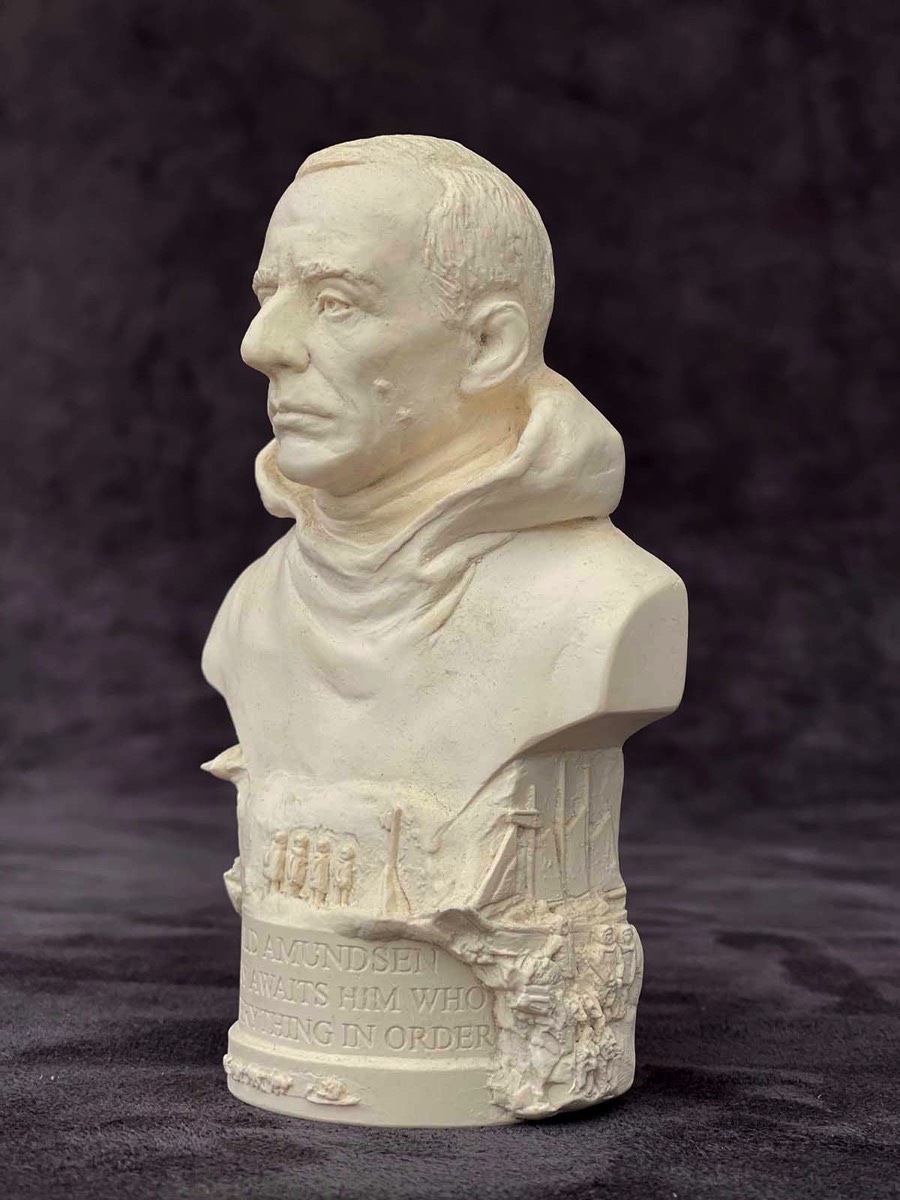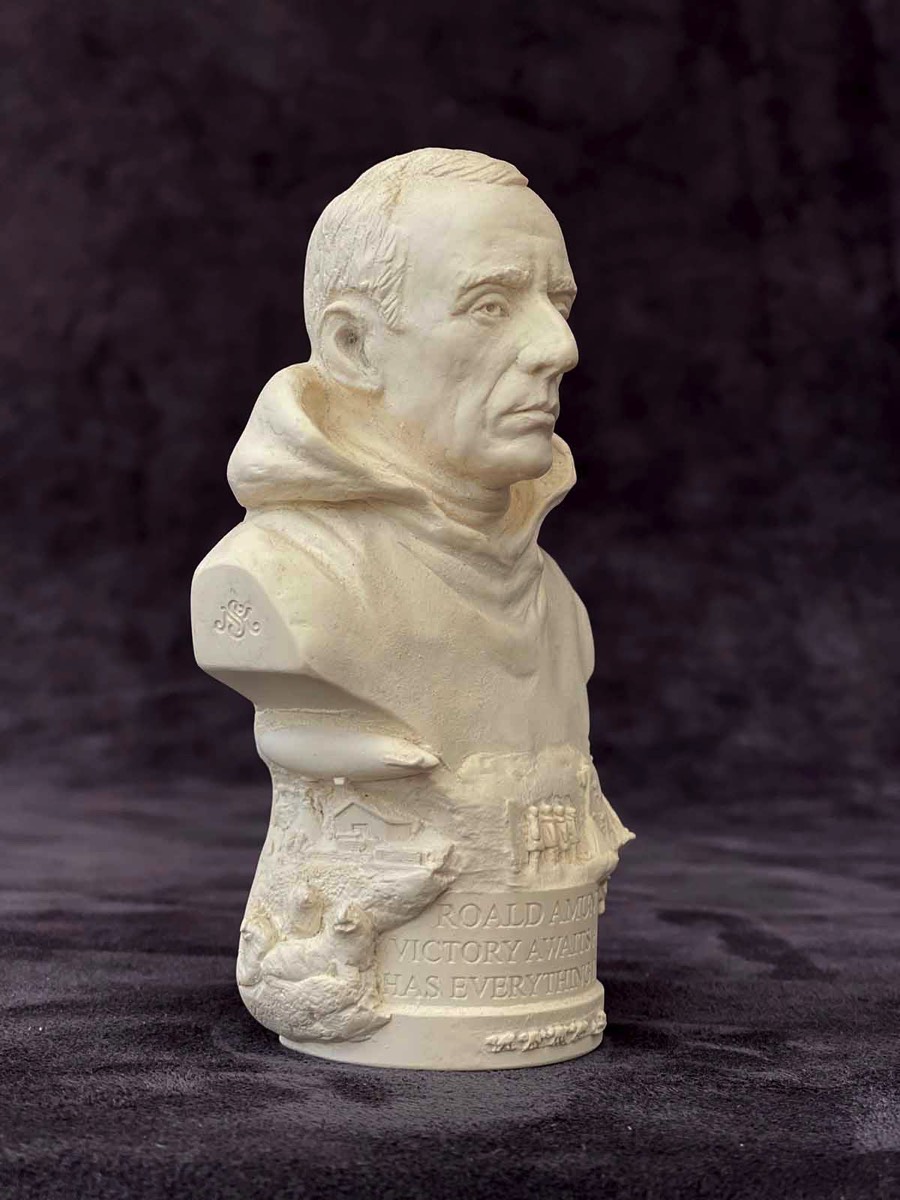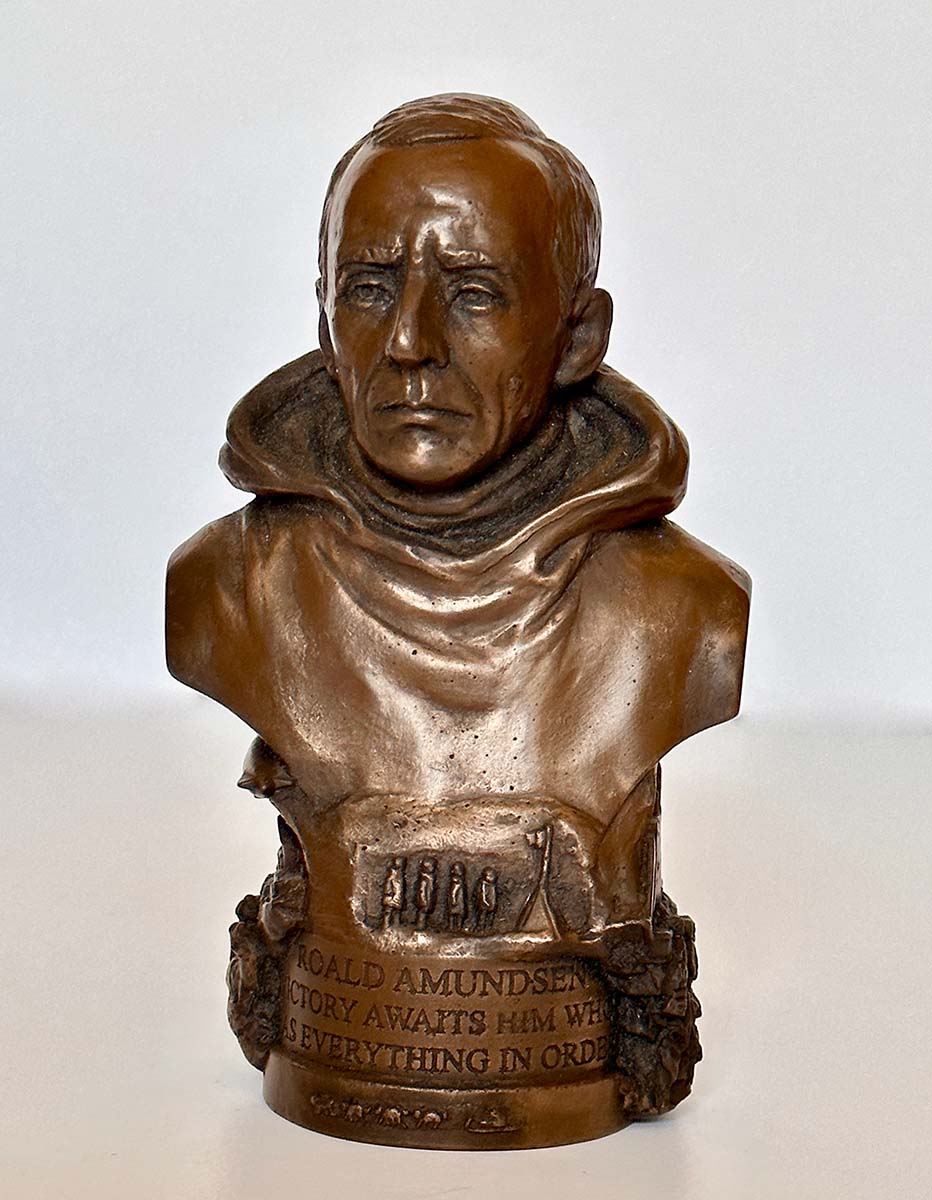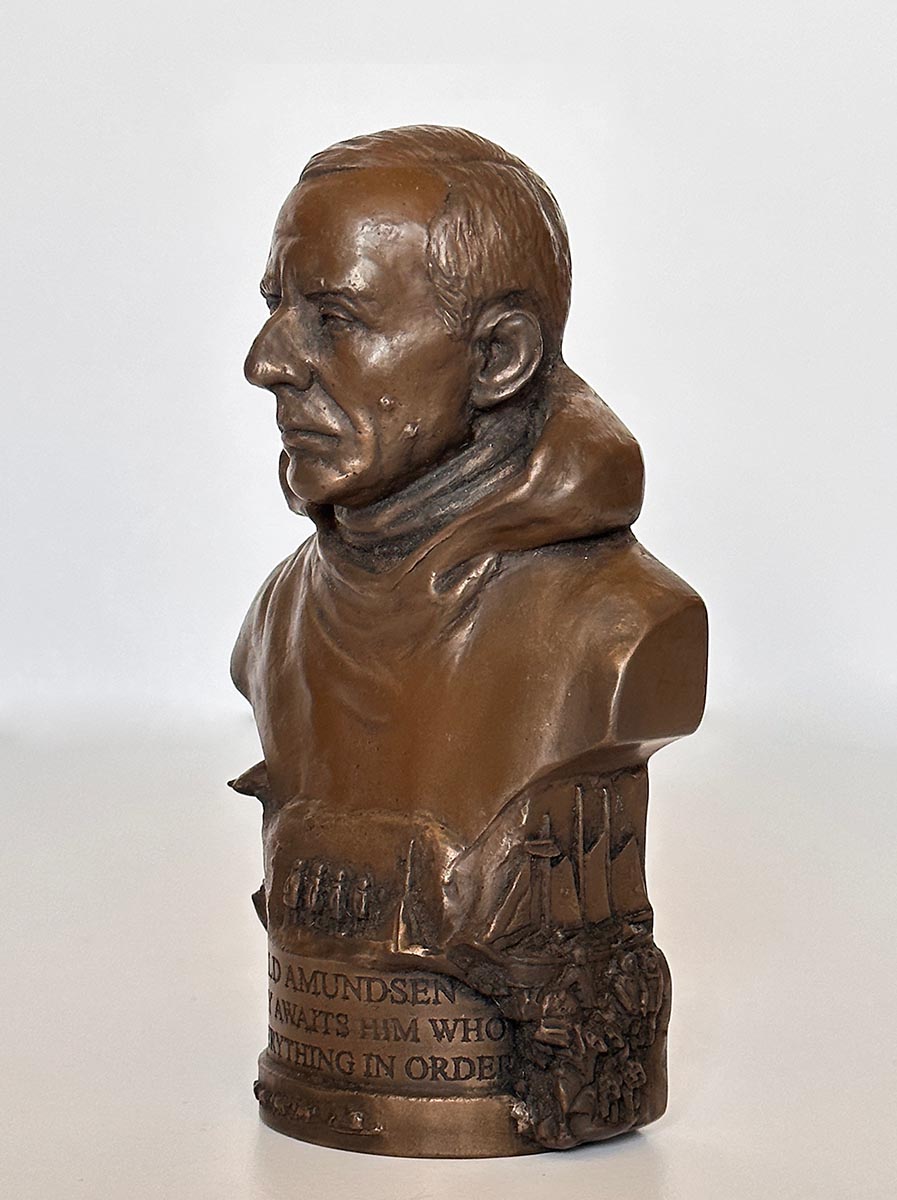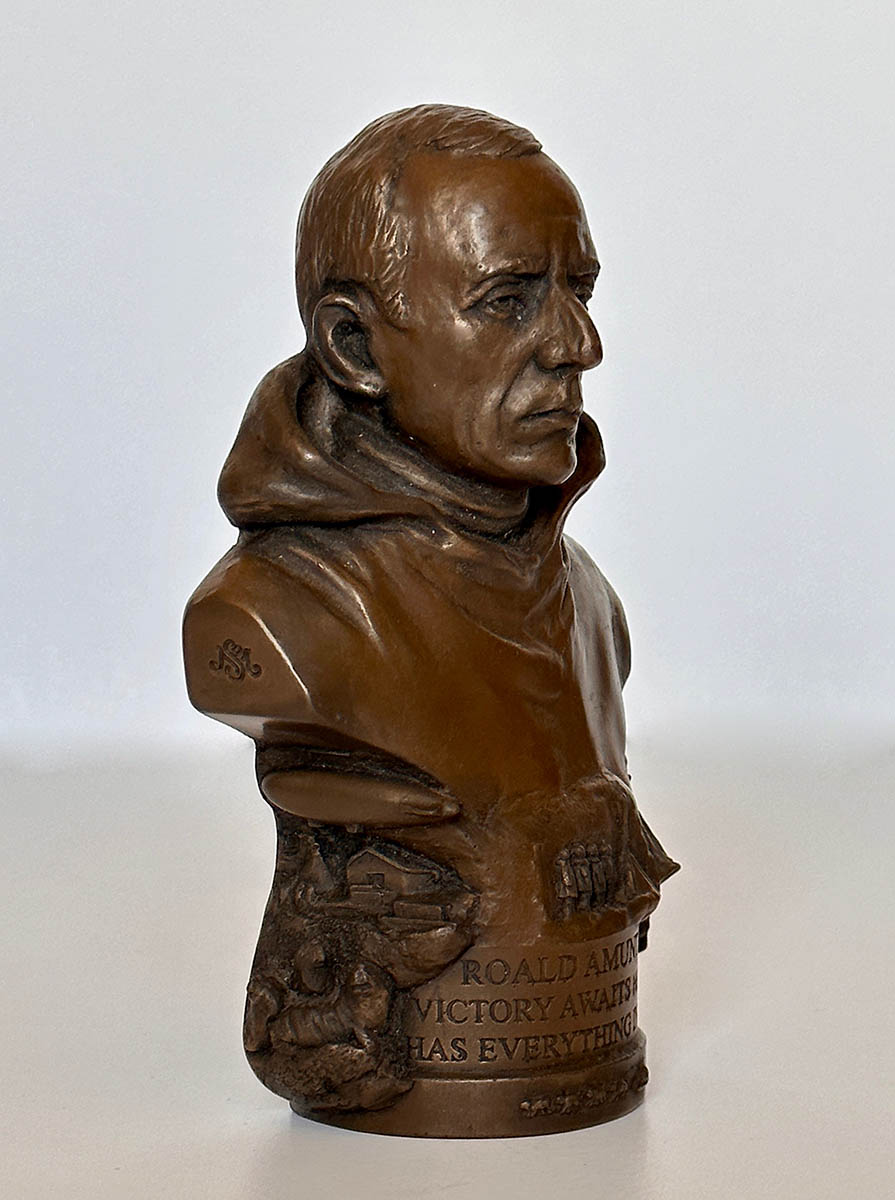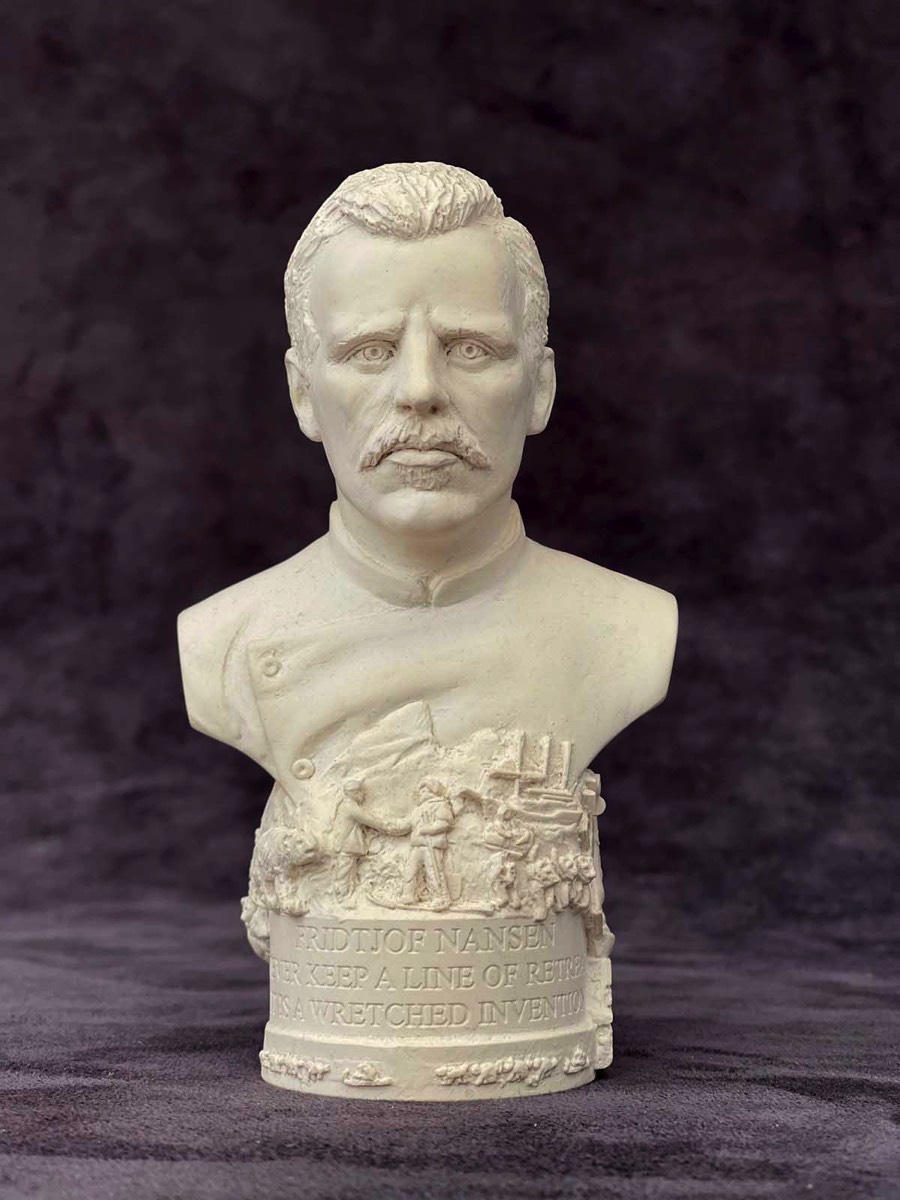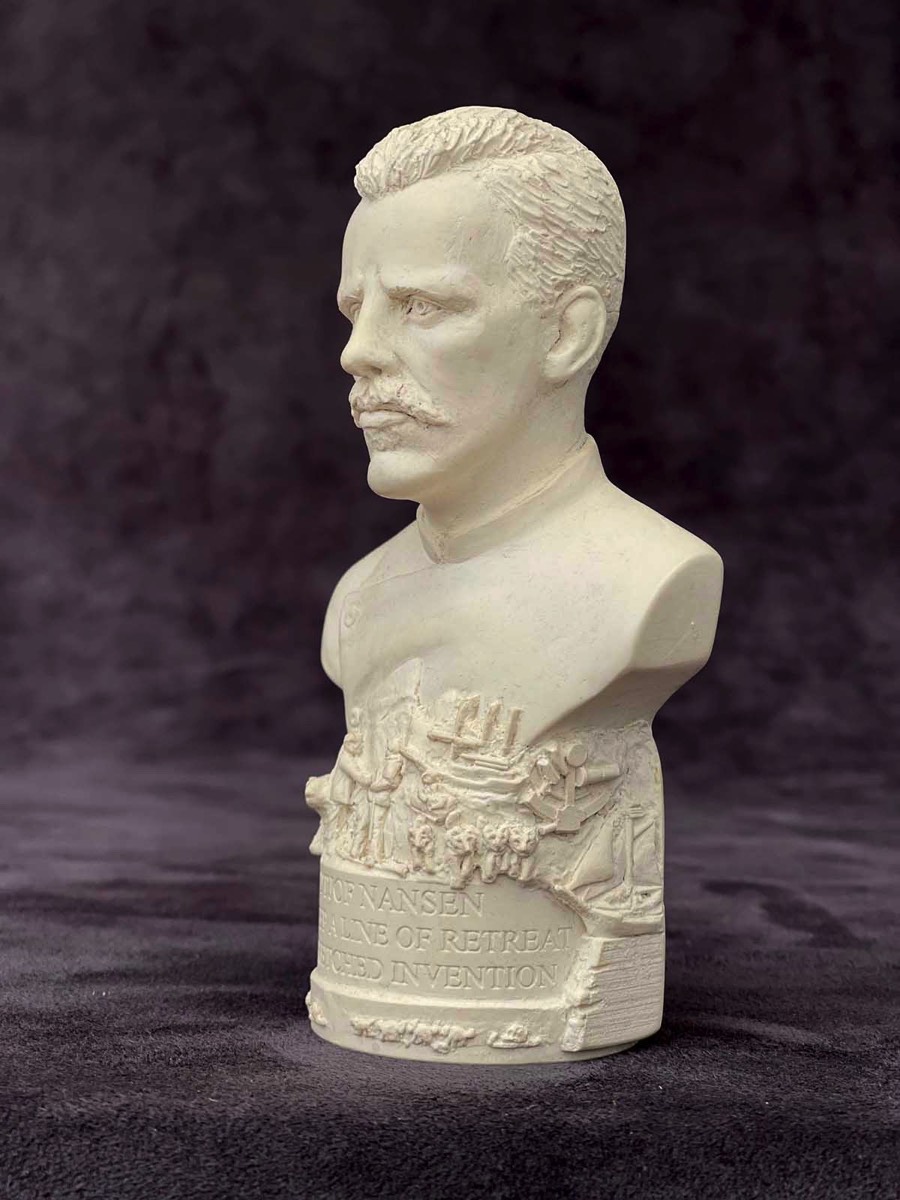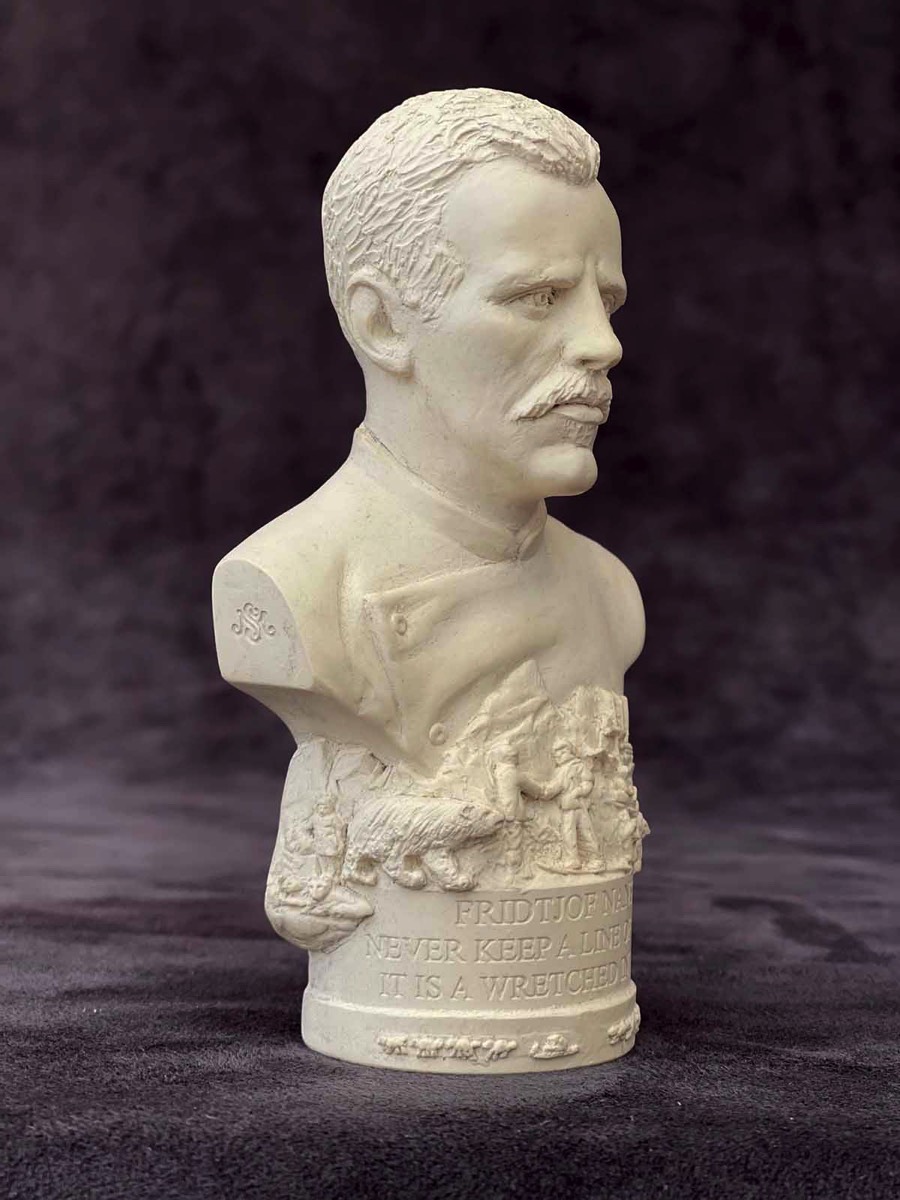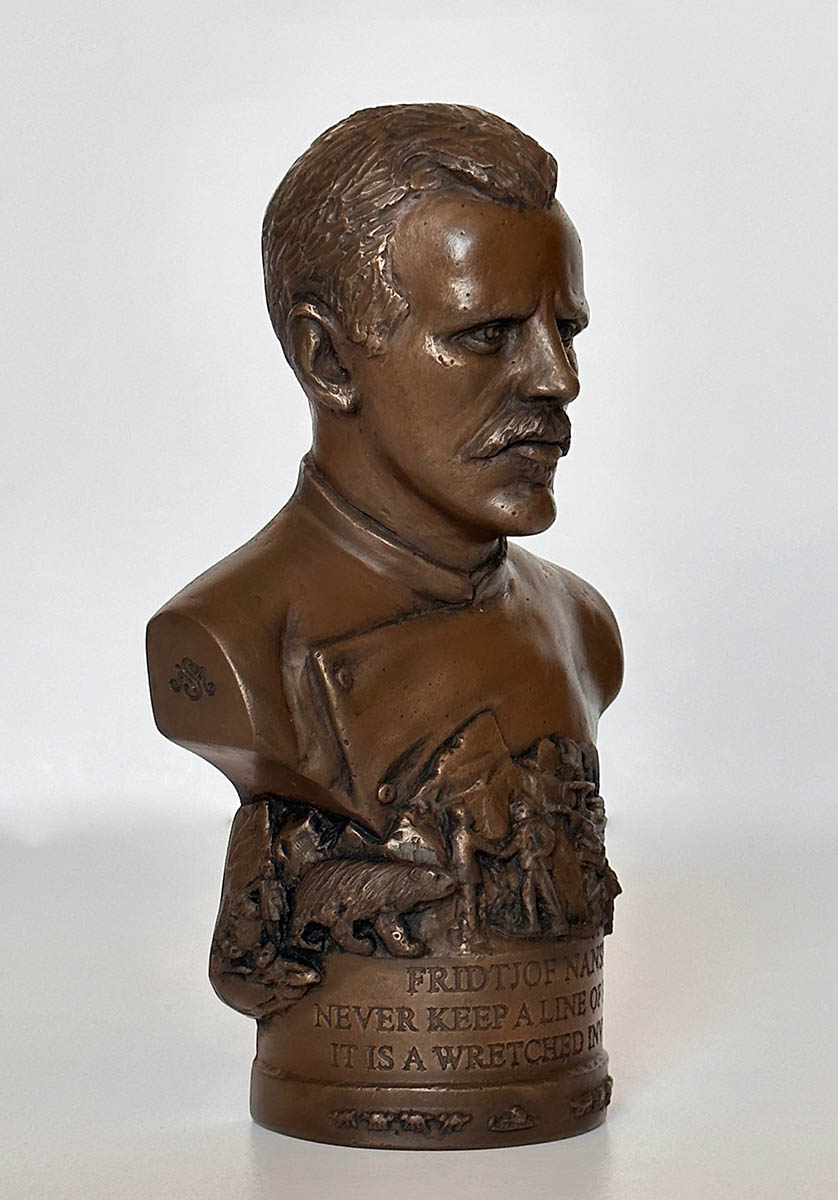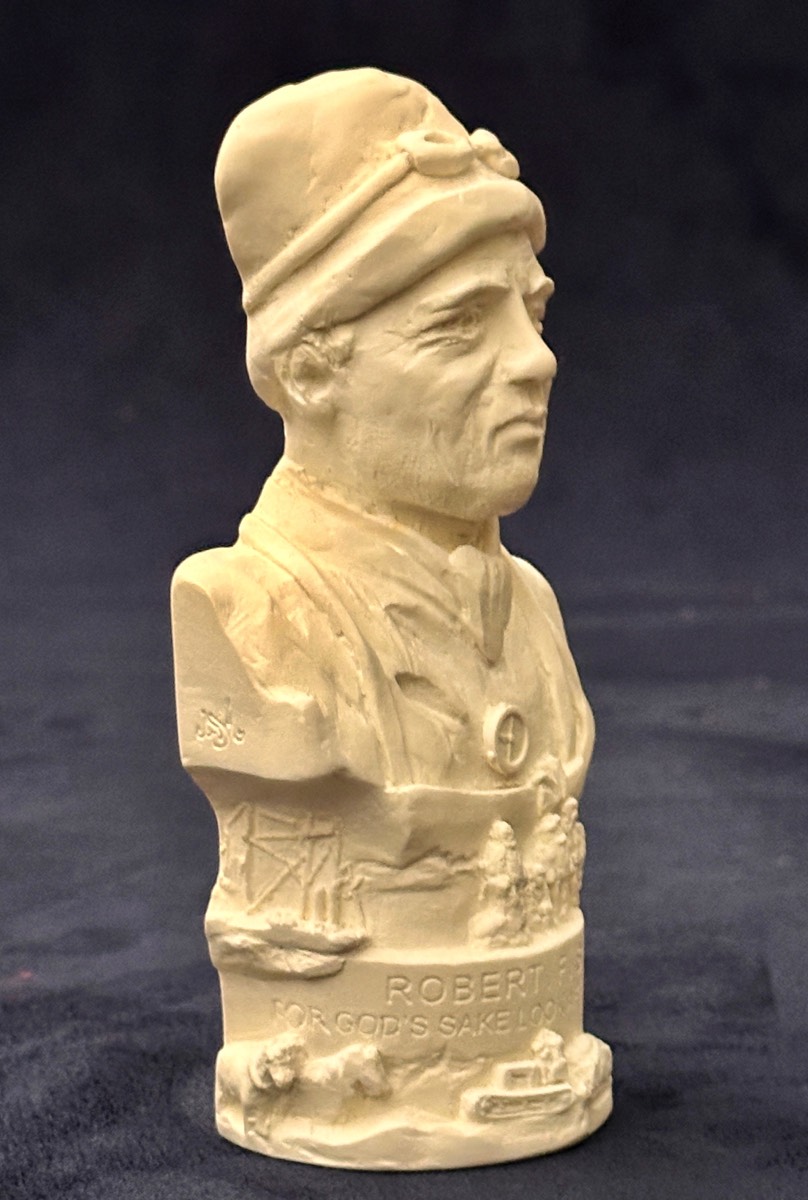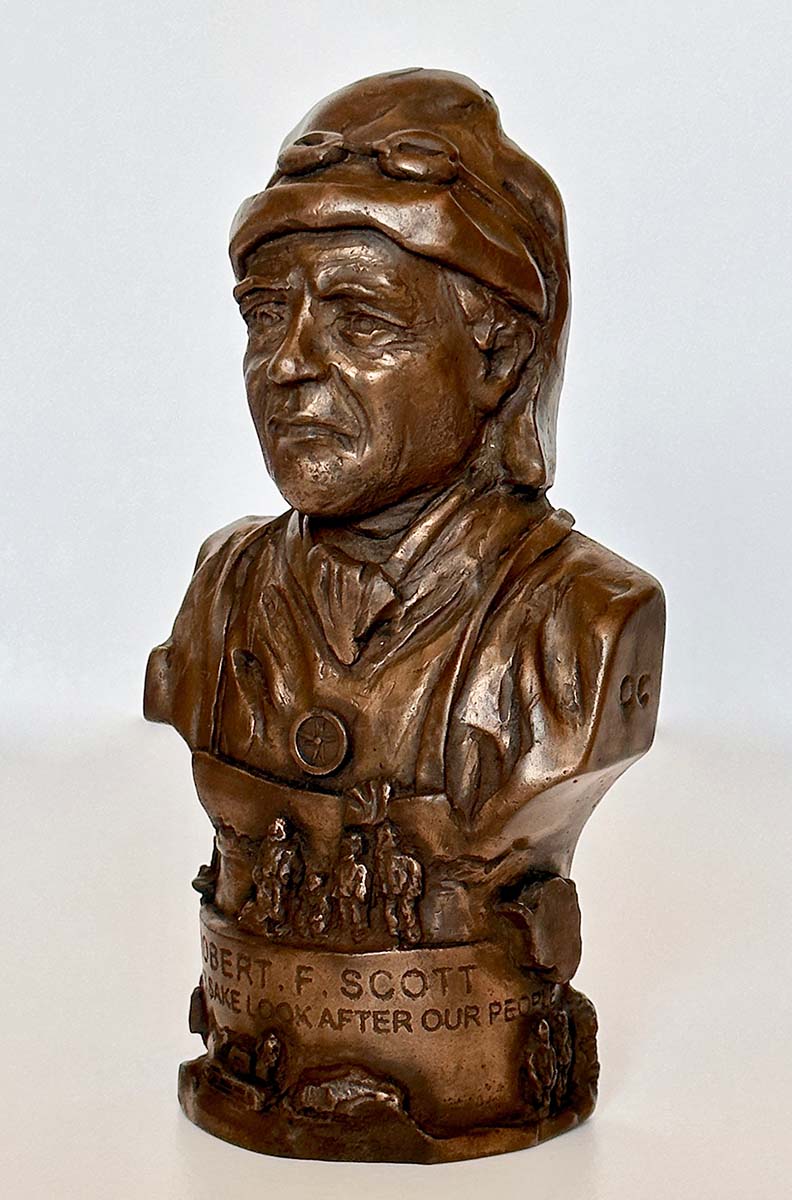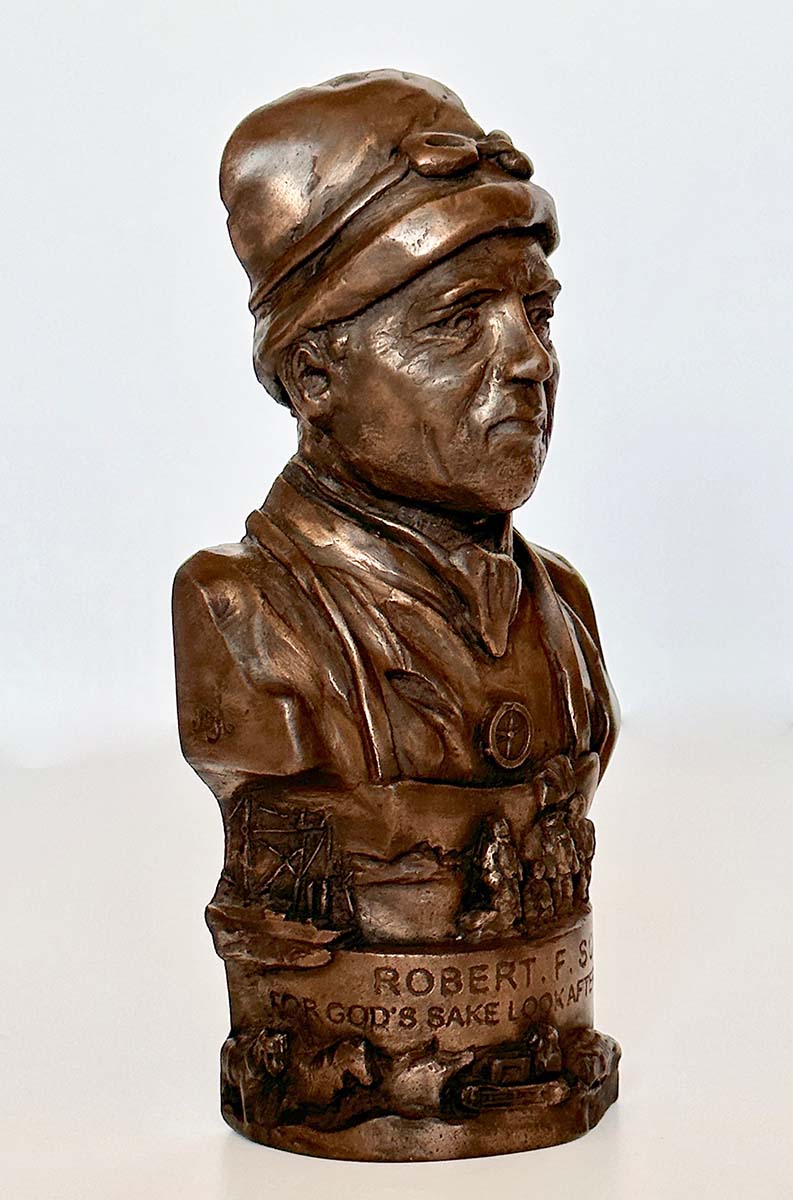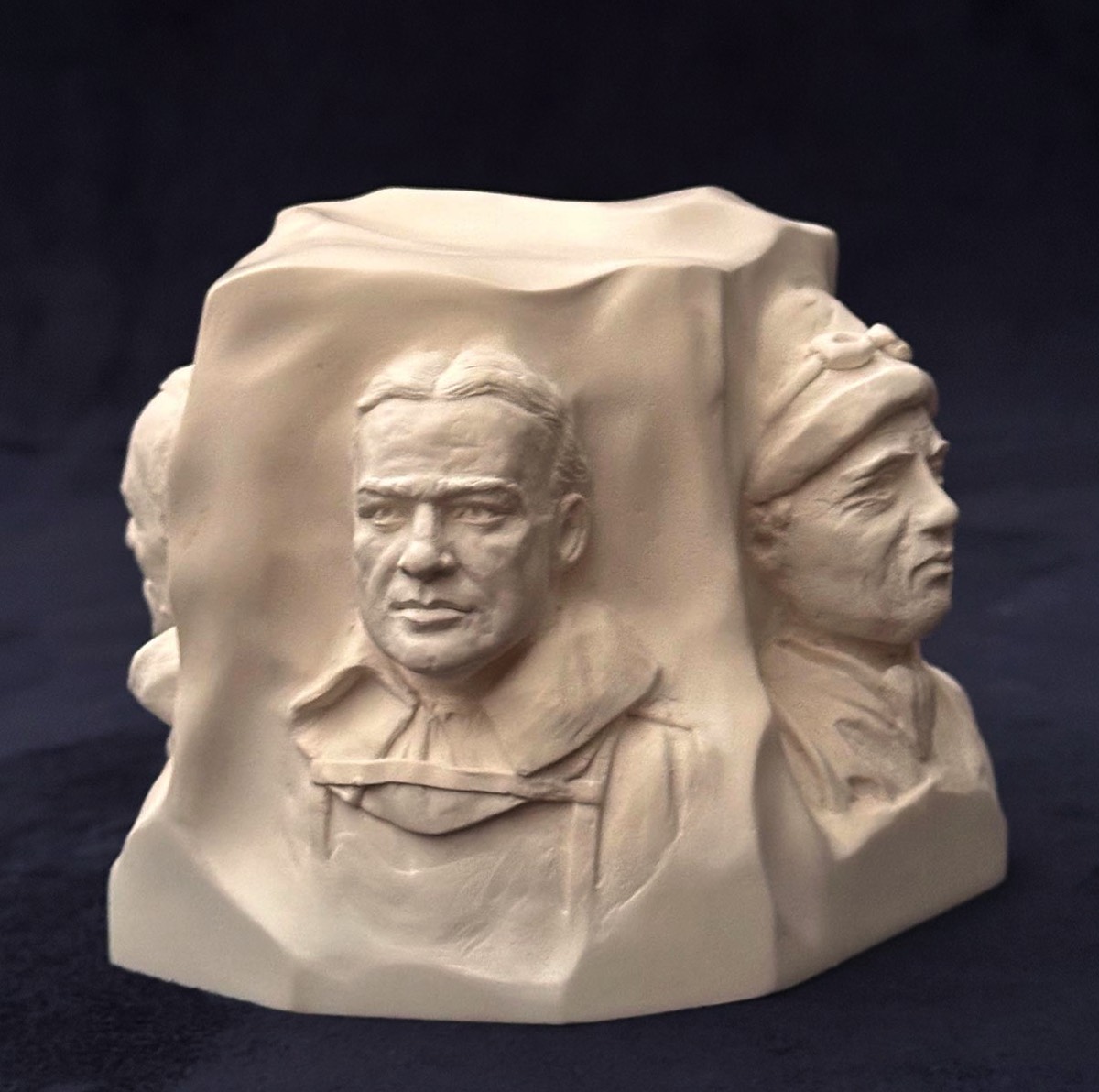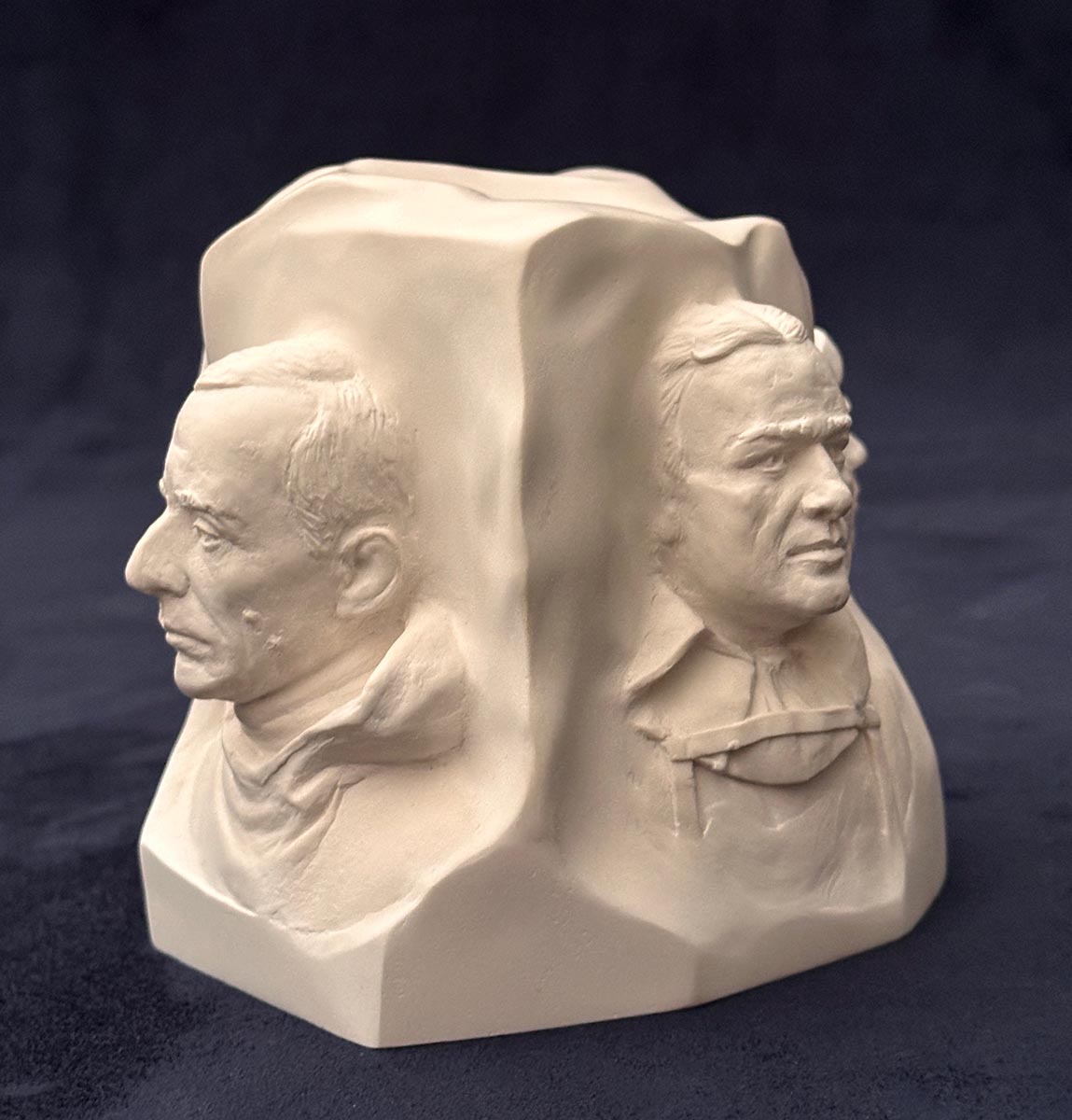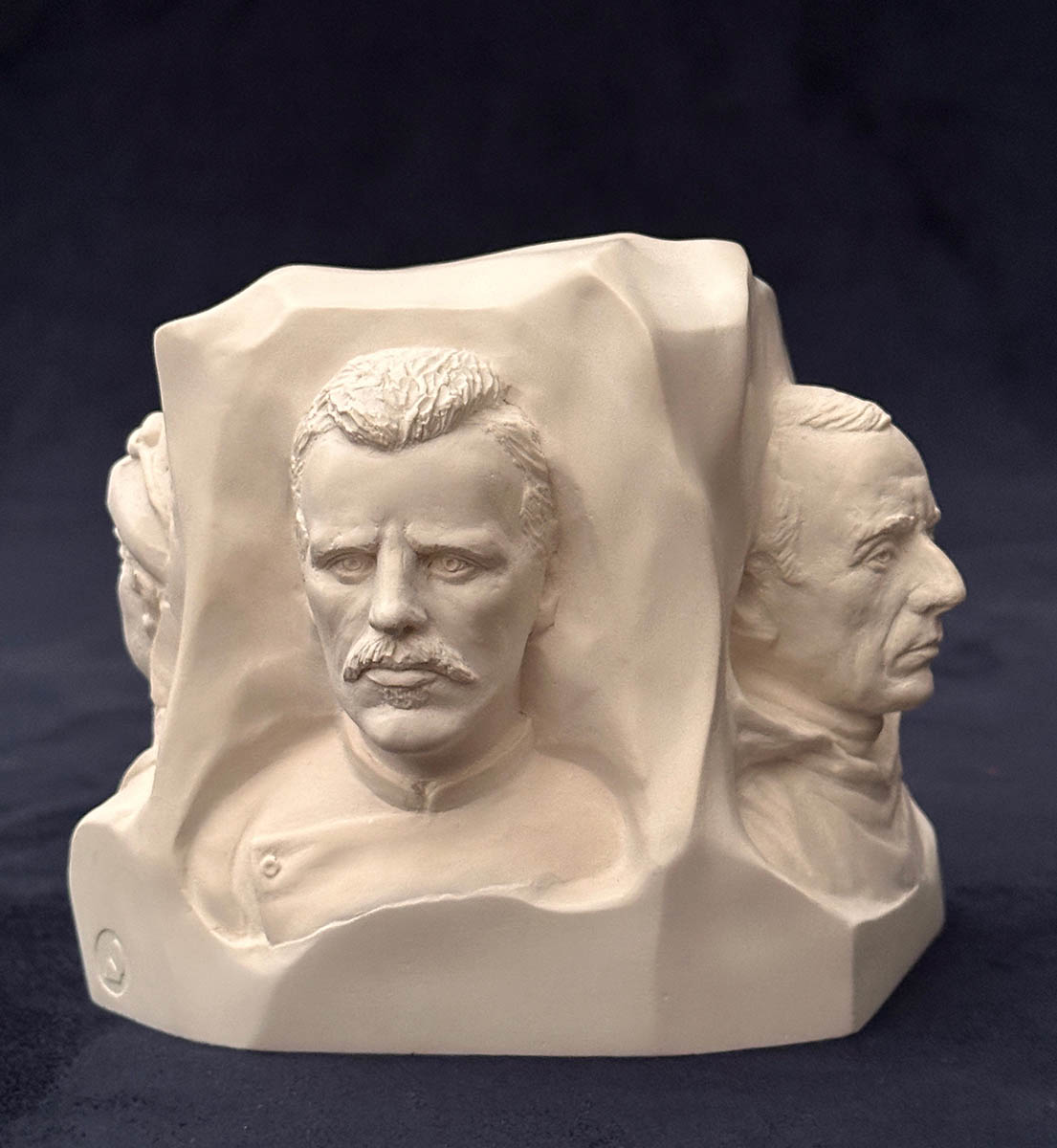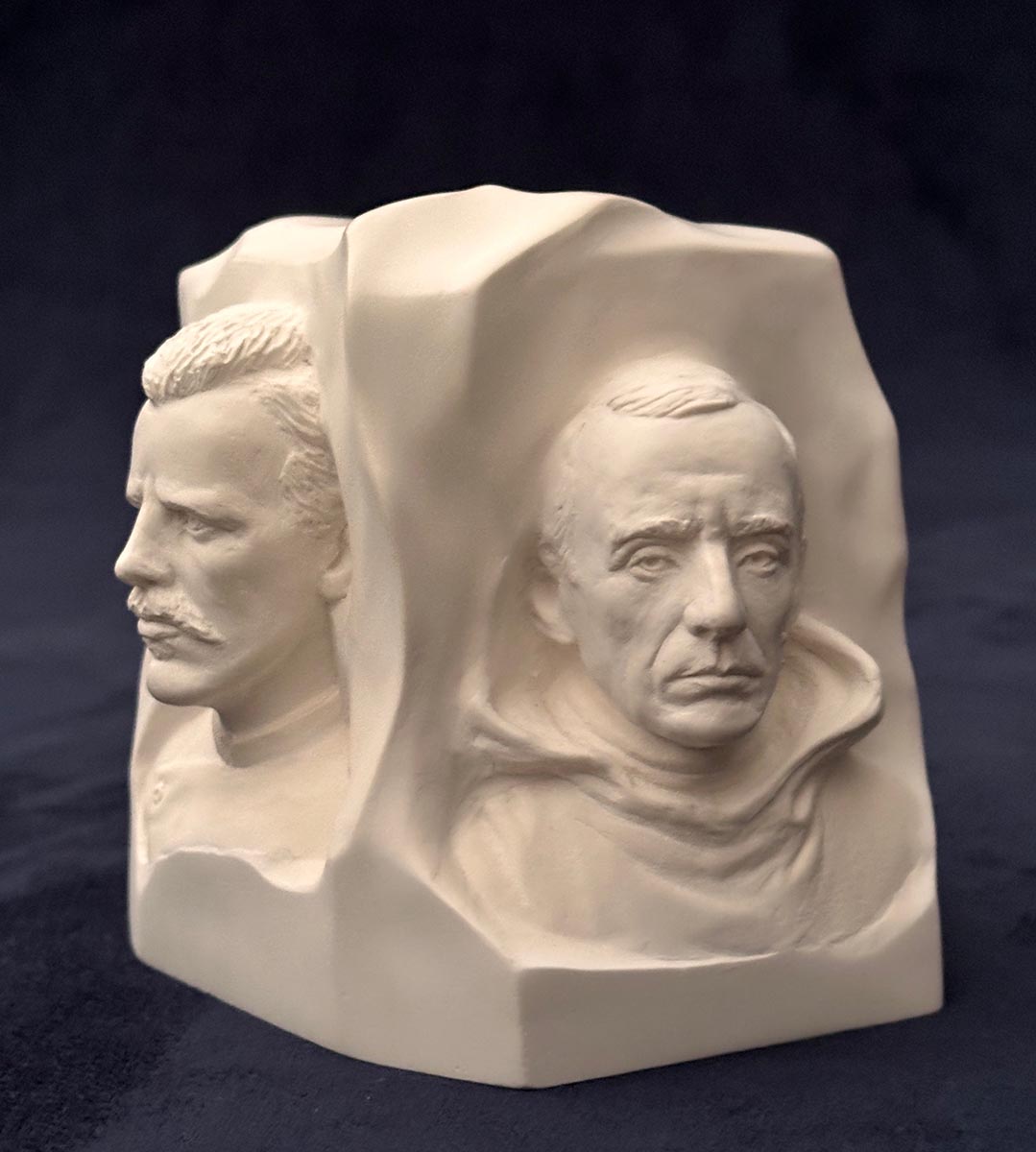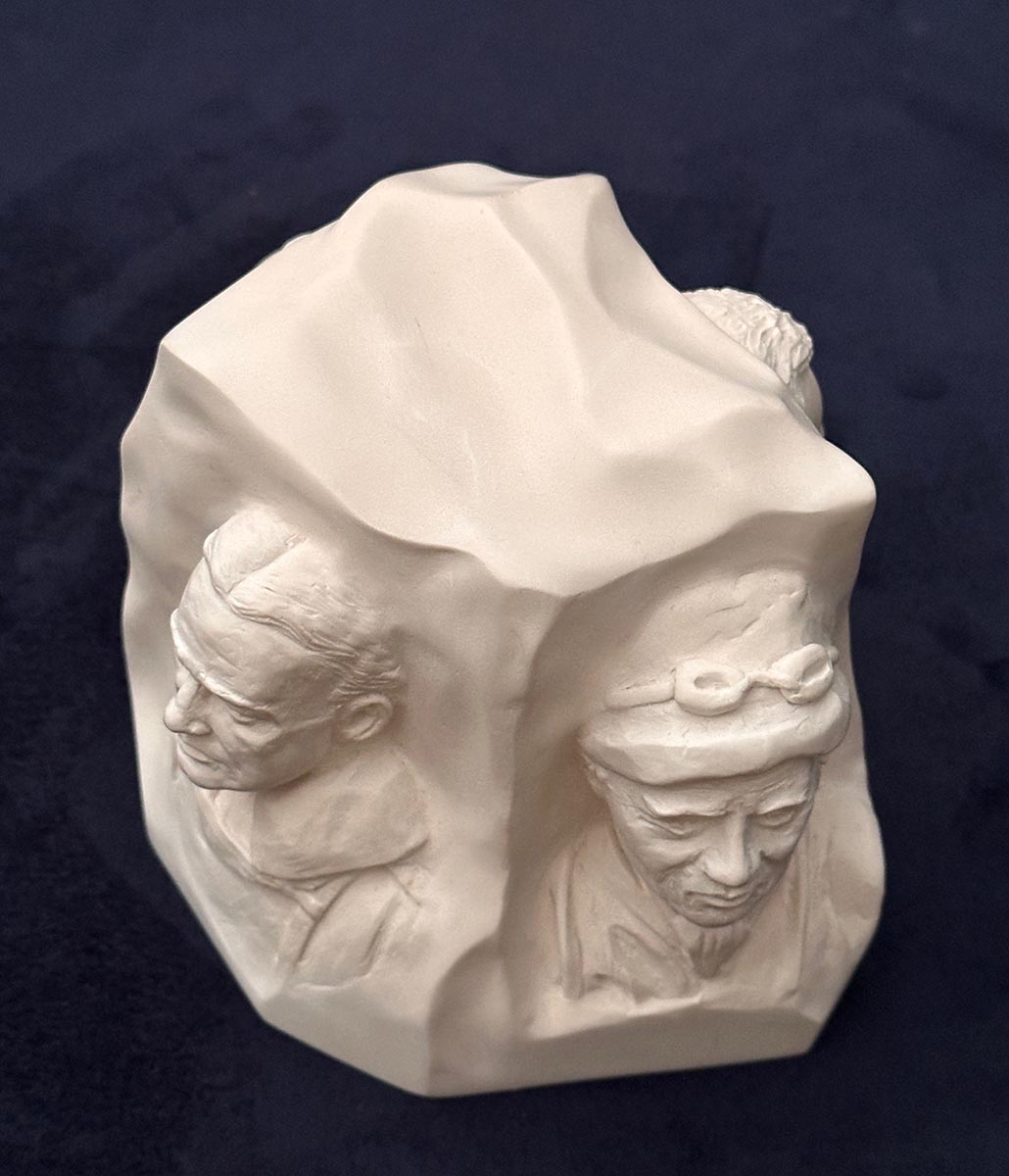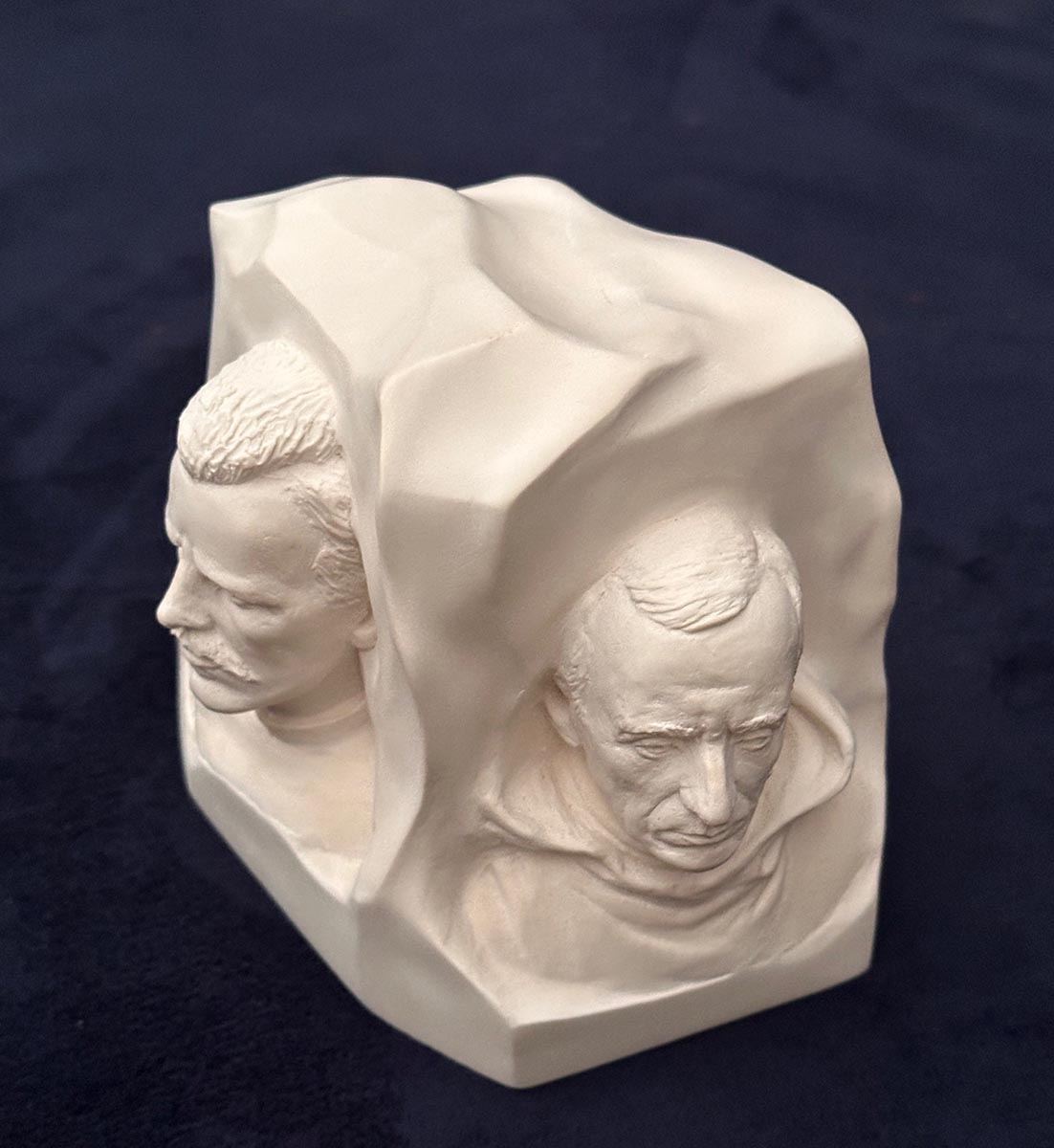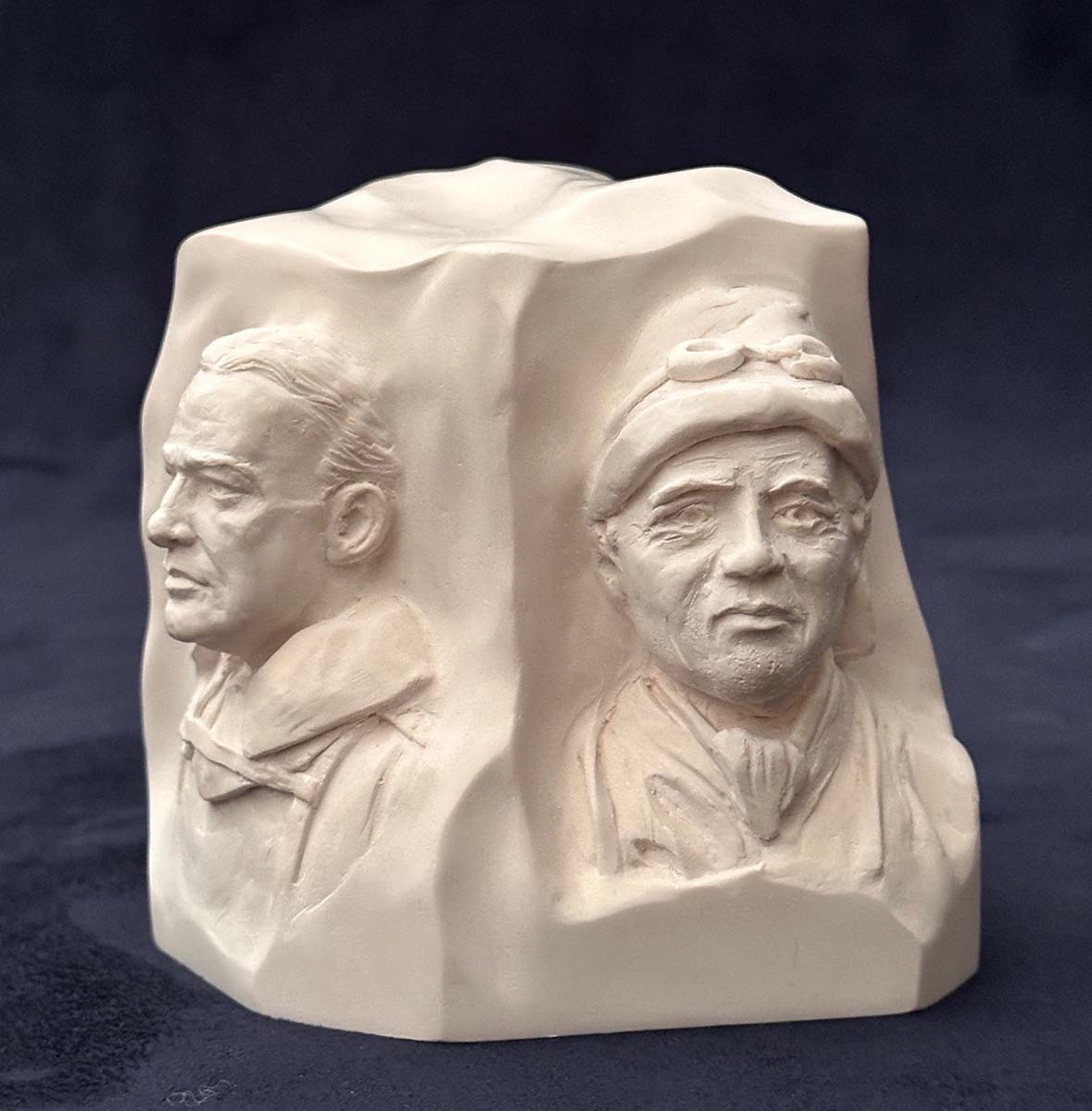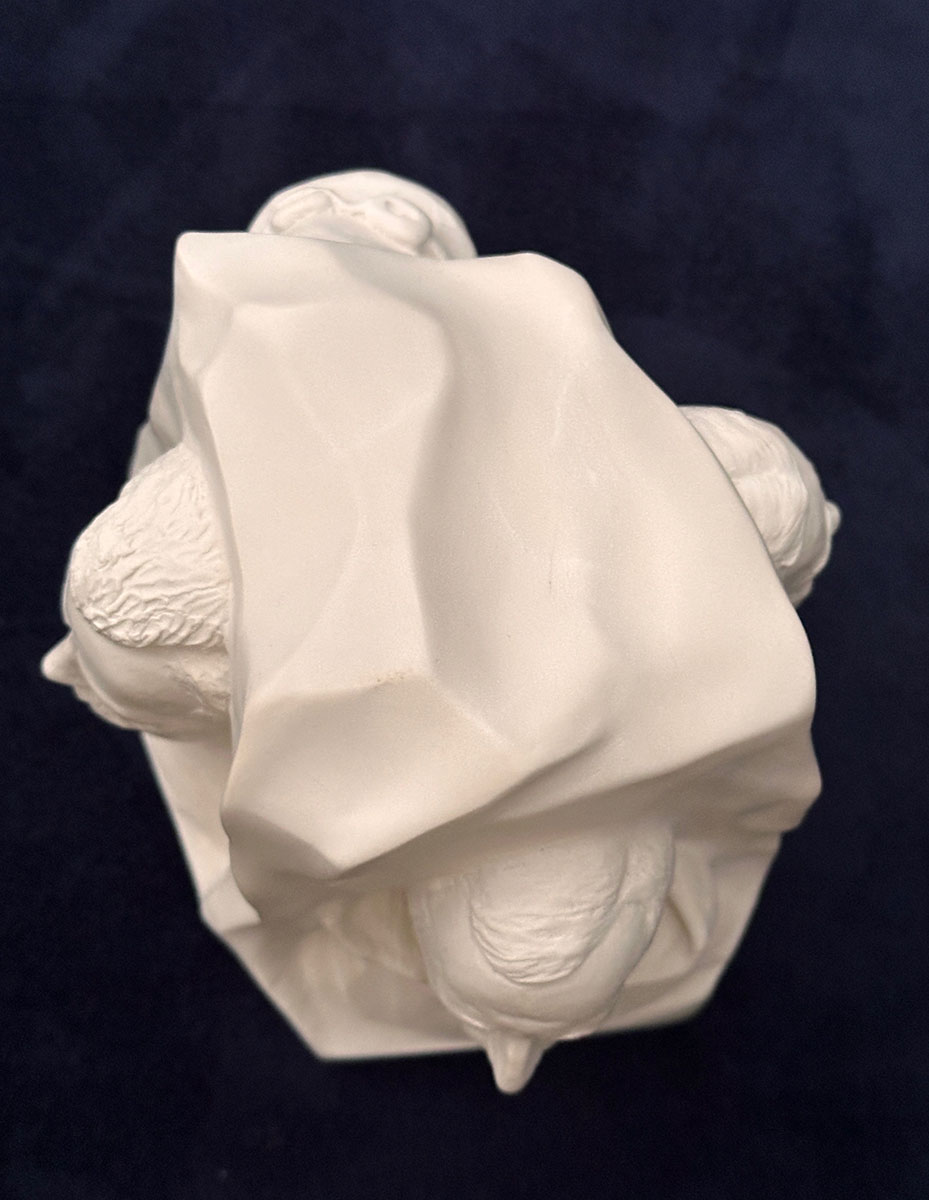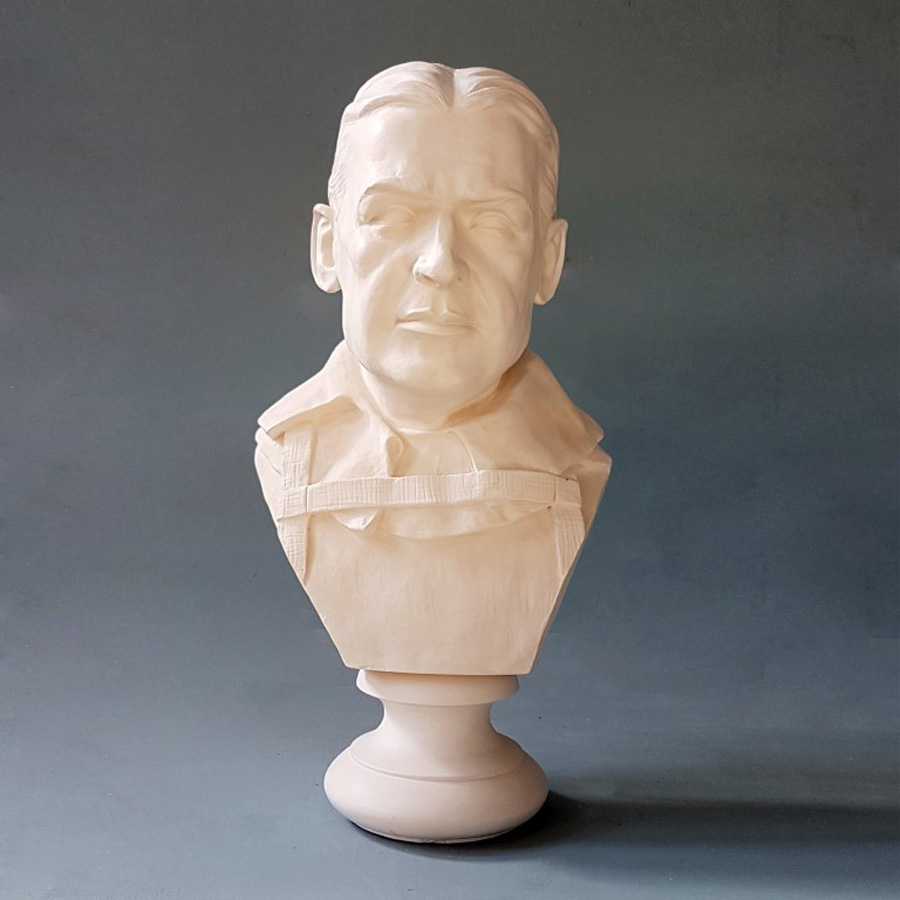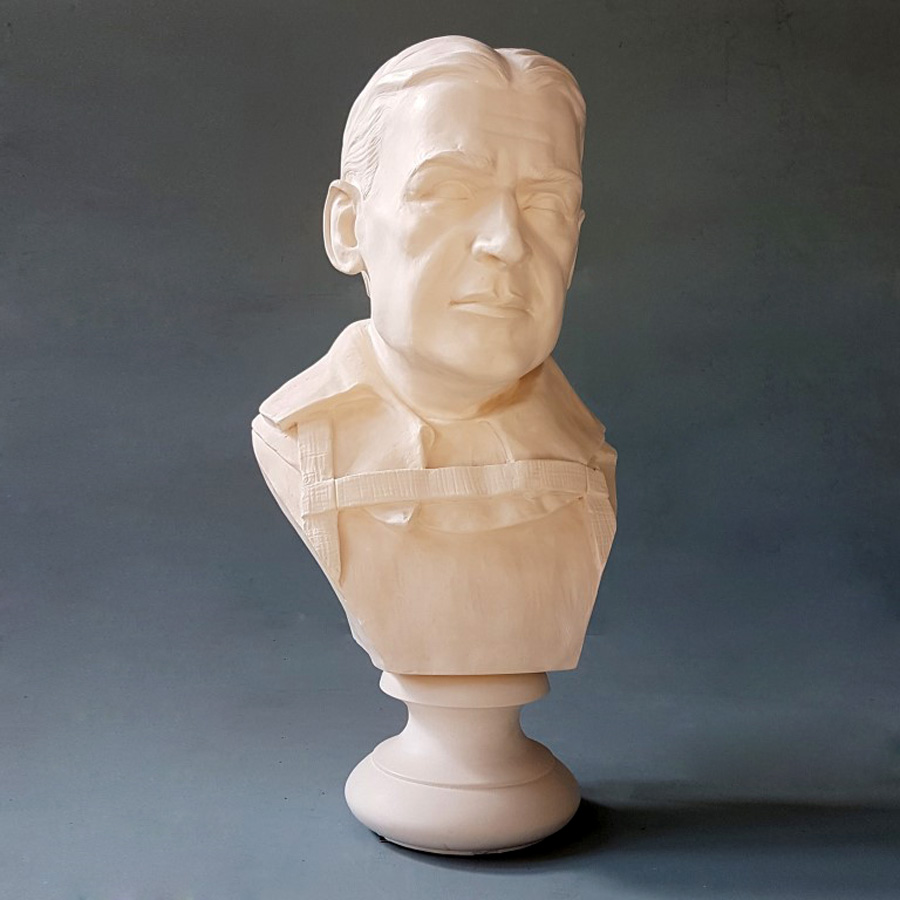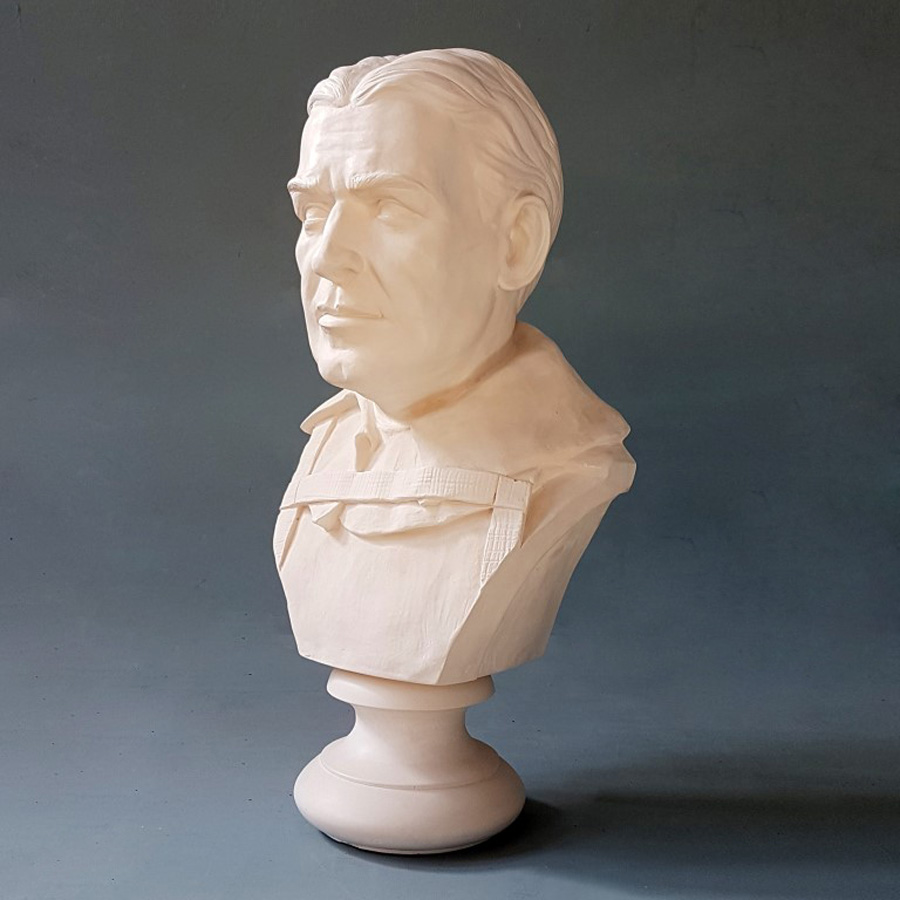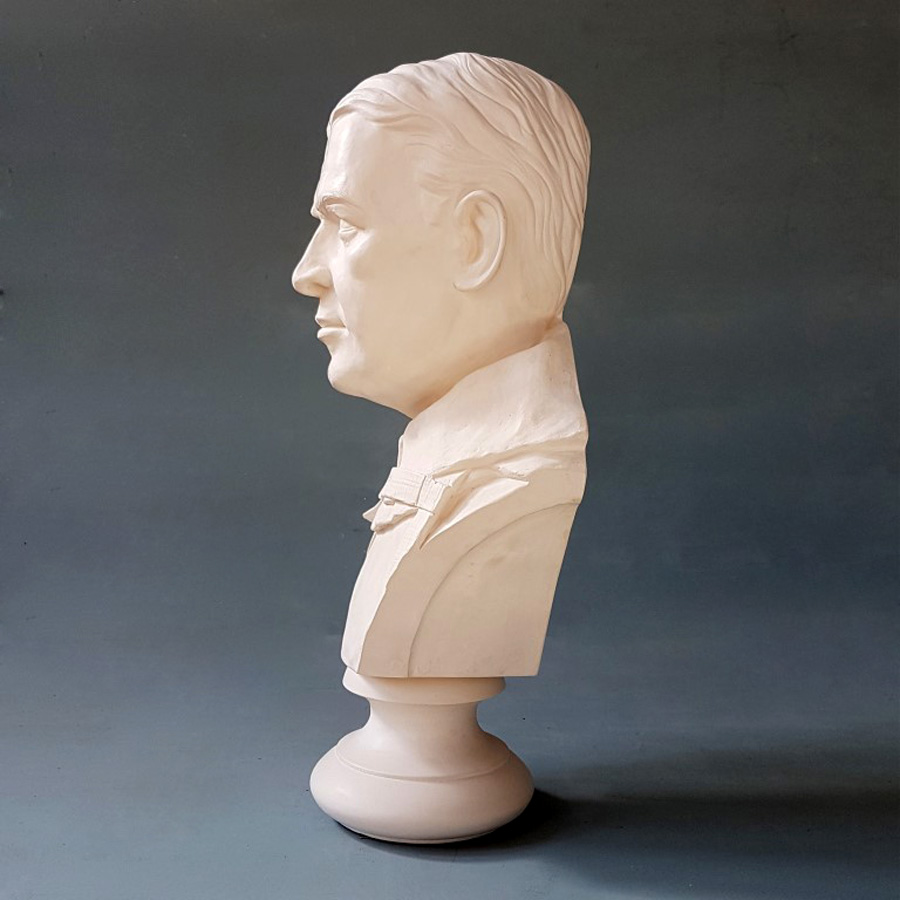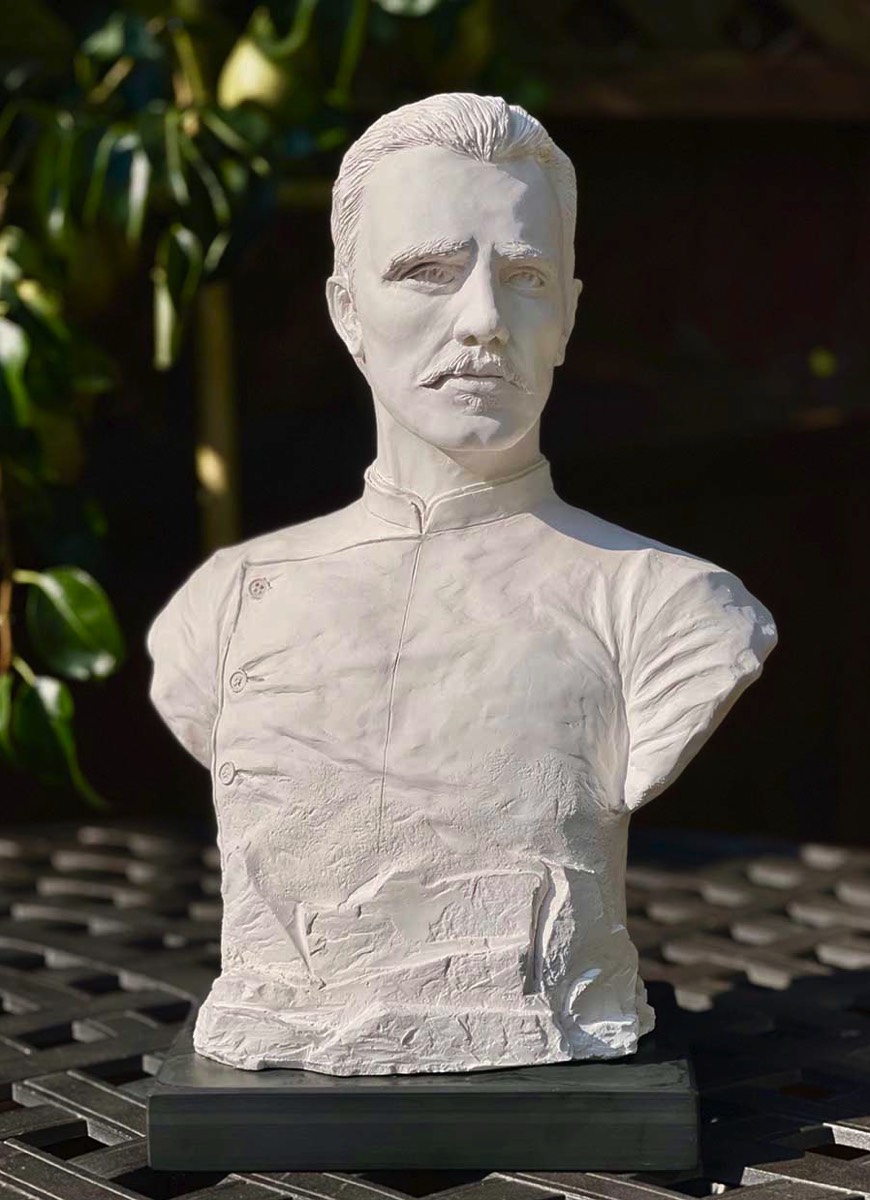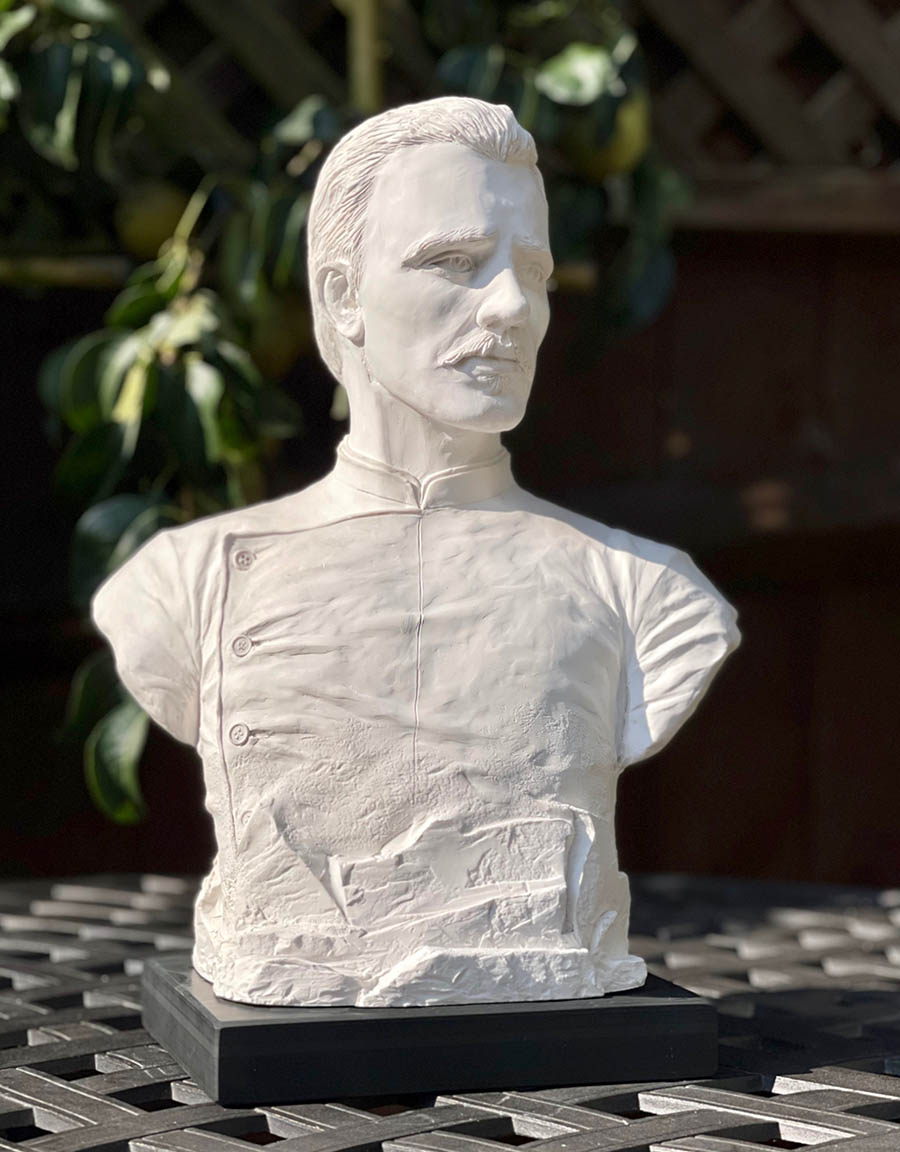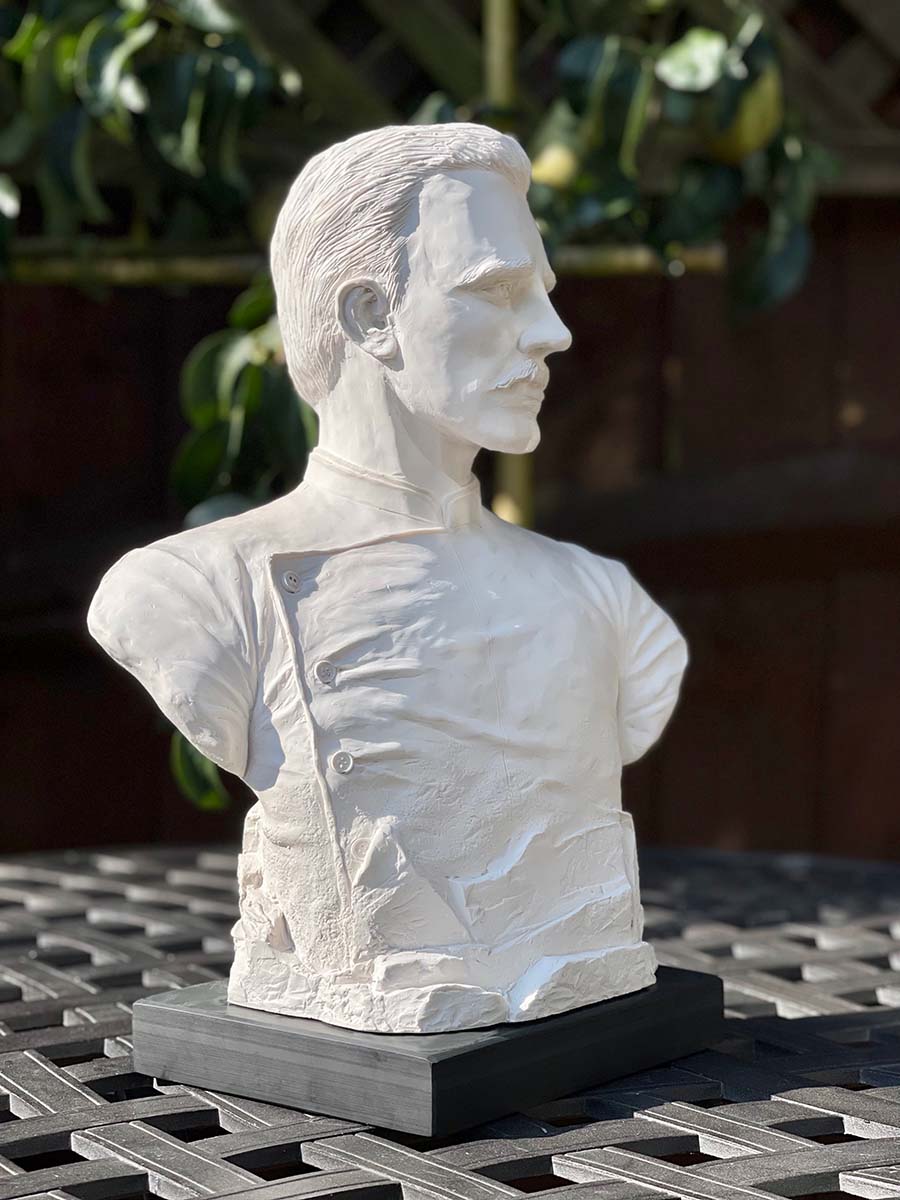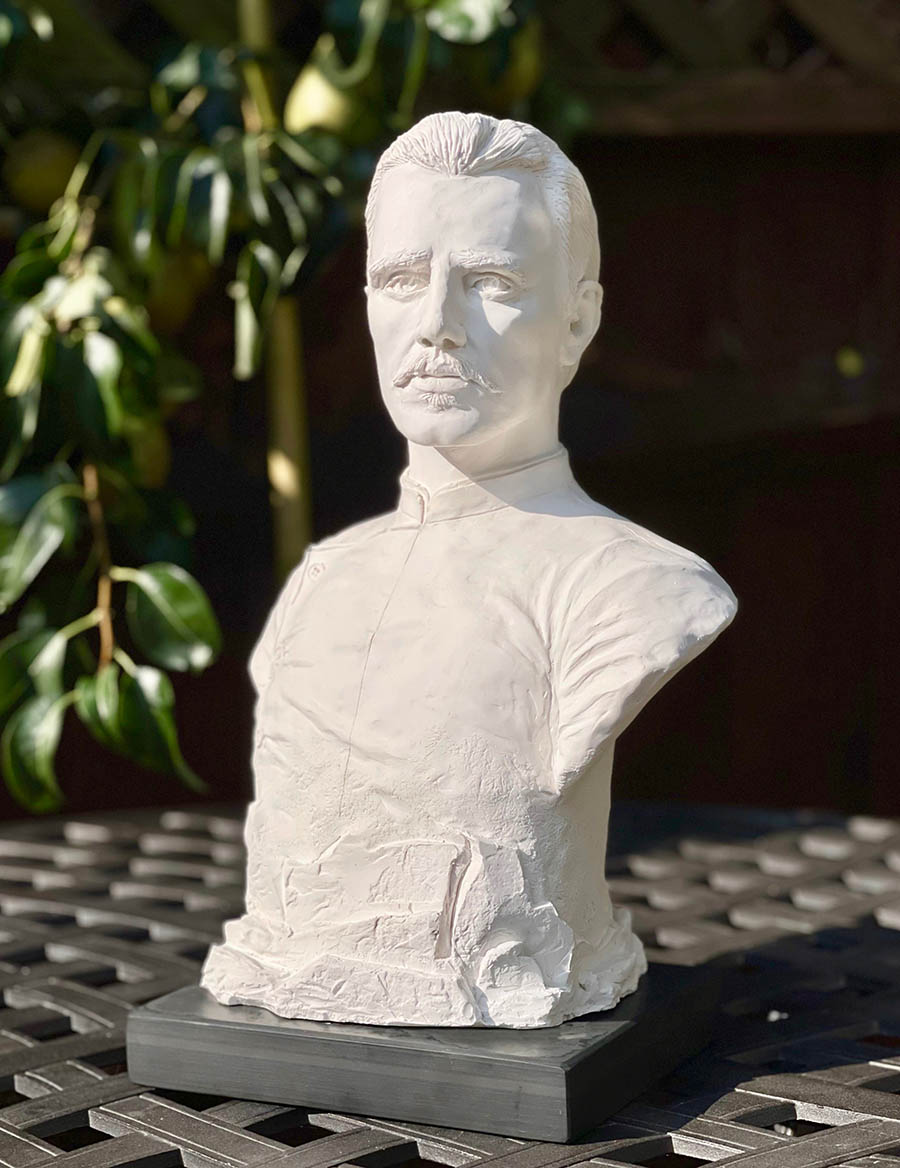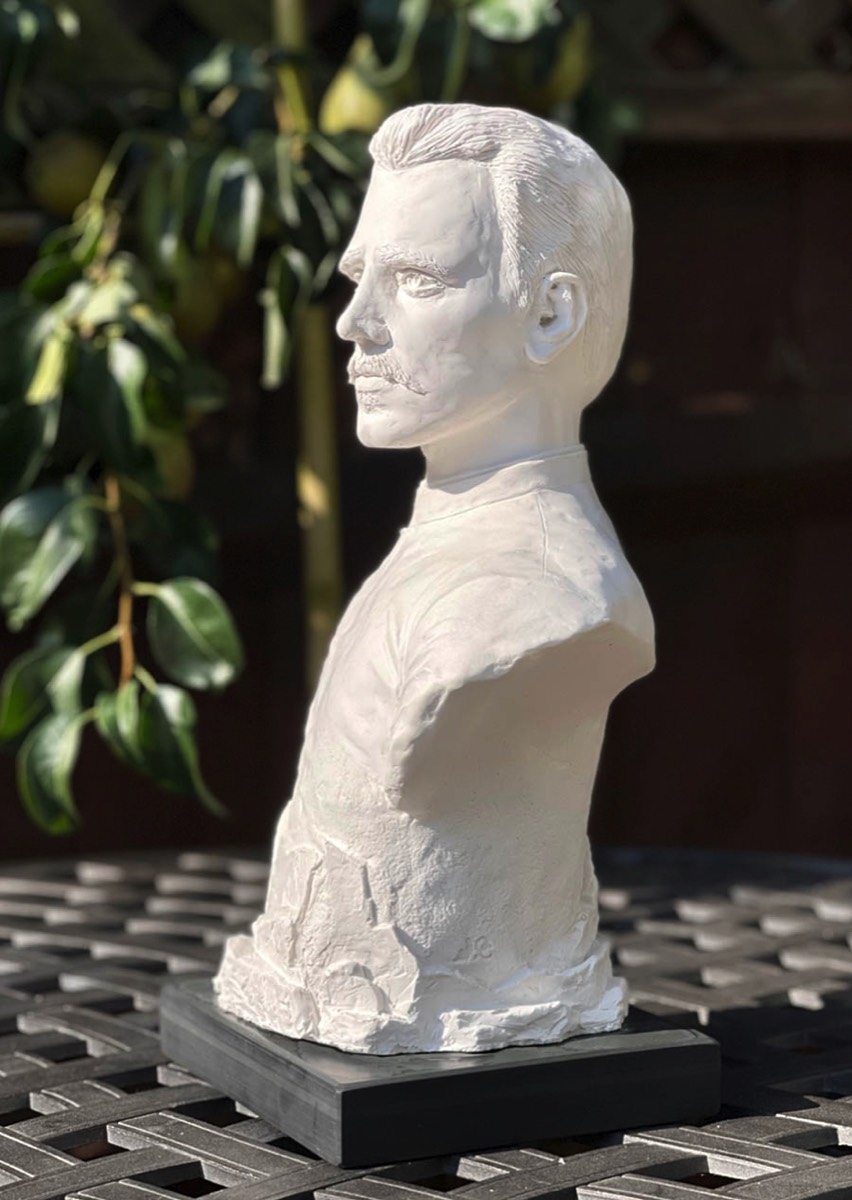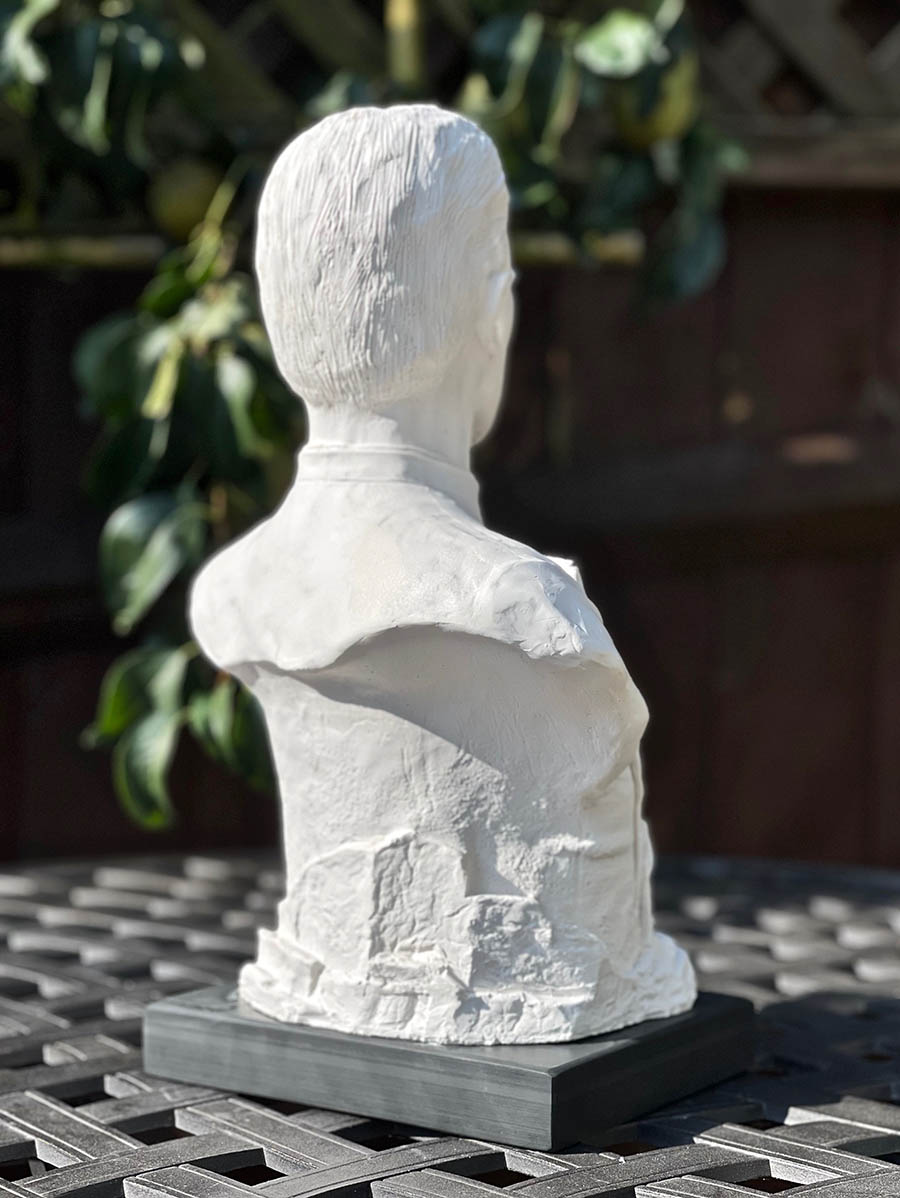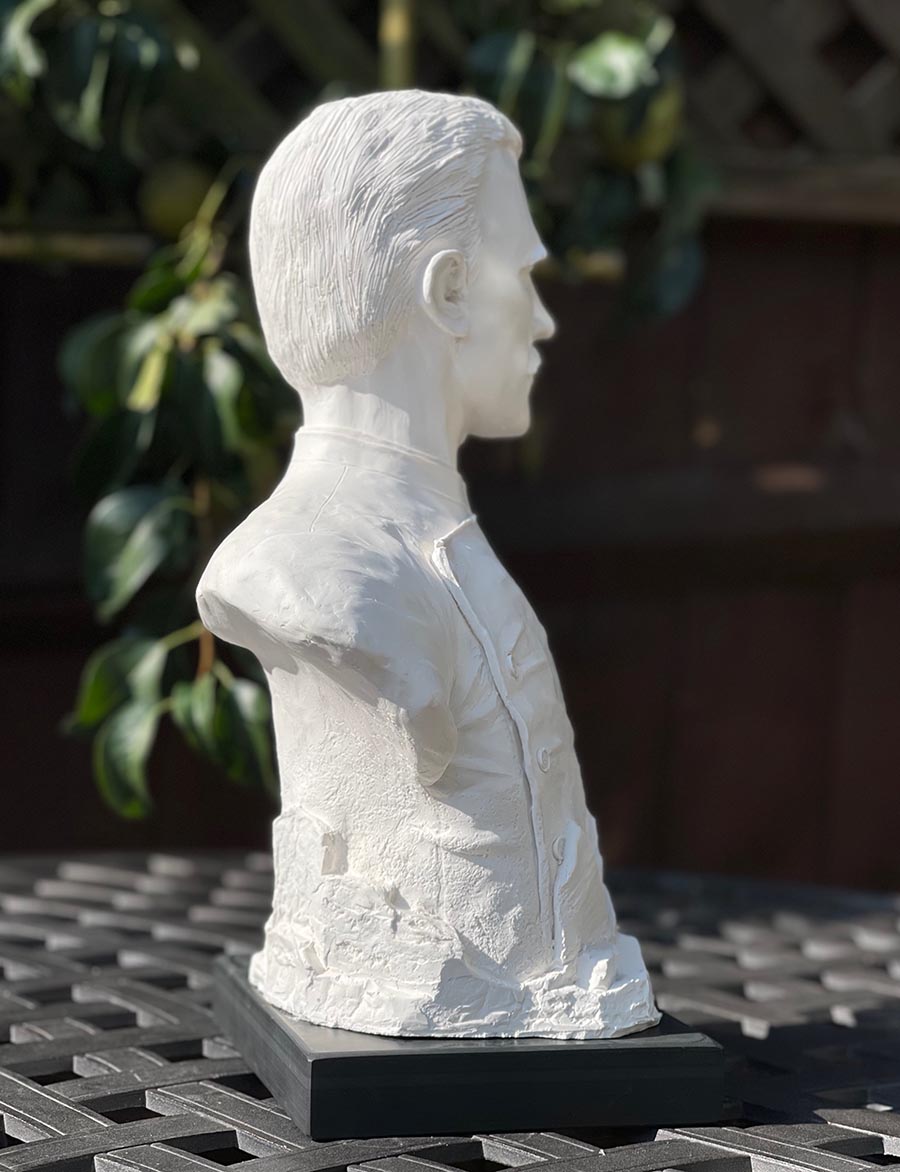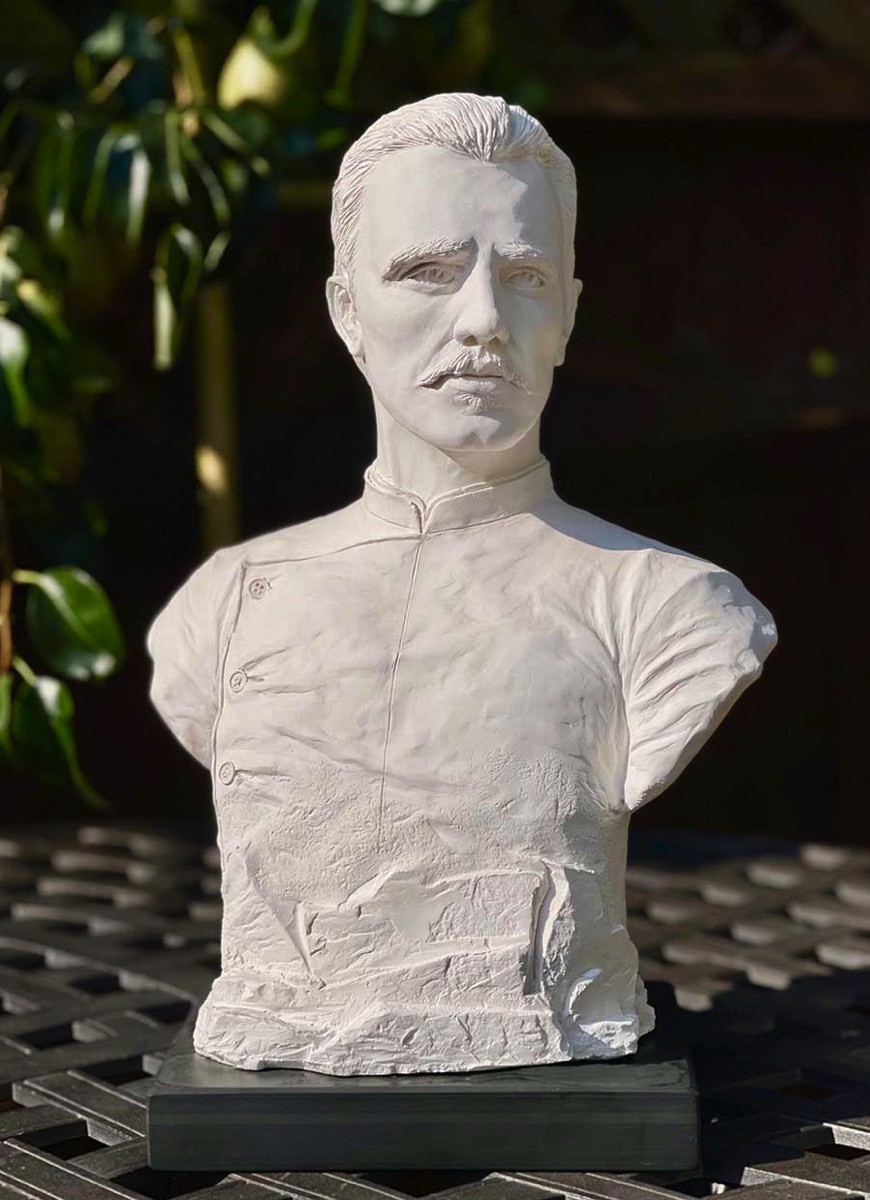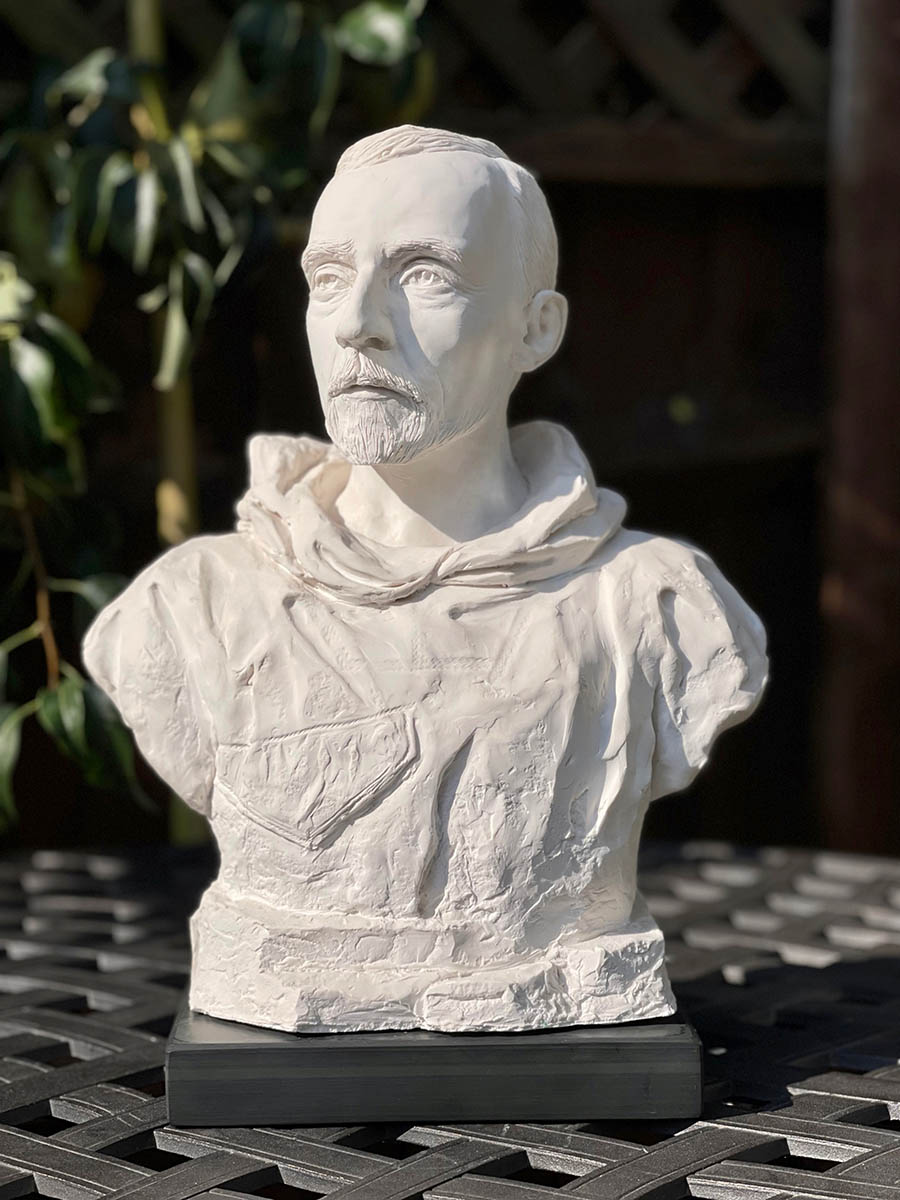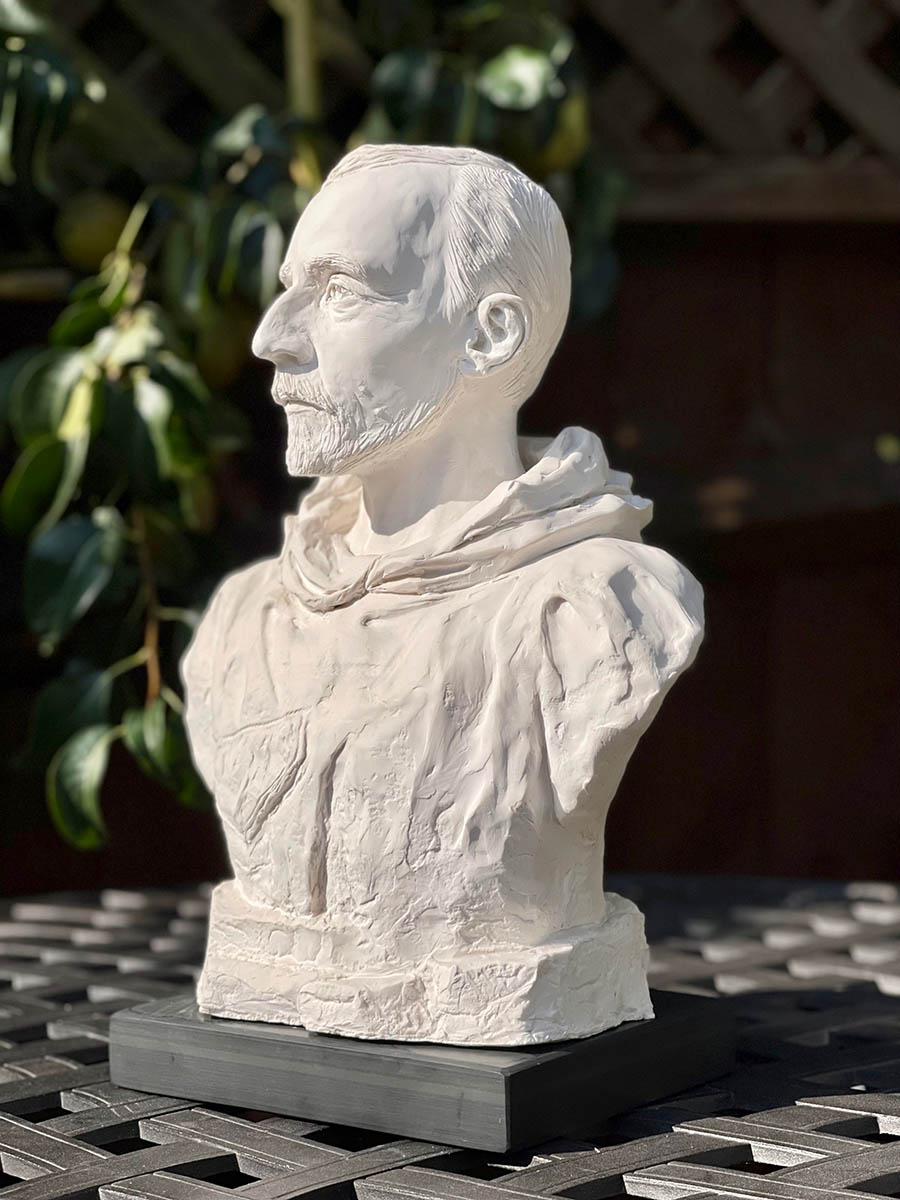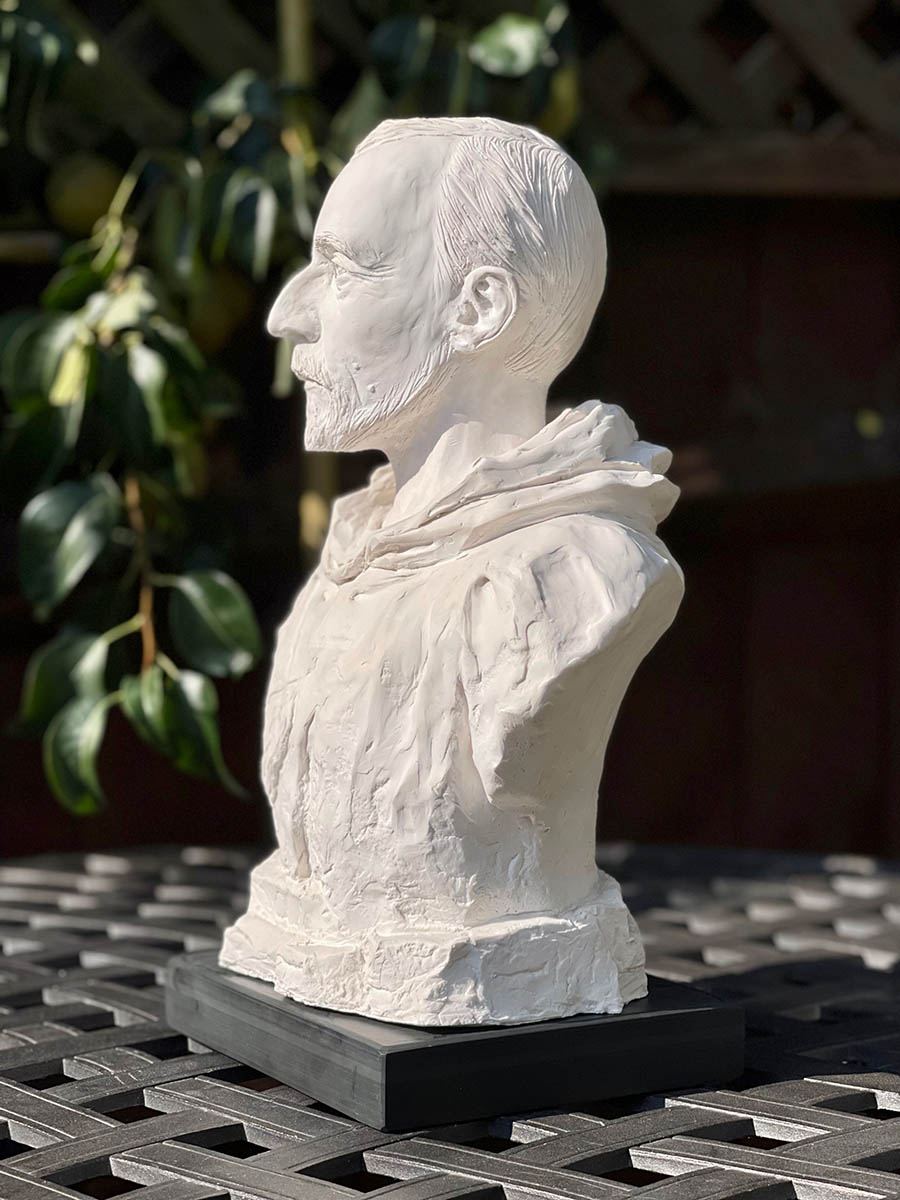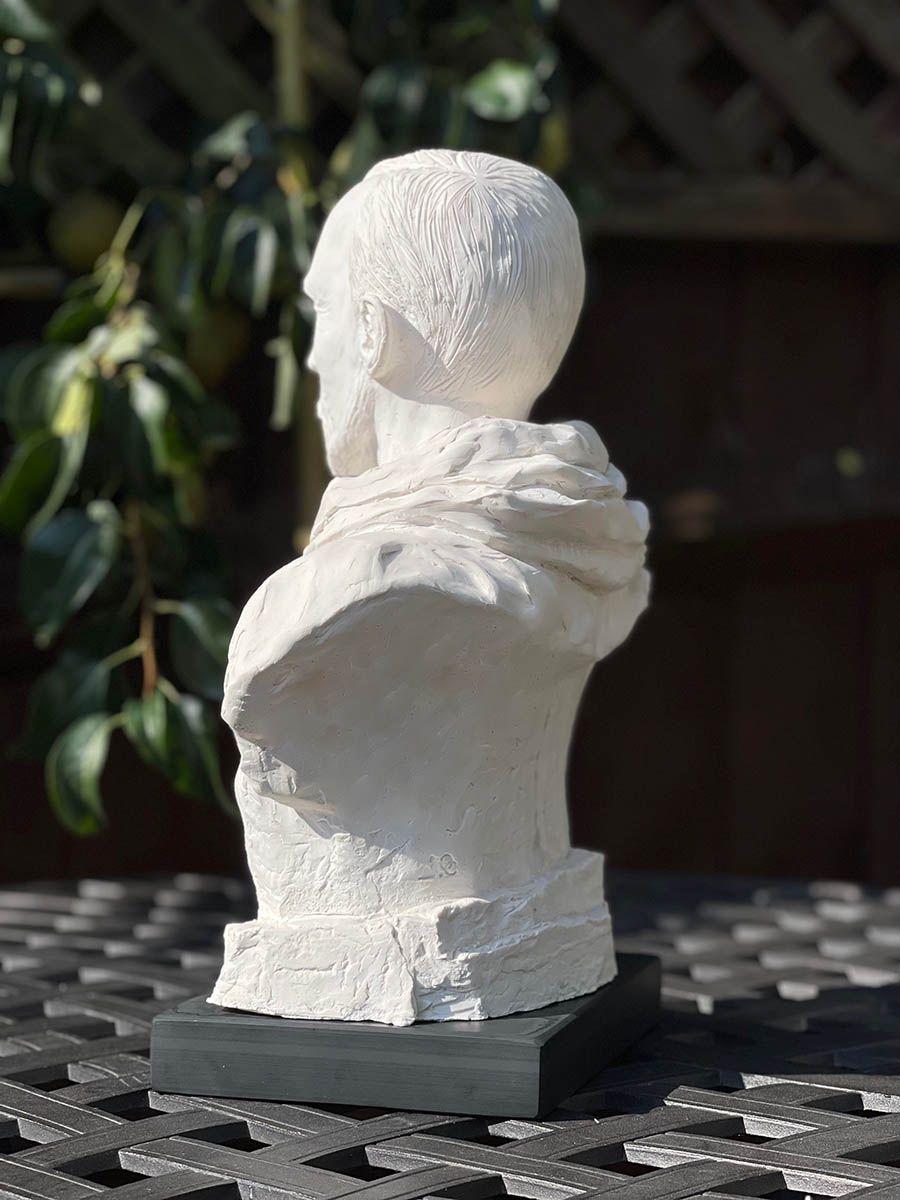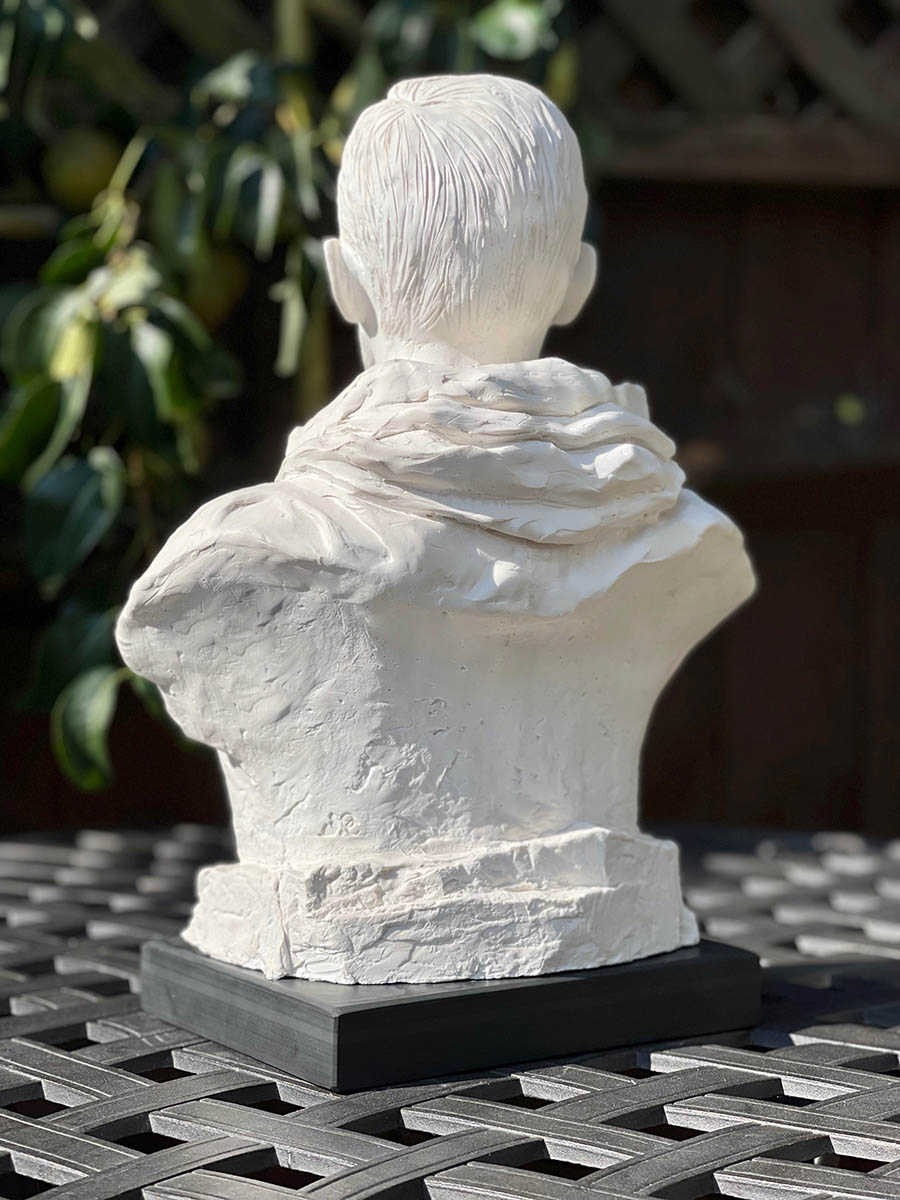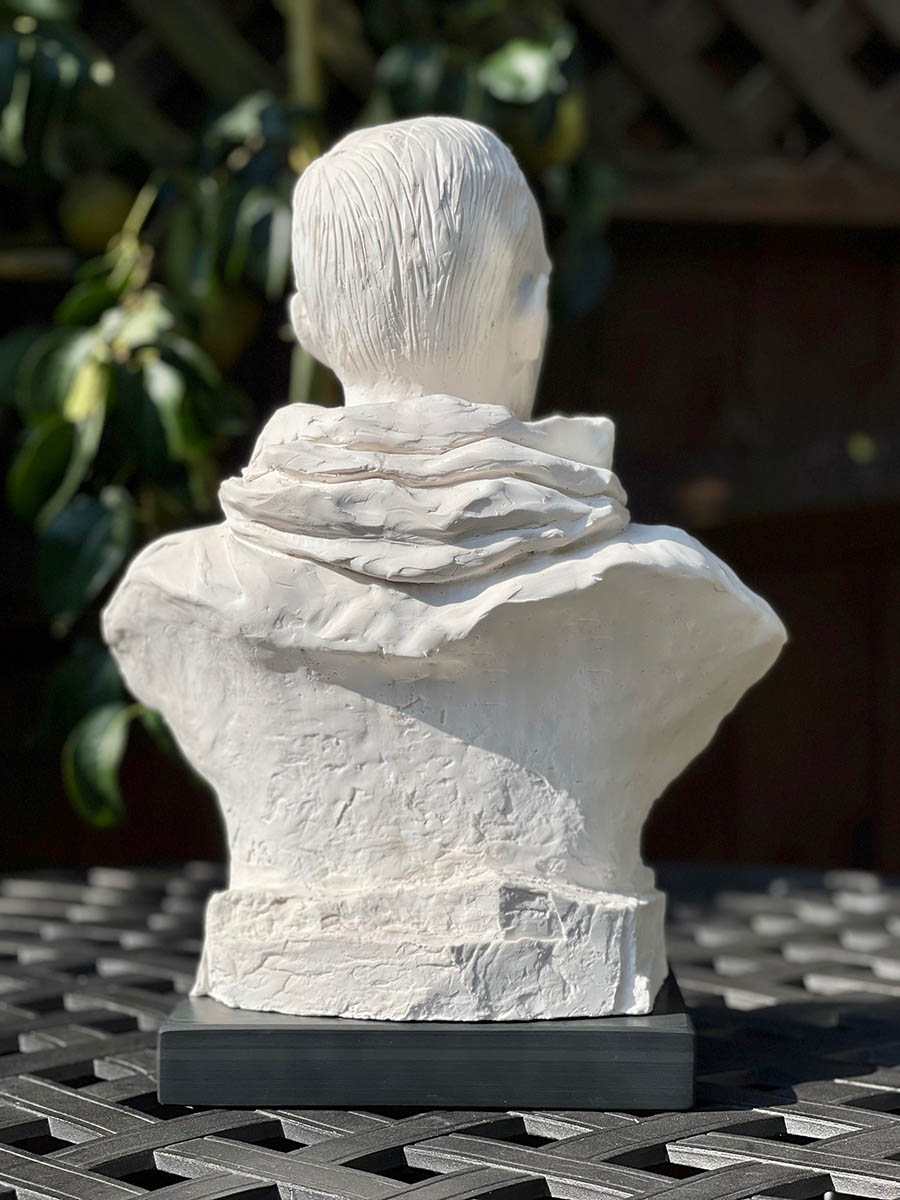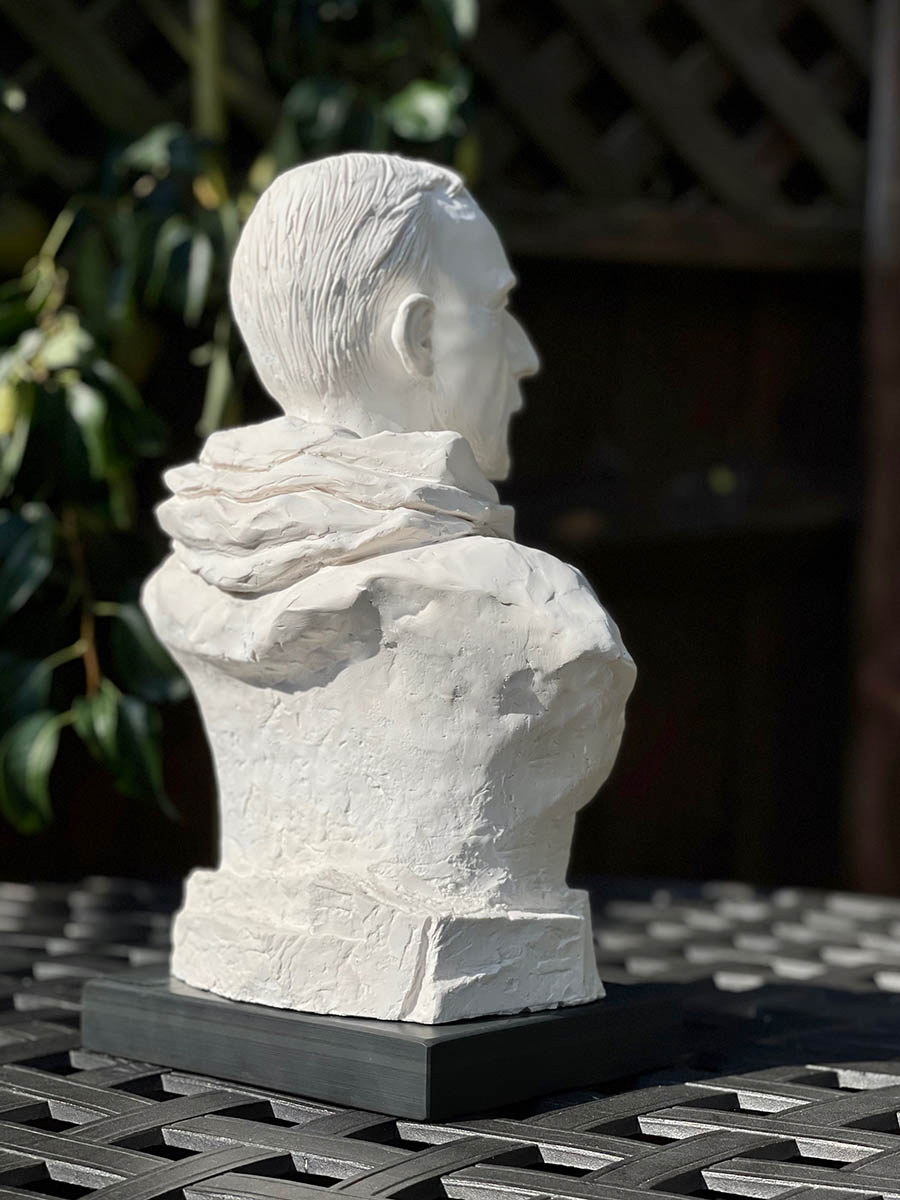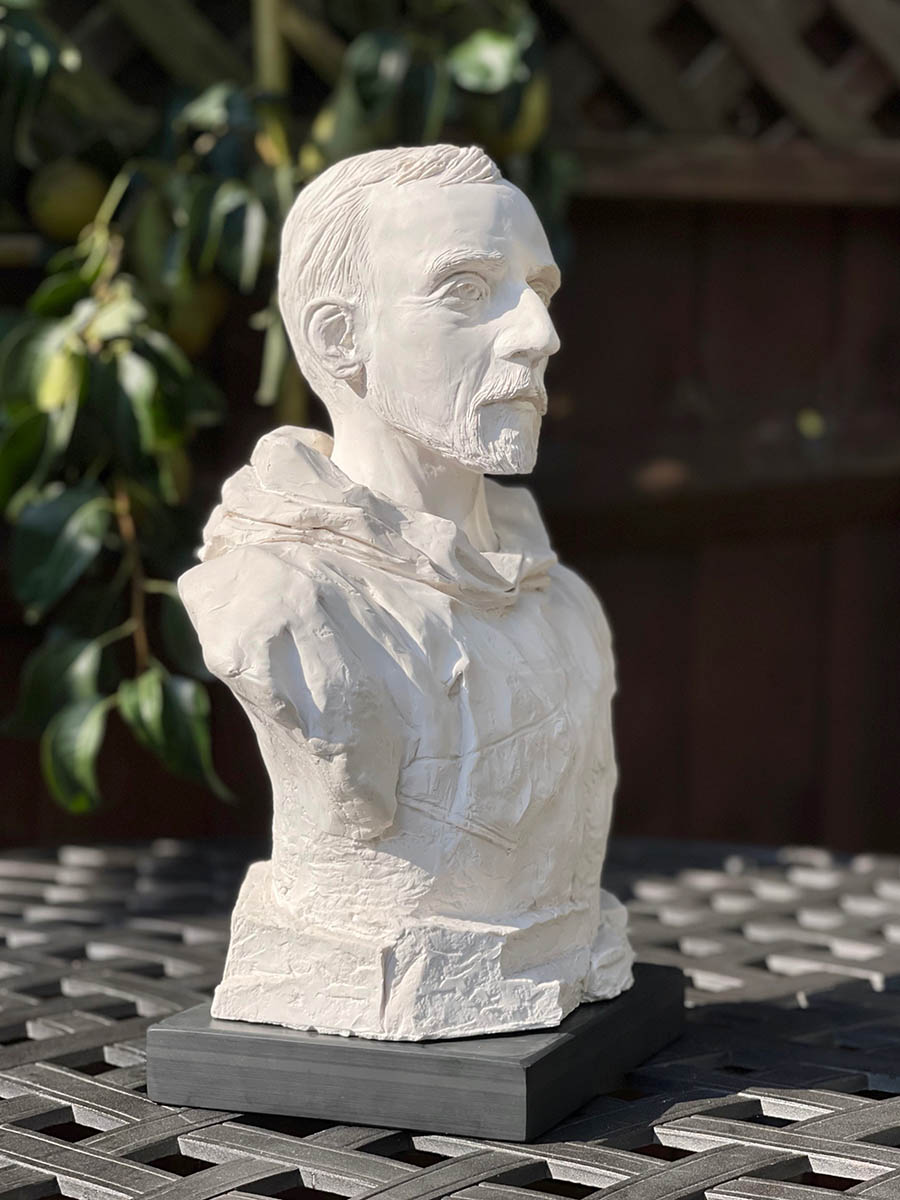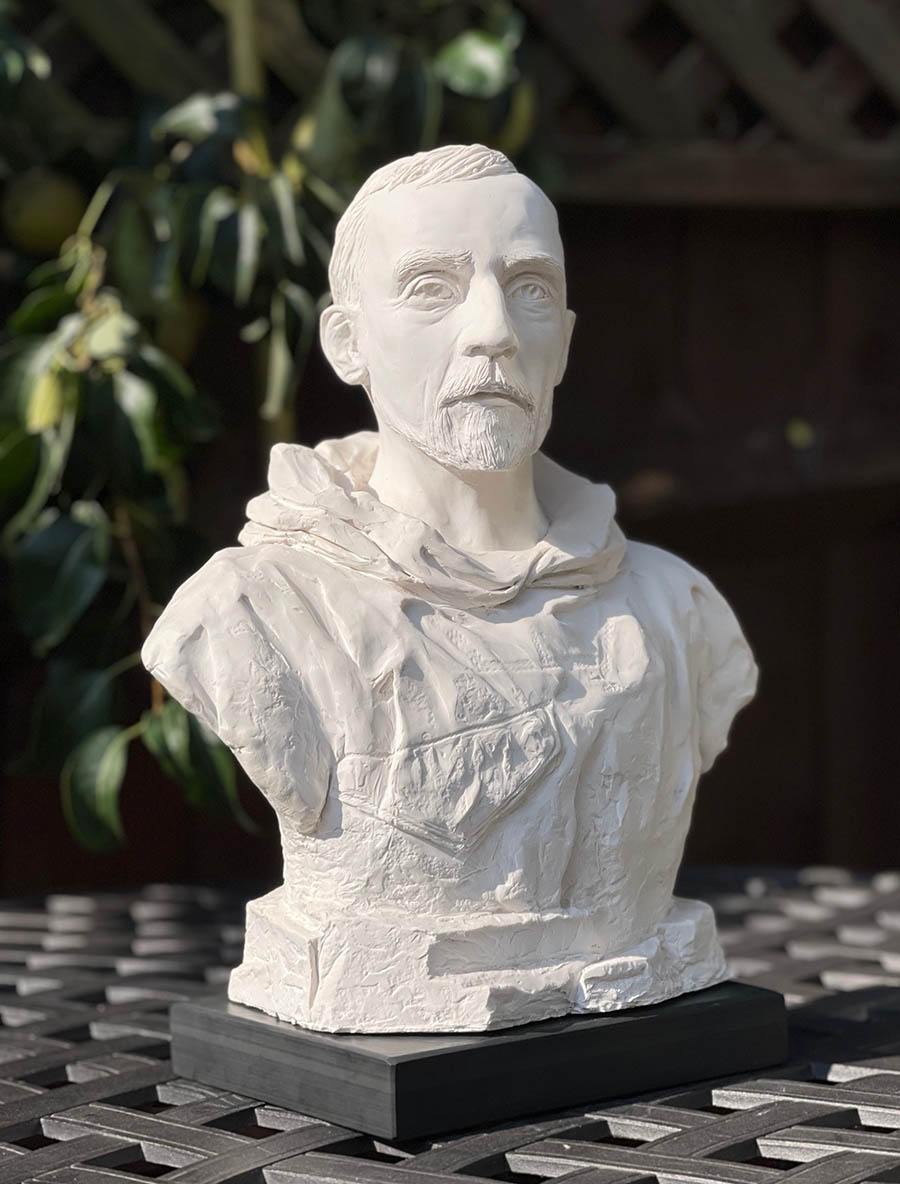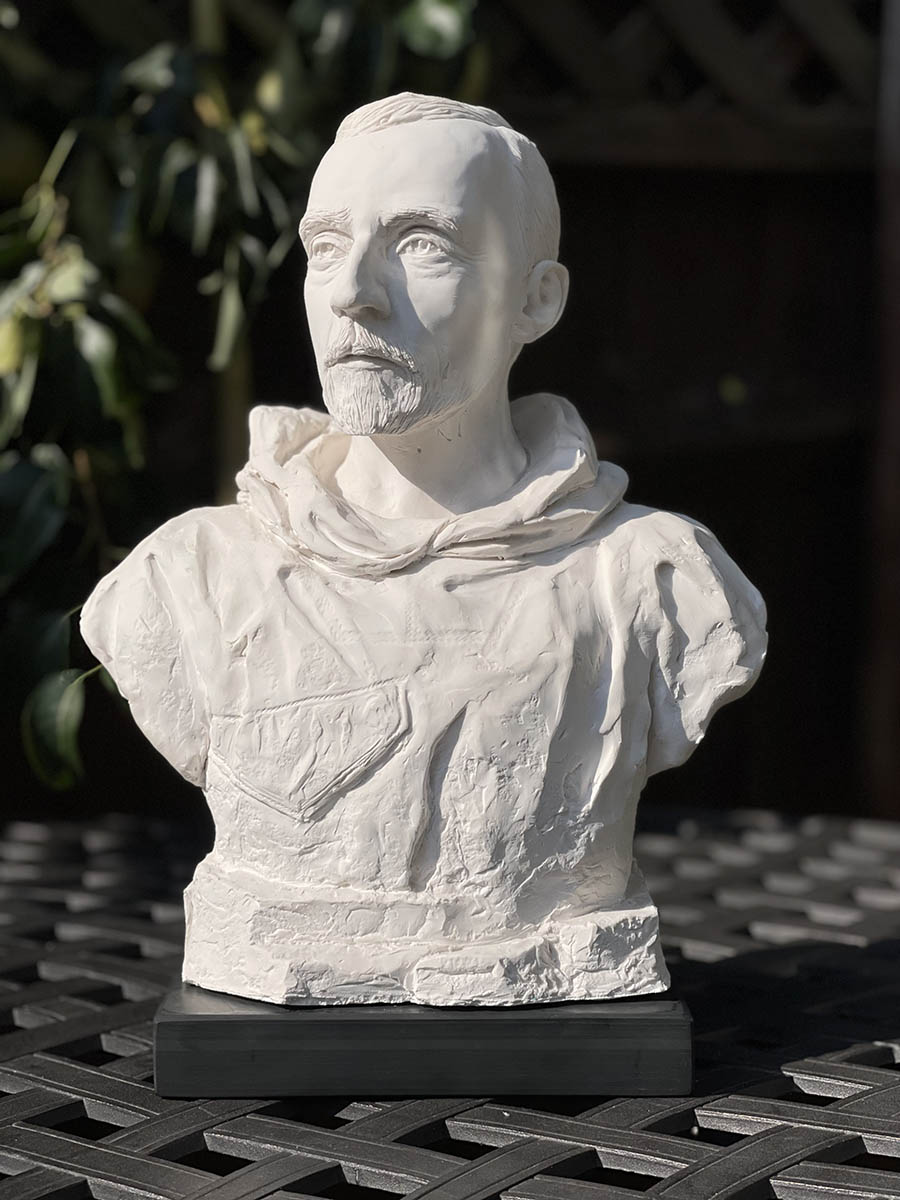
Polar Explorers
Norwegian, Irish & British
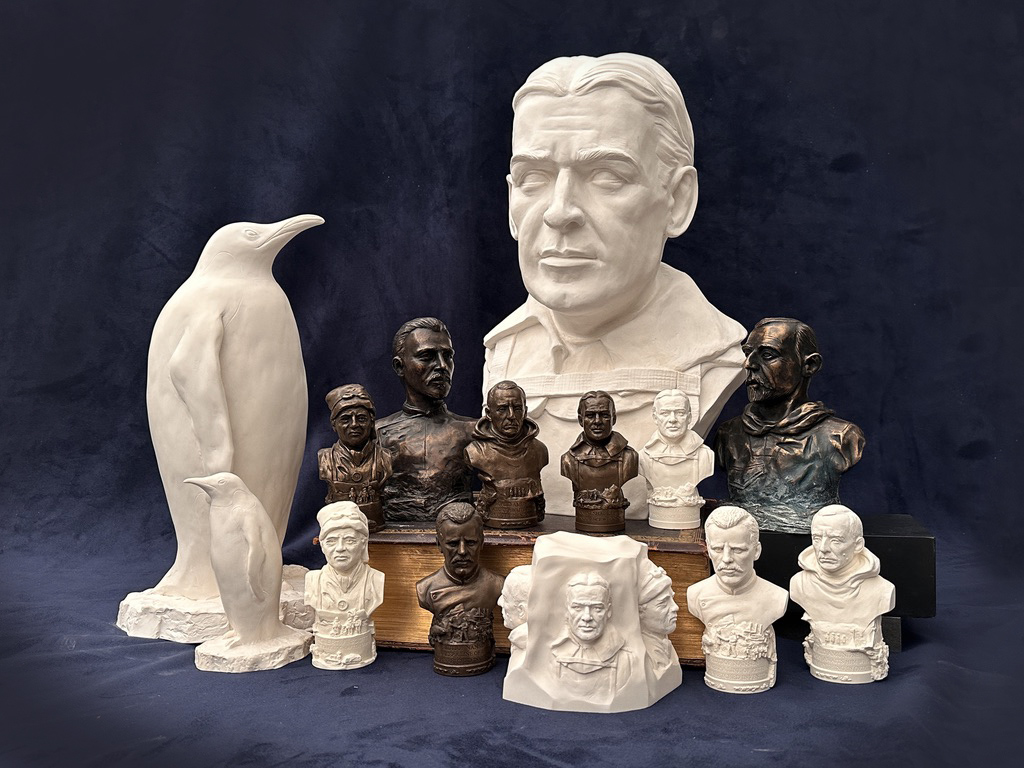
Ernest Shackleton
Irish Polar Explorer, 150th Anniversary
15th February 2024
Click on the image to enlarge.
15.02.1874 - 05.01.1922
Plaster
Ernest Shackleton is synonymous with Antarctic exploration and leadership.
He overcame unimaginable odds bringing home every man safely. Shackleton is celebrated as an iconic leader showing determination, courage and endurance.
The etch around the base reads:
"BY ENDURANCE WE CONQUER"
Height: 130mm
Width: 70mm
Depth: 35mm
Click on the image to enlarge.
15.02.1874 - 05.01.1922
Bronze Gilt
Ernest Shackleton is synonymous with Antarctic exploration and leadership.
The etch around the base reads:
"BY ENDURANCE WE CONQUER"
Height: 130mm
Width: 70mm
Depth: 35mm
Roald Amundsen
16.07.1872 - 06.1928
Plaster
was a Norwegian explorer of polar regions. He was a key figure of the period known as the Heroic Age of Antarctic Exploration.
The etch around the base reads: "VICTORY AWAITS HIM WHO HAS EVERYTHING IN ORDER"
Height: 132mm
Width: 78mm
Depth: 40mm
Click on the image to enlarge.
Roald Amundsen
16.07.1872 - 06.1928
Bronze Gilt
was a Norwegian explorer of polar regions. He was a key figure of the period known as the Heroic Age of Antarctic Exploration.
The etch around the base reads: "VICTORY AWAITS HIM WHO HAS EVERYTHING IN ORDER"
Height: 132mm
Width: 78mm
Depth: 40mm
Fridtjof Nansen
10.10.1861 - 13.05.1930
Is synonymous with Antarctic exploration and leadership. Later on in life the humanitarian and scholar received the Noble Price.
The etch around the base reads: "NEVER LEAVE A LINE OF RETREAT, IT IS A WRETCHED INVENTION"
Height: 135mm
Width: 75mm
Depth: 40mm
Click on the image to enlarge.
Fridtjof Nansen
10.10.1861 - 13.05.1930
Bronze Gilt
Is synonymous with Antarctic exploration and leadership. Later on in life the humanitarian and scholar received the Noble Price.
The etch around the base reads: "NEVER LEAVE A LINE OF RETREAT, IT IS A WRETCHED INVENTION"
Height: 135mm
Width: 75mm
Depth: 40mm
Robert Falcon Scott
06.06.1868 – 2903 1912
Plaster
Captain Robert Falcon Scott CVO was a British Royal Navy officer and explorer who led two expeditions to the Antarctic regions: the Discovery expedition of 1901–04 and the Terra Nova expedition of 1910–13
The Base
There are objects around the base of the bust depicting events and themes from Scott's fatal polar expedition. We have included the ponies, his ship, a motorised metal Sledge, a map of Antartica.
The etch around the base reads:
"FOR GOD'S SAKE, LOOK AFTER OUR PEOPLE"
Height: 133mm
Width: 65mm
Depth: 40mm
Click on the image to enlarge.
06.06.1868 – 2903 1912
Bronze Gilt
Captain Robert Falcon Scott CVO was a British Royal Navy officer and explorer who led two expeditions to the Antarctic regions: the Discovery expedition of 1901–04 and the Terra Nova expedition of 1910–13
The Base
There are objects around the base of the bust depicting events and themes from Scott's fatal polar expedition. We have included the ponies, his ship, a motorised metal Sledge, a map of Antartica.
The etch around the base reads:
"FOR GOD'S SAKE, LOOK AFTER OUR PEOPLE"
Height: 133mm
Width: 65mm
Depth: 40mm
Click on the image to enlarge.
This is a polar ornament incorporating the foremost polar explorers from Norway, the UK and Ireland. Roald Amundsen, Fridtjof Nansen, Ernest Shackleton and Robert Falcon Scott.
Here combined in a block resembling an iceberg as a desk ornament and paper weight.
Height approx 100mm
Diameter approx 100mm varying
Weight 0.5 kg
Click on the image to enlarge.
Life Size Bust in Plaster
Shackleton was an Anglo-Irish Antarctic explorer, best known for leading the 'Endurance' expedition of 1914-16.
Ernest Henry Shackleton was born on 15 February 1874 in County Kildare, Ireland. His father was a doctor.
The family moved to London where Shackleton was educated.
Rejecting his father's wish that he become a doctor, he joined the merchant navy when he was 16 and qualified as a master mariner in 1898.
He travelled widely but was keen to explore the poles.
With Scott and one other, Shackleton trekked towards the South Pole in extremely difficult conditions, getting closer to the Pole than anyone had come before.
Shackleton became seriously ill and had to return home but had gained valuable experience.
Height 55cm
Weight 18kg
Please click on the image to enlarge.
Height: 15.5"
Width: 10.5"
Depth: 6.5"
Metric:
Height: 394mm
Width: 267mm
Depth: 165mm
Weight: 8.6 kg
Disclaimer:
All dimensions, weight and colouring may vary due to the natural materials used and the throughout handmade process.
Fridtjof Nansen
This sculpture was created in cooperation with the Fram Museum in Oslo.
Fridtjof Wedel-Jarlsberg Nansen
10 October 1861 – 13 May 1930) was a Norwegian polar explorer, polymath and Nobel Peace Prize laureate.
He led the team that made the first crossing of the Greenland interior in 1888, traversing the island on cross-country skis.
He won international fame after reaching a record northern latitude of 86°14′ during his Fram expedition of 1893—1896.
Although he retired from exploration after his return to Norway, his techniques of polar travel and his innovations in equipment and clothing influenced a generation of subsequent Arctic and Antarctic expeditions.
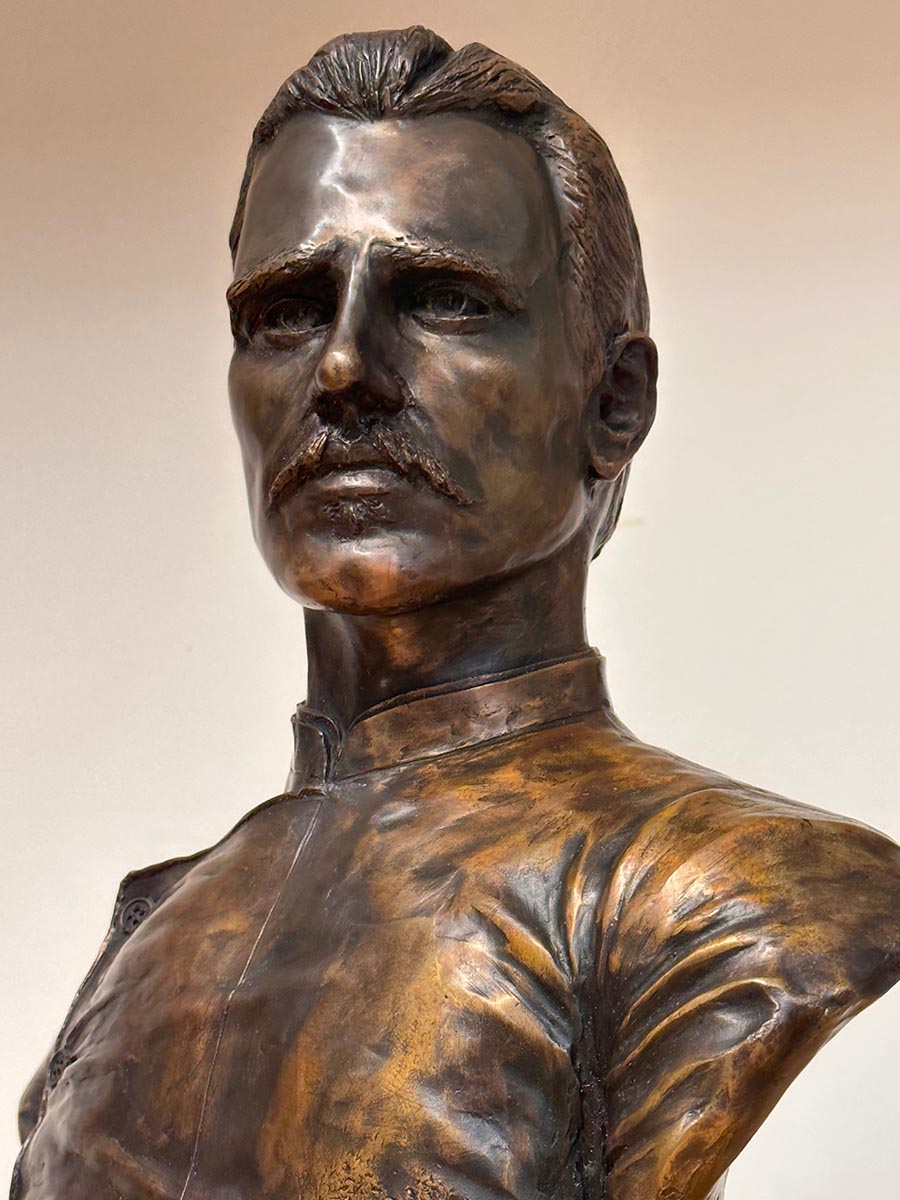
Height: 14"
Width: 11"
Depth: 6.5"
Metric:
Height: 355mm
Width: 279mm
Depth: 165mm
Weight: 12 kg
Disclaimer:
All dimensions, weight and colouring may vary due to the natural materials used and the throughout handmade process.
Fridtjof Nansen
This sculpture was created in cooperation with the Fram Museum in Oslo.
Fridtjof Wedel-Jarlsberg Nansen
10 October 1861 – 13 May 1930) was a Norwegian polar explorer, polymath and Nobel Peace Prize laureate.
He led the team that made the first crossing of the Greenland interior in 1888, traversing the island on cross-country skis.
He won international fame after reaching a record northern latitude of 86°14′ during his Fram expedition of 1893—1896.
Although he retired from exploration after his return to Norway, his techniques of polar travel and his innovations in equipment and clothing influenced a generation of subsequent Arctic and Antarctic expeditions.
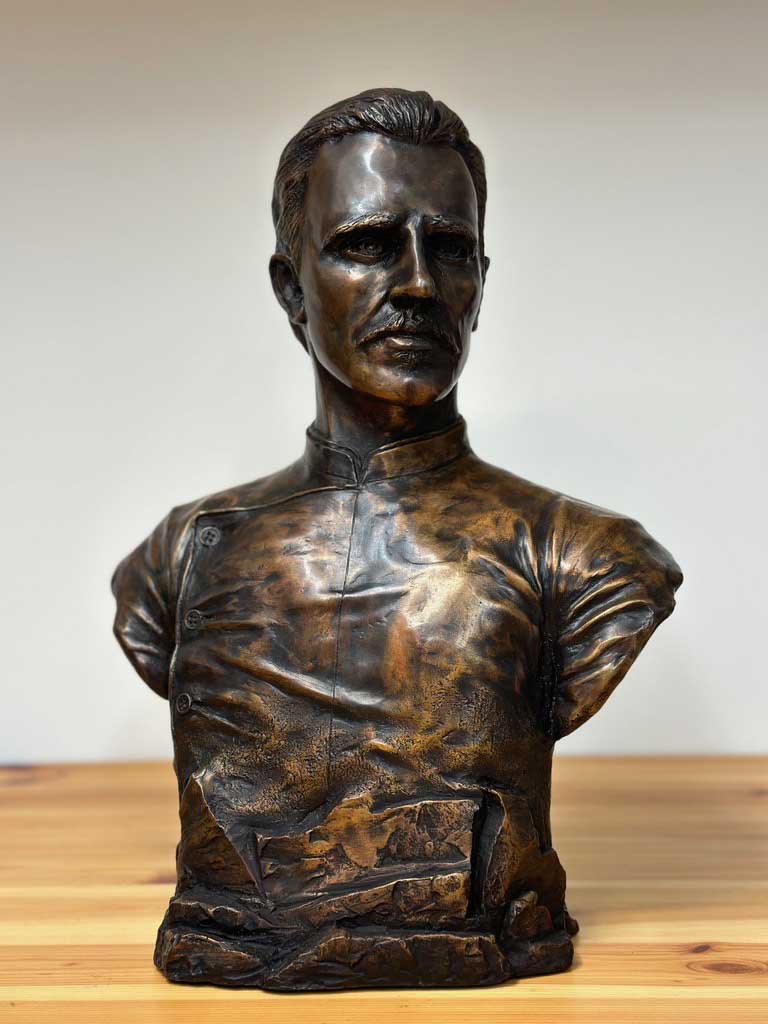

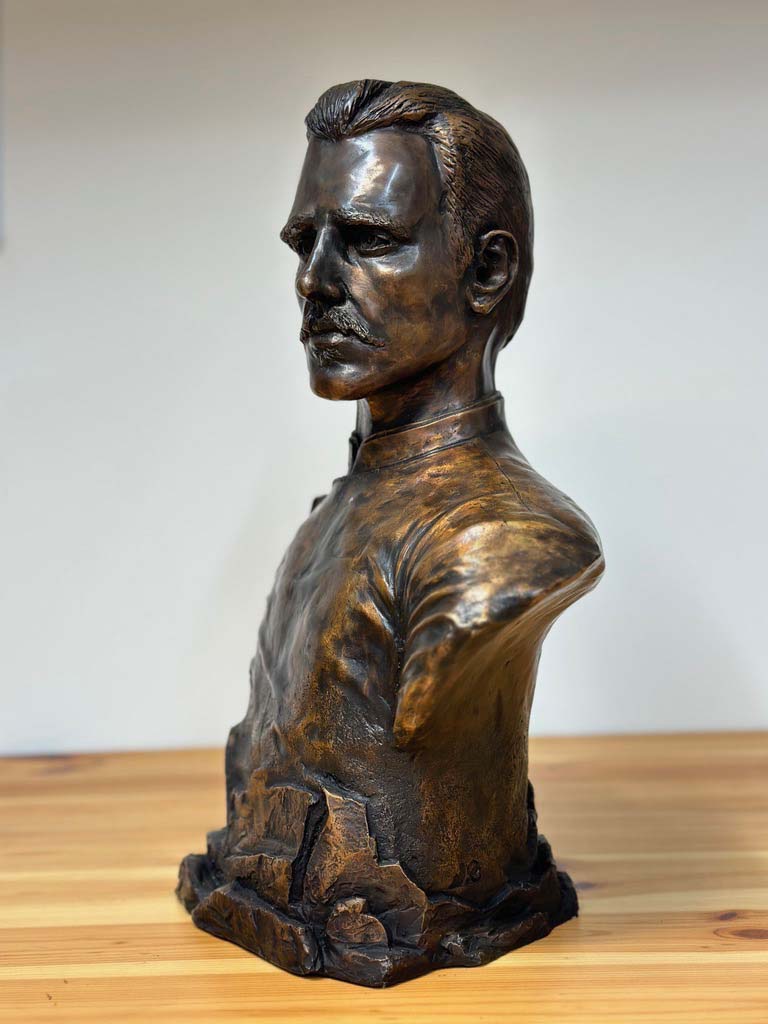
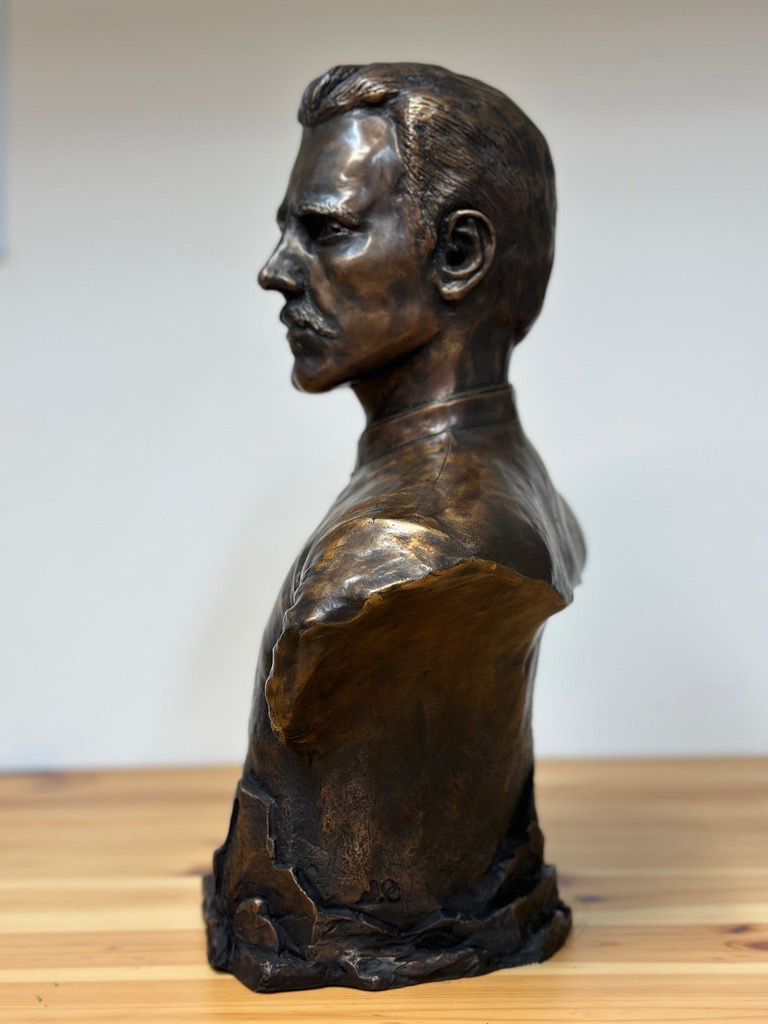
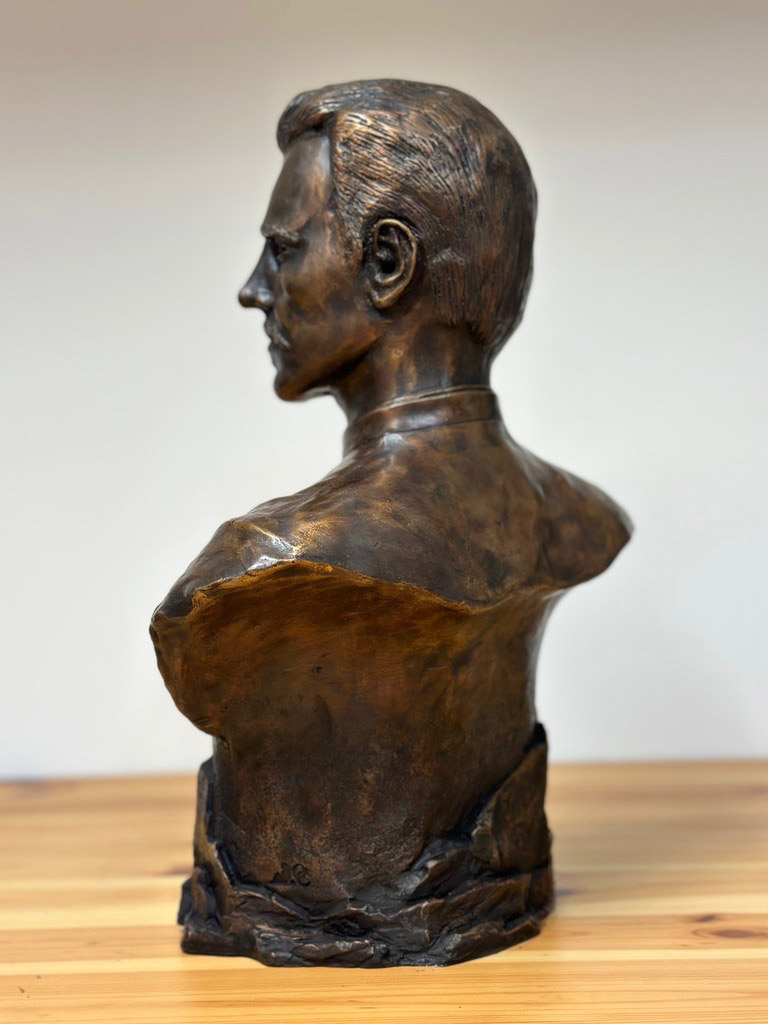
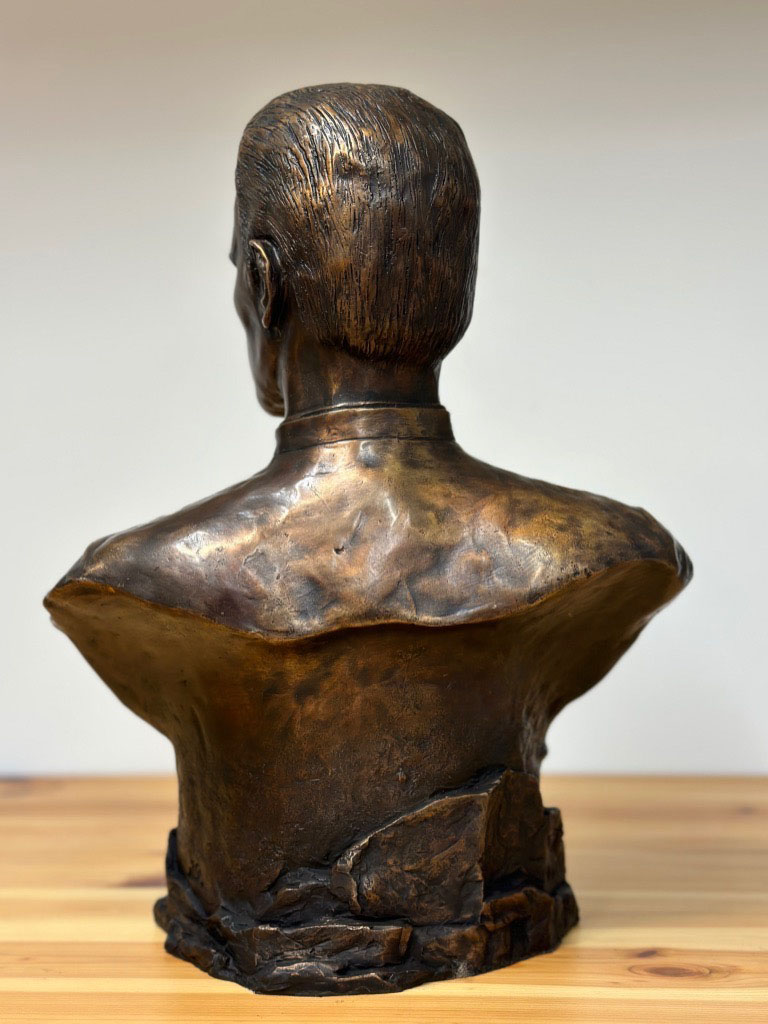
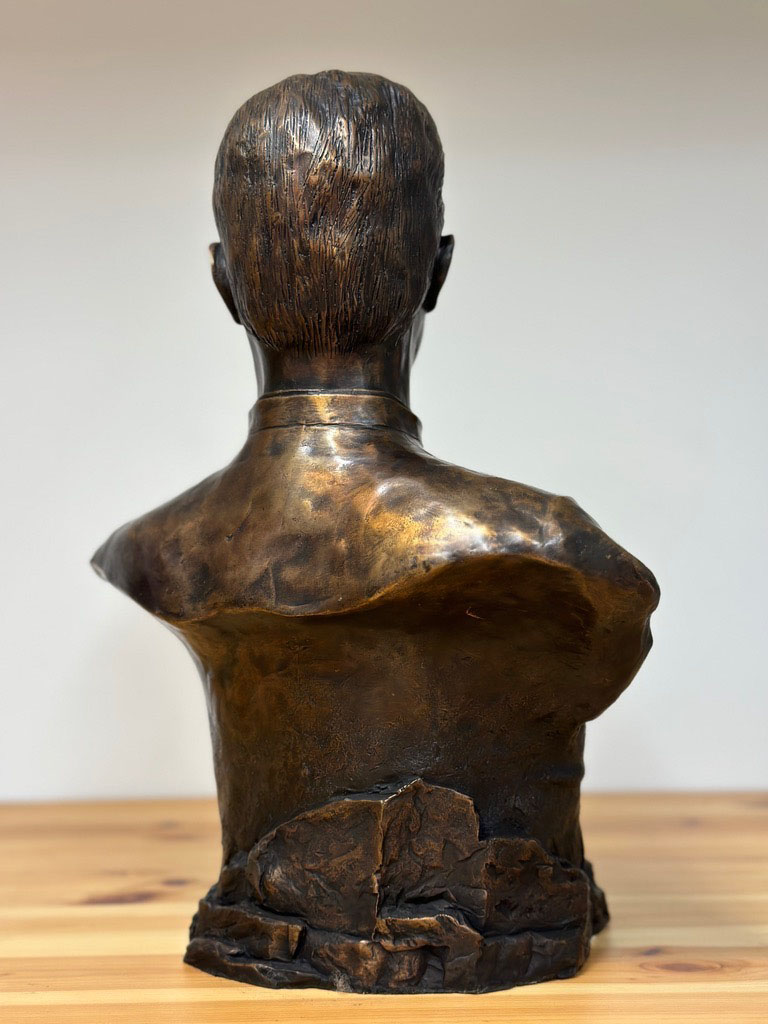
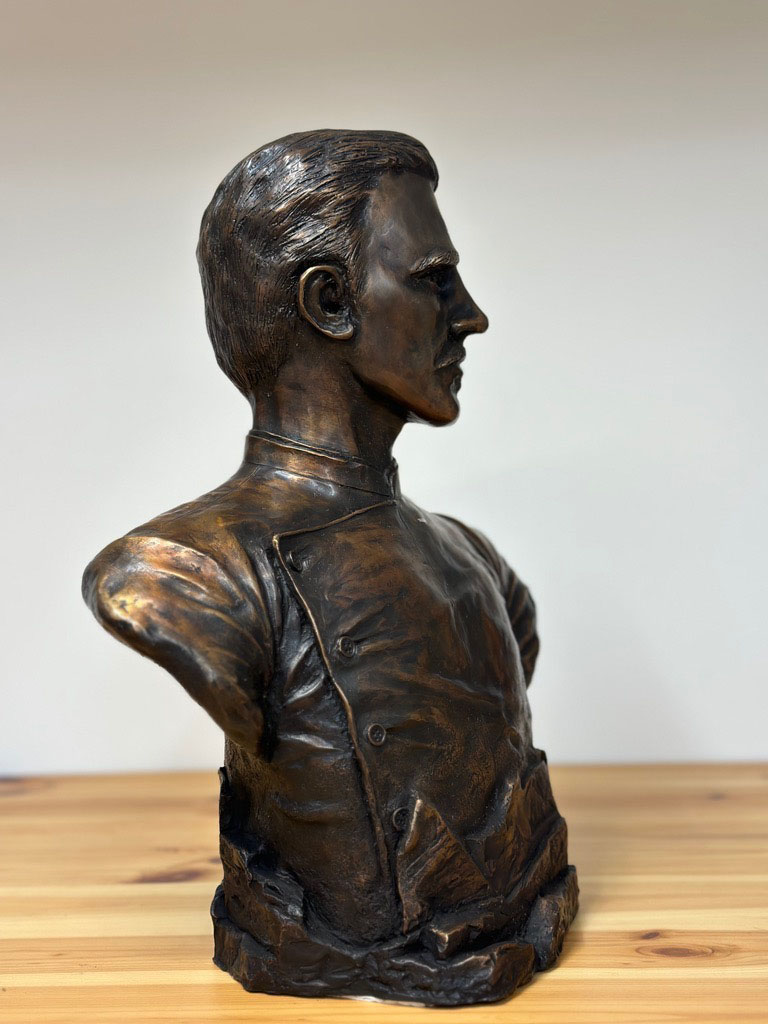
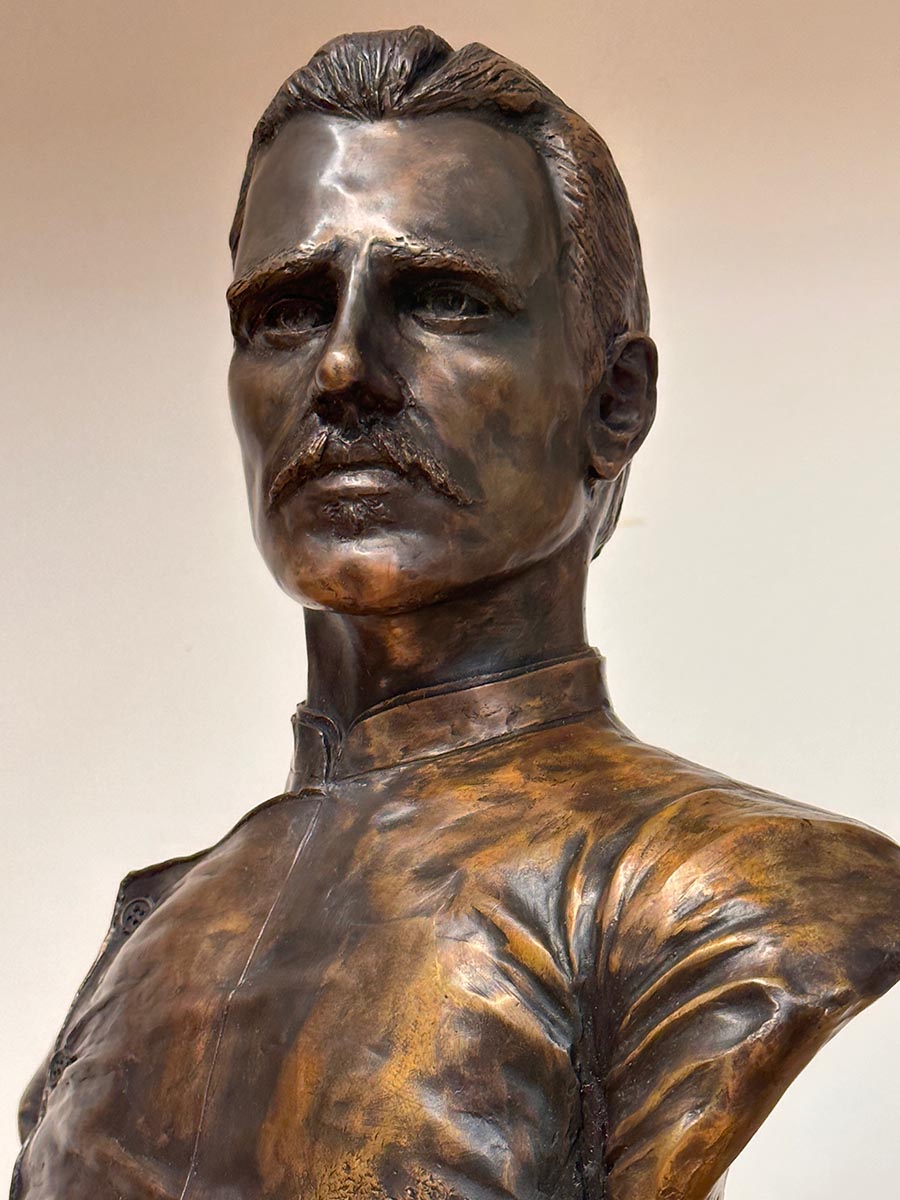
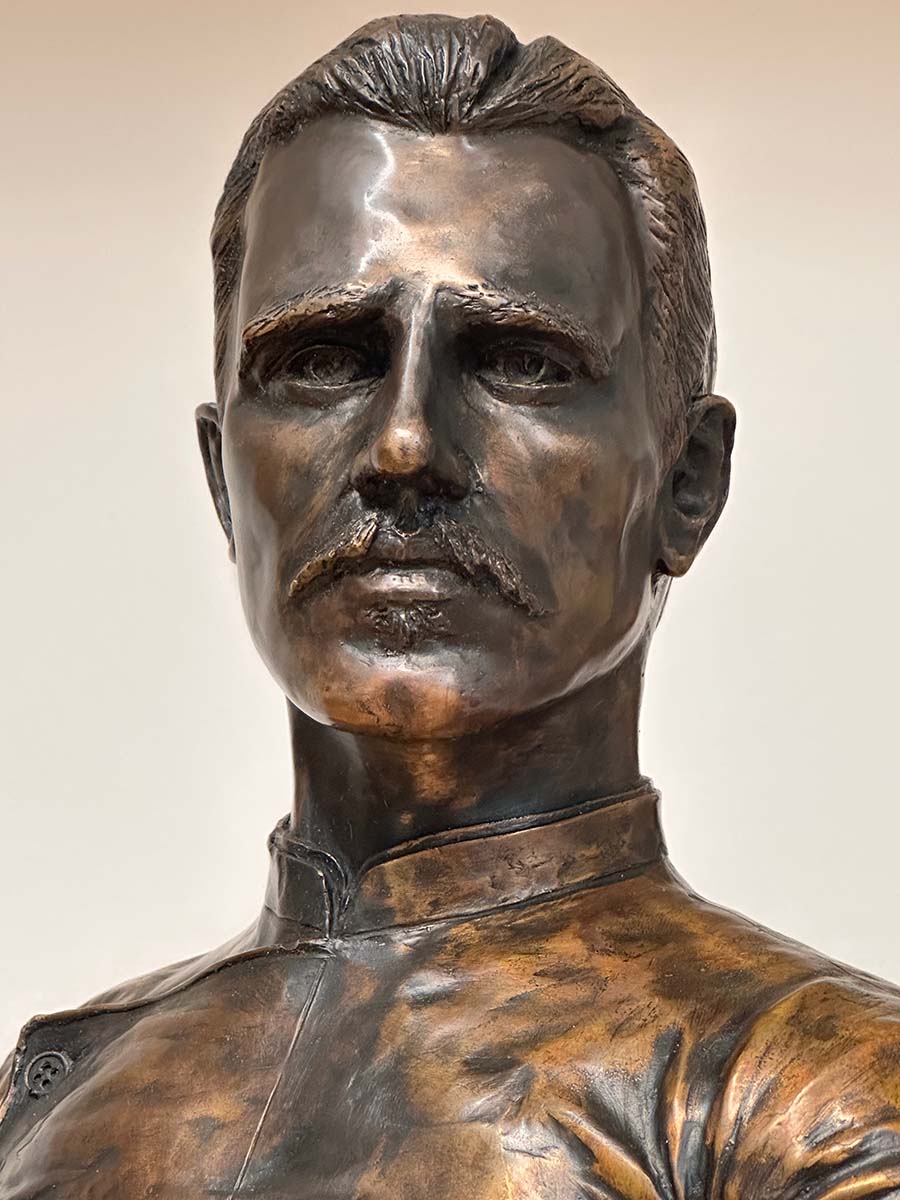
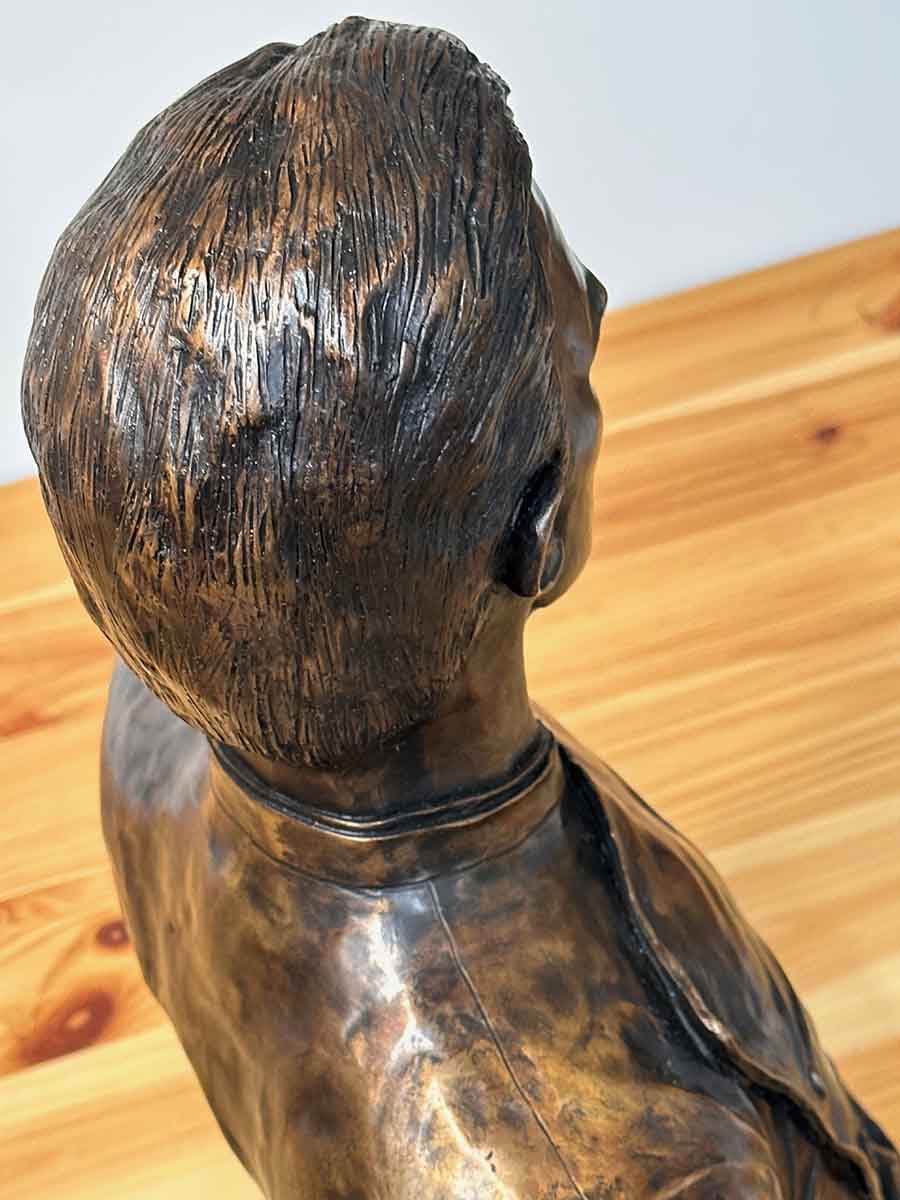
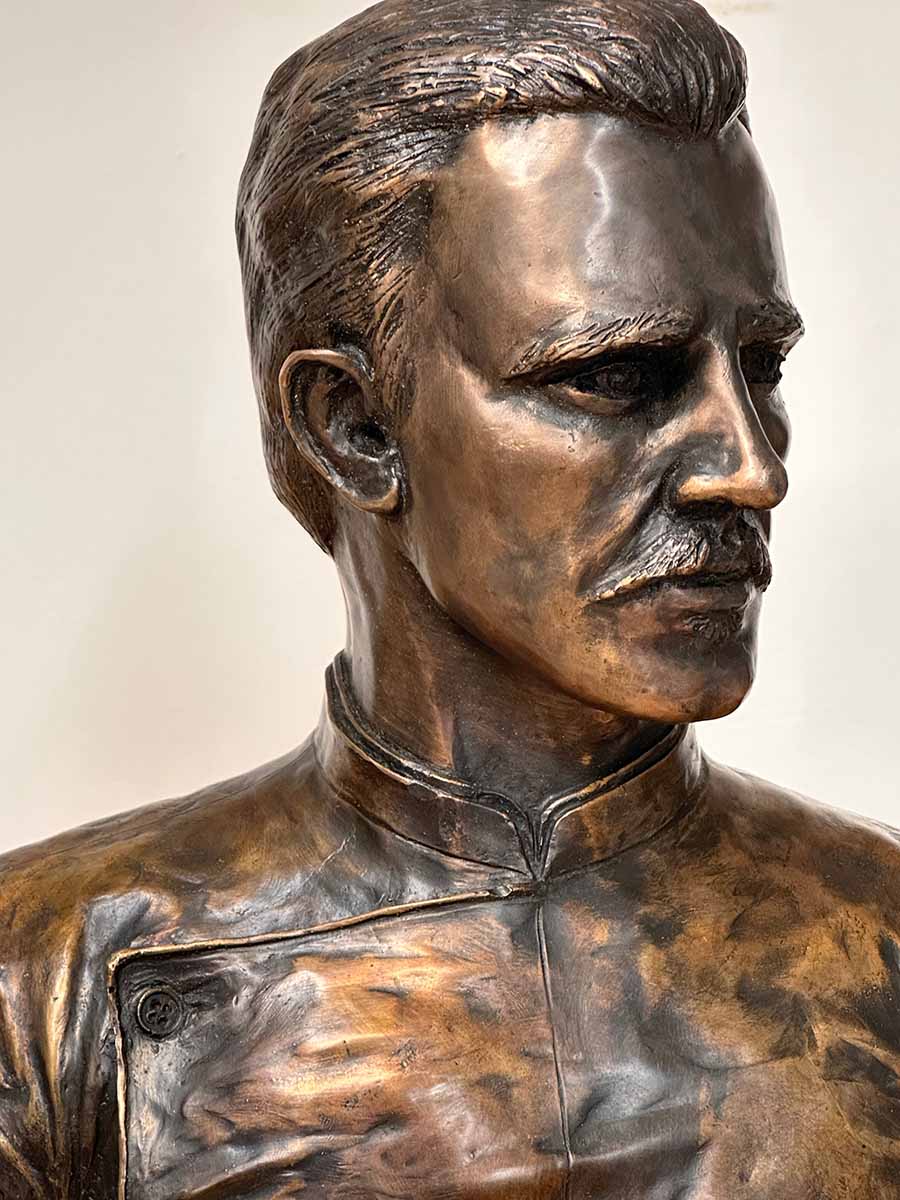

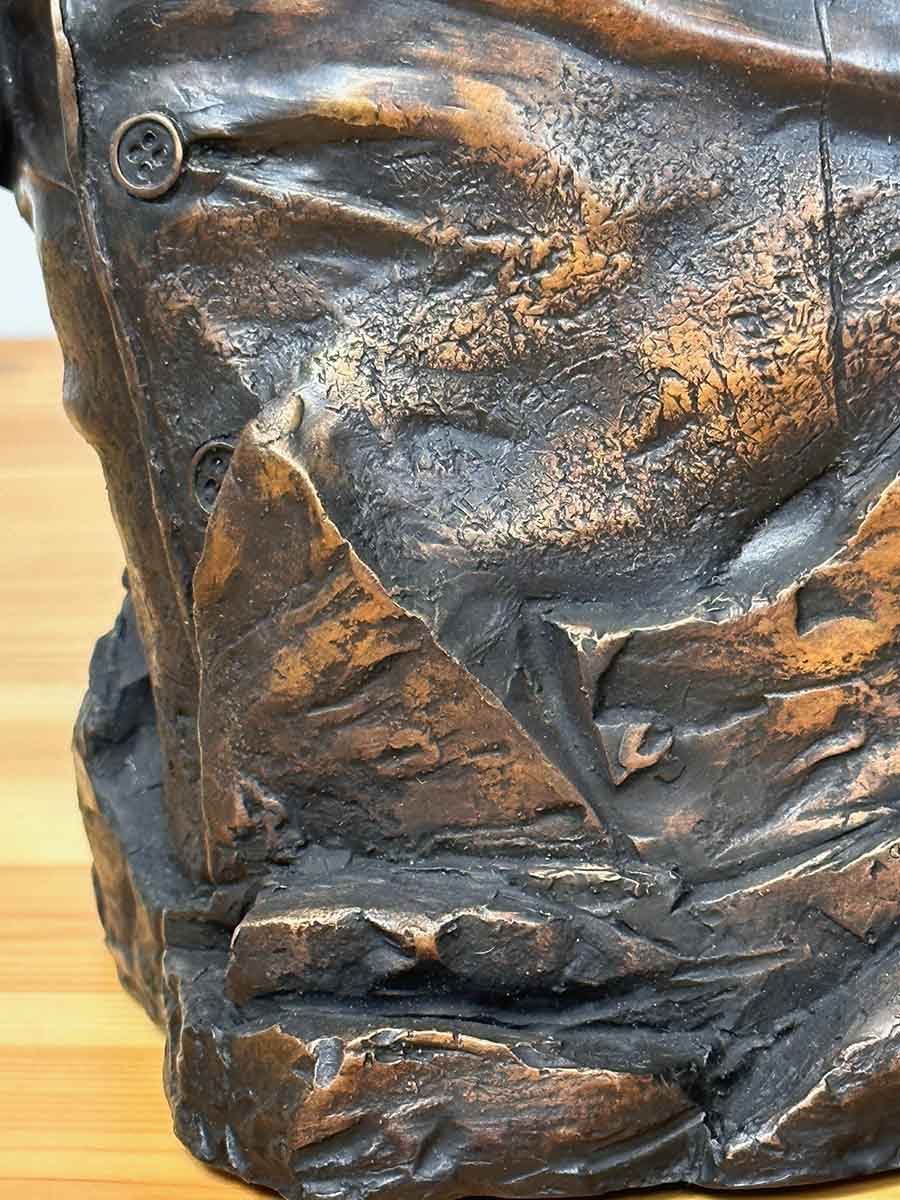
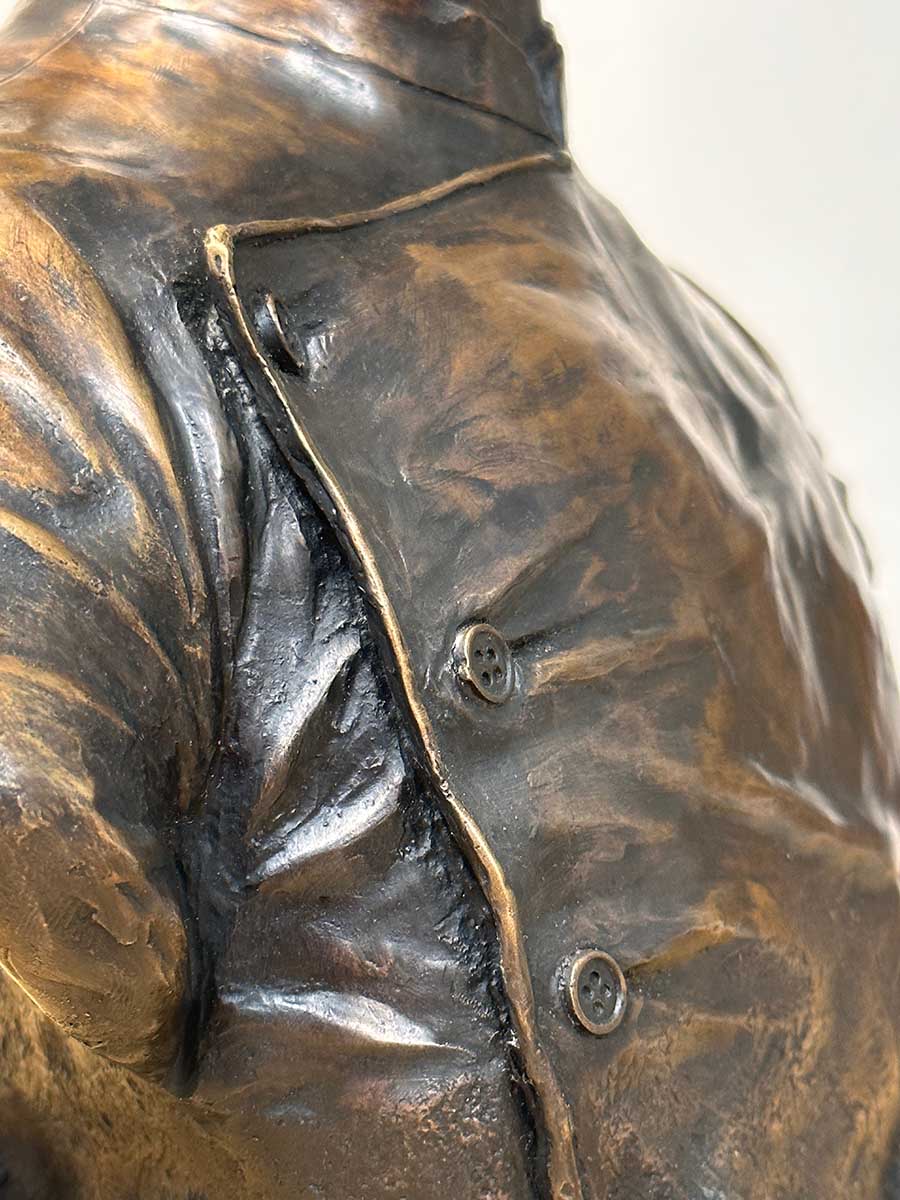
Please click on the image to enlarge.
Height: 15.2"
Width: 10.7"
Depth: 6.3"
Metric:
Height: 356mm
Width: 203mm
Depth: 1350mm
Weight: 10.4 kg
Disclaimer:
All dimensions, weight and colouring may vary due to the natural materials used and the throughout handmade process.
Roald Amundsen
This portrait sculpture of Roald Amundsen was created in cooperation with the Fram Museum in Oslo.
Roald Engelbregt Gravning Amundsen was a Norwegian explorer of polar regions. He was a key figure of the period known as the Heroic Age of Antarctic Exploration.
He left Norway in June 1910 on the ship Fram and reached Antartica in January 1911. His party established a camp at the Bay of Whales and a series of supply depots on the Barrier (now known as the Ross Ice Shelf) before setting out for the pole in October.
The party of five, led by Amundsen, became the first to successfully reach the South Pole on 14 December 1911.
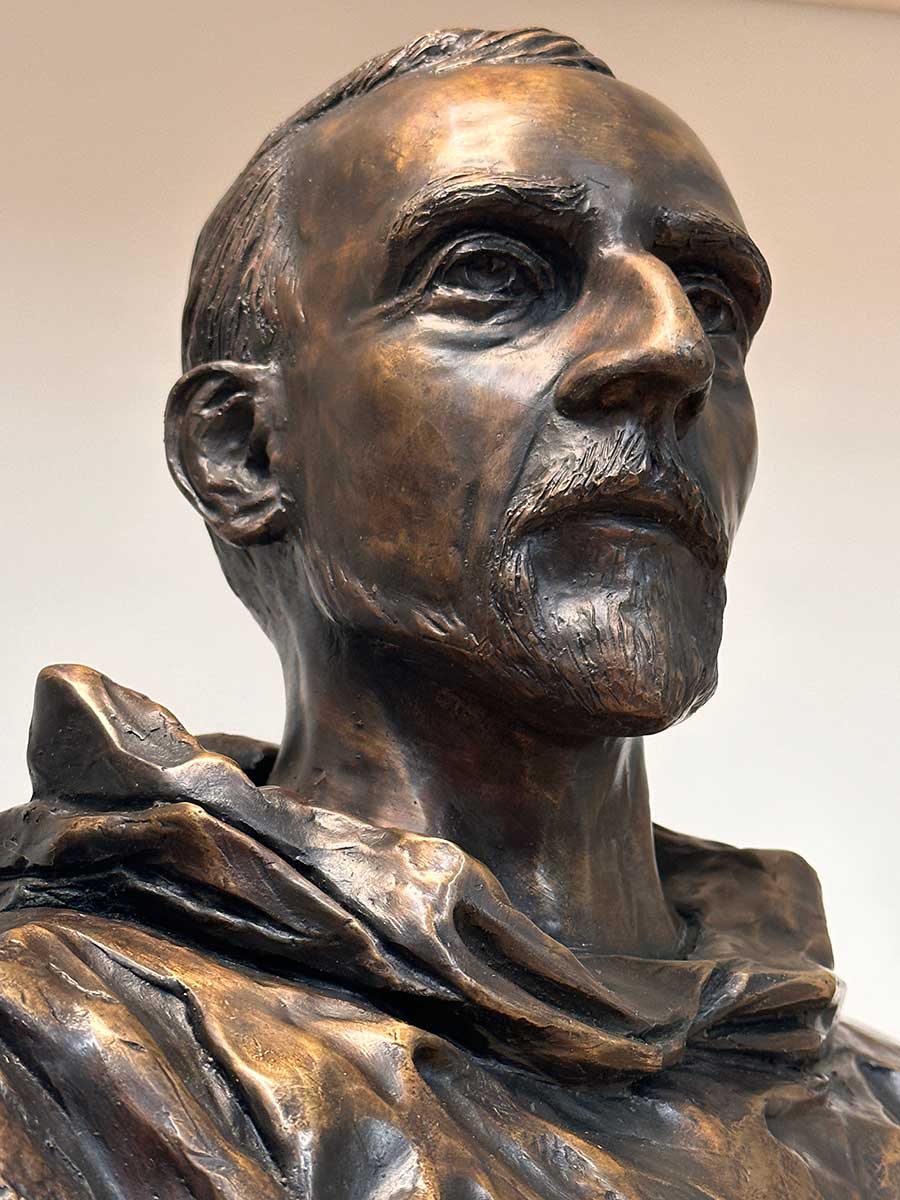
Height: 14"
Width: 11"
Depth: 6.5"
Metric:
Height: 355mm
Width: 279mm
Depth: 165mm
Weight: 18 kg
Disclaimer:
All dimensions, weight and colouring may vary due to the natural materials used and the throughout handmade process.
Roald Amundsen
This portrait sculpture of Roald Amundsen was created in cooperation with the Fram Museum in Oslo.
Roald Engelbregt Gravning Amundsen was a Norwegian explorer of polar regions. He was a key figure of the period known as the Heroic Age of Antarctic Exploration.
He left Norway in June 1910 on the ship Fram and reached Antartica in January 1911. His party established a camp at the Bay of Whales and a series of supply depots on the Barrier (now known as the Ross Ice Shelf) before setting out for the pole in October.
The party of five, led by Amundsen, became the first to successfully reach the South Pole on 14 December 1911.
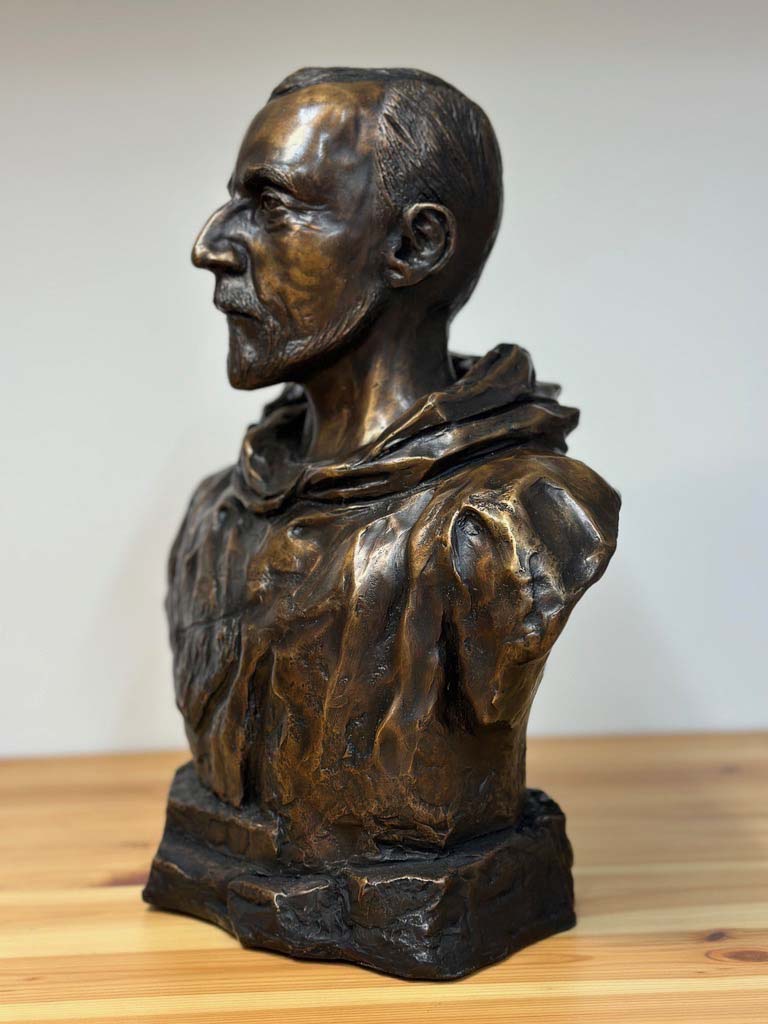

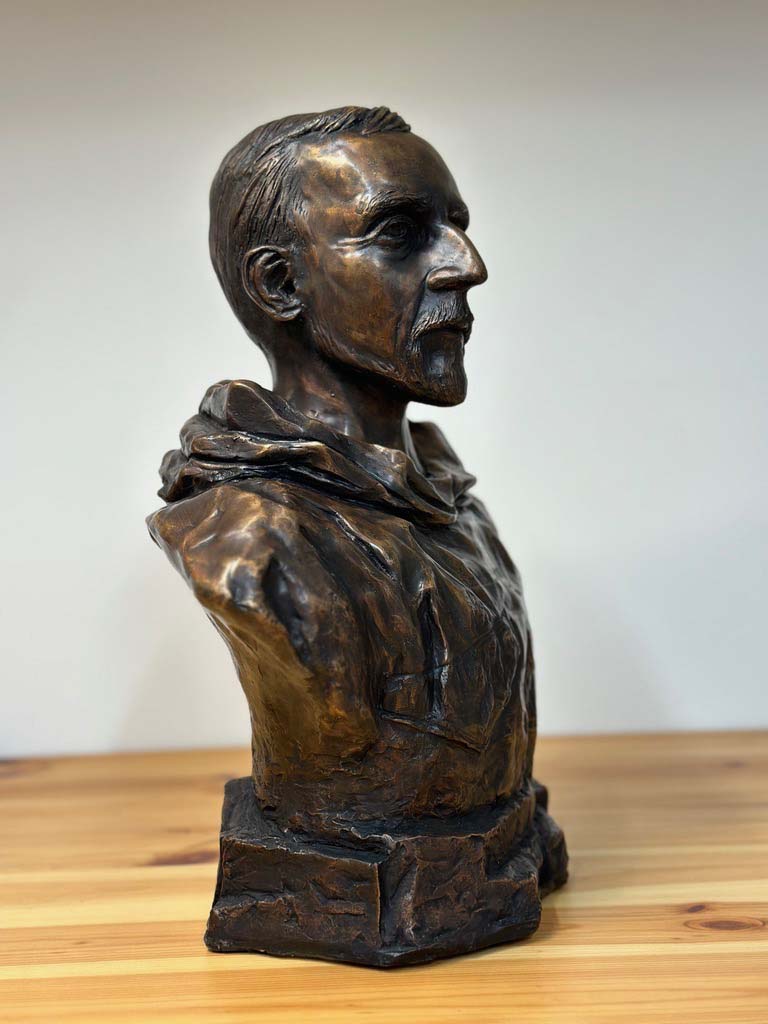
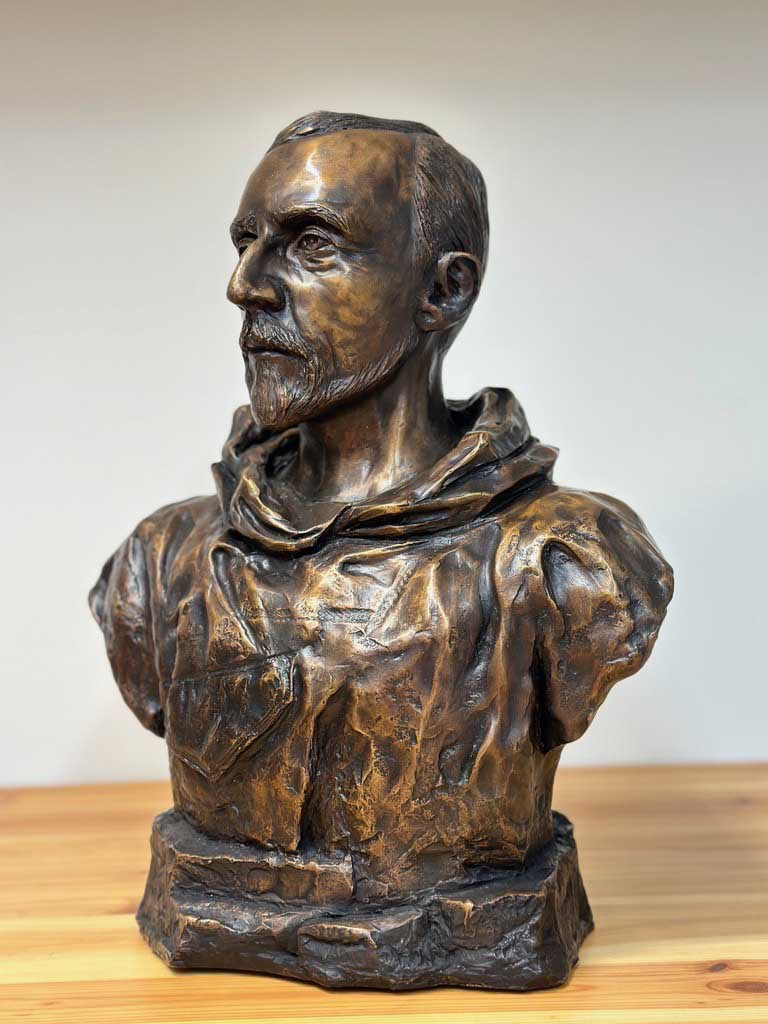
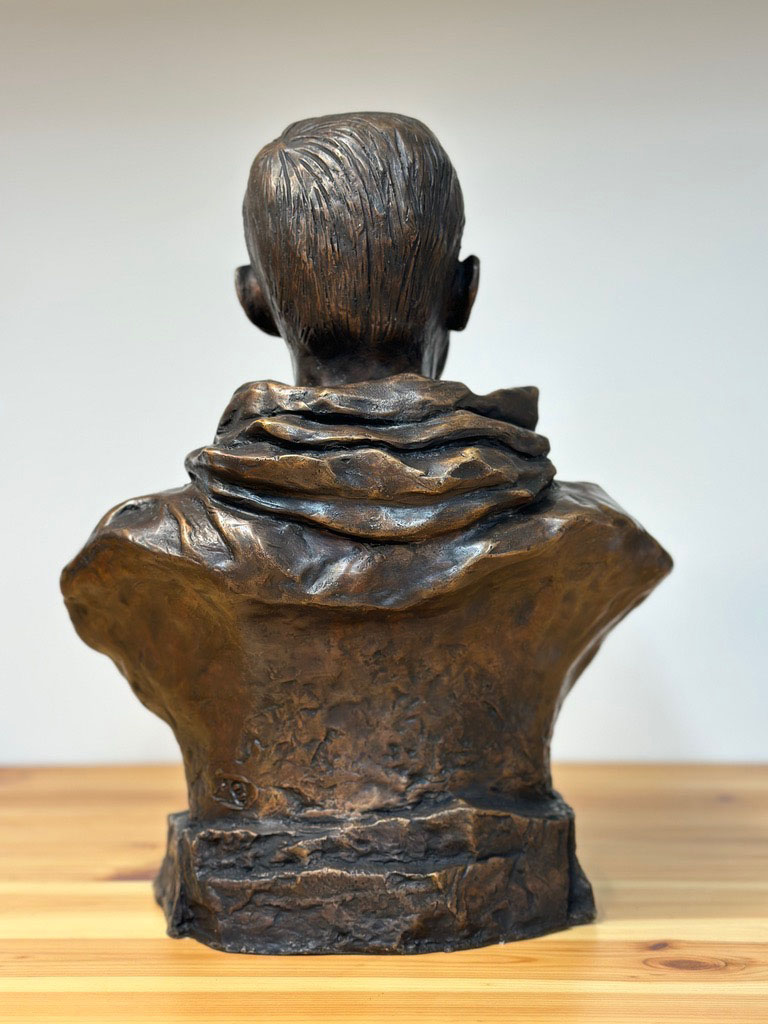
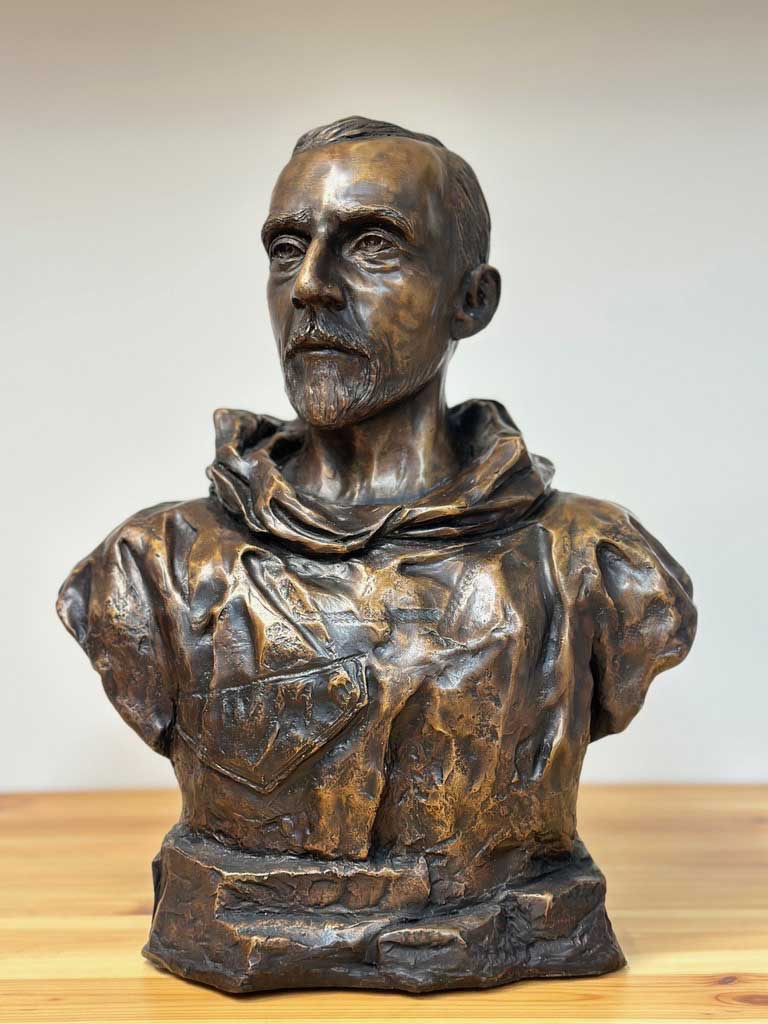
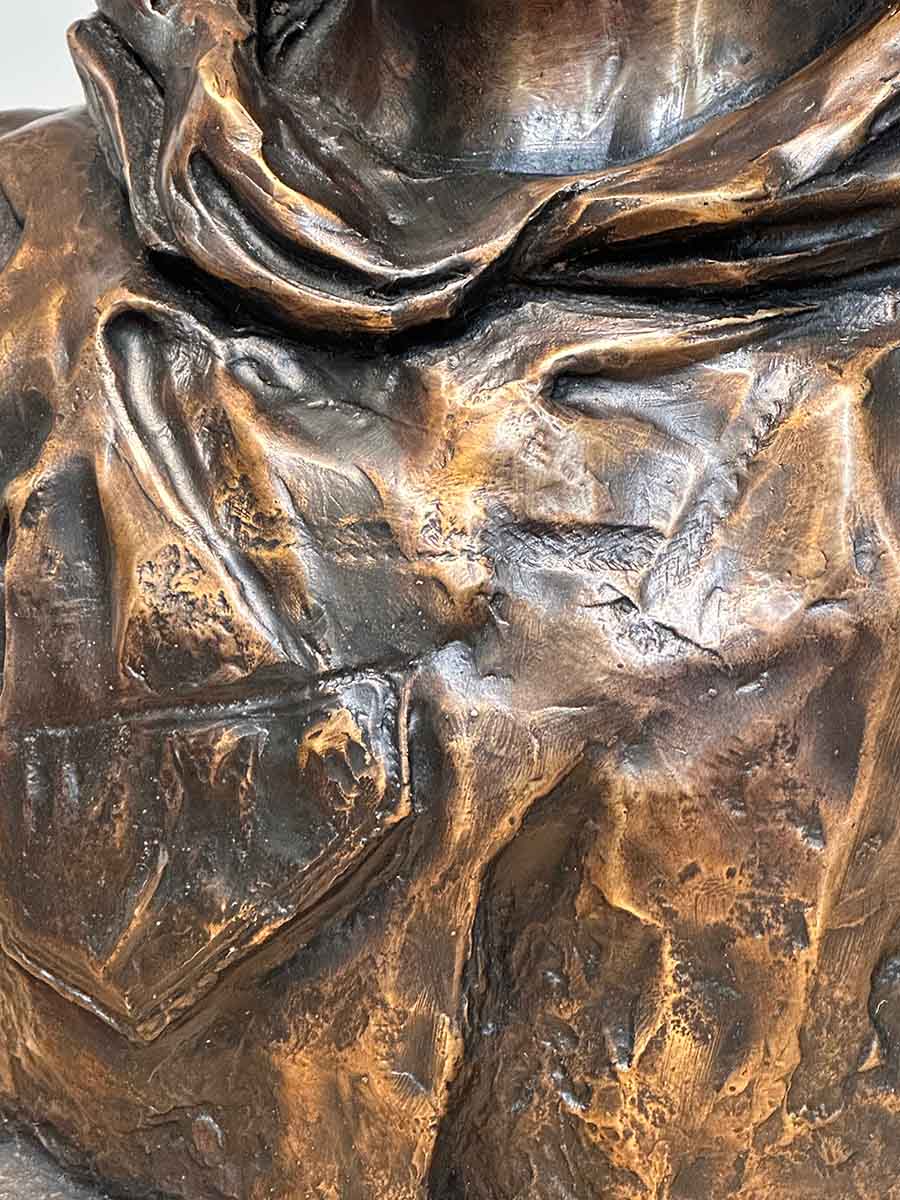
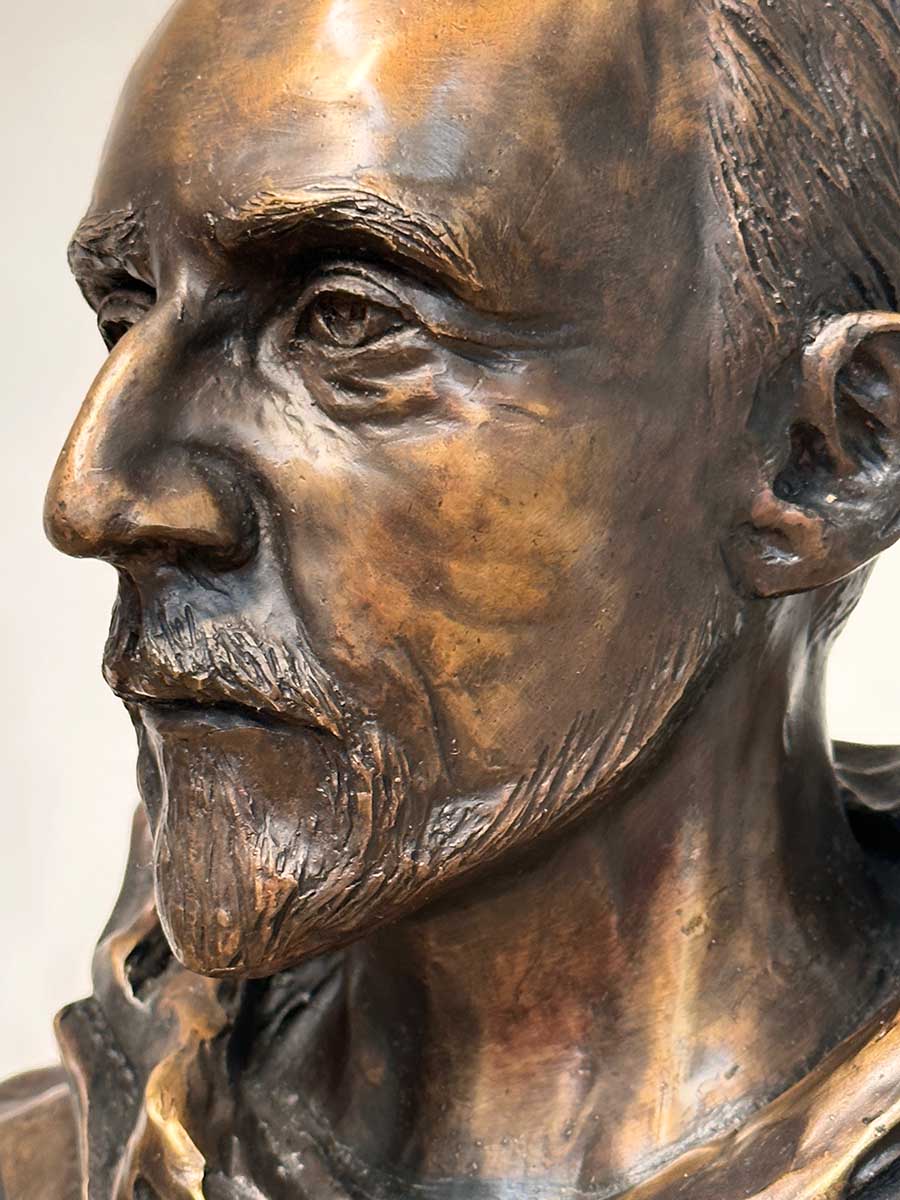
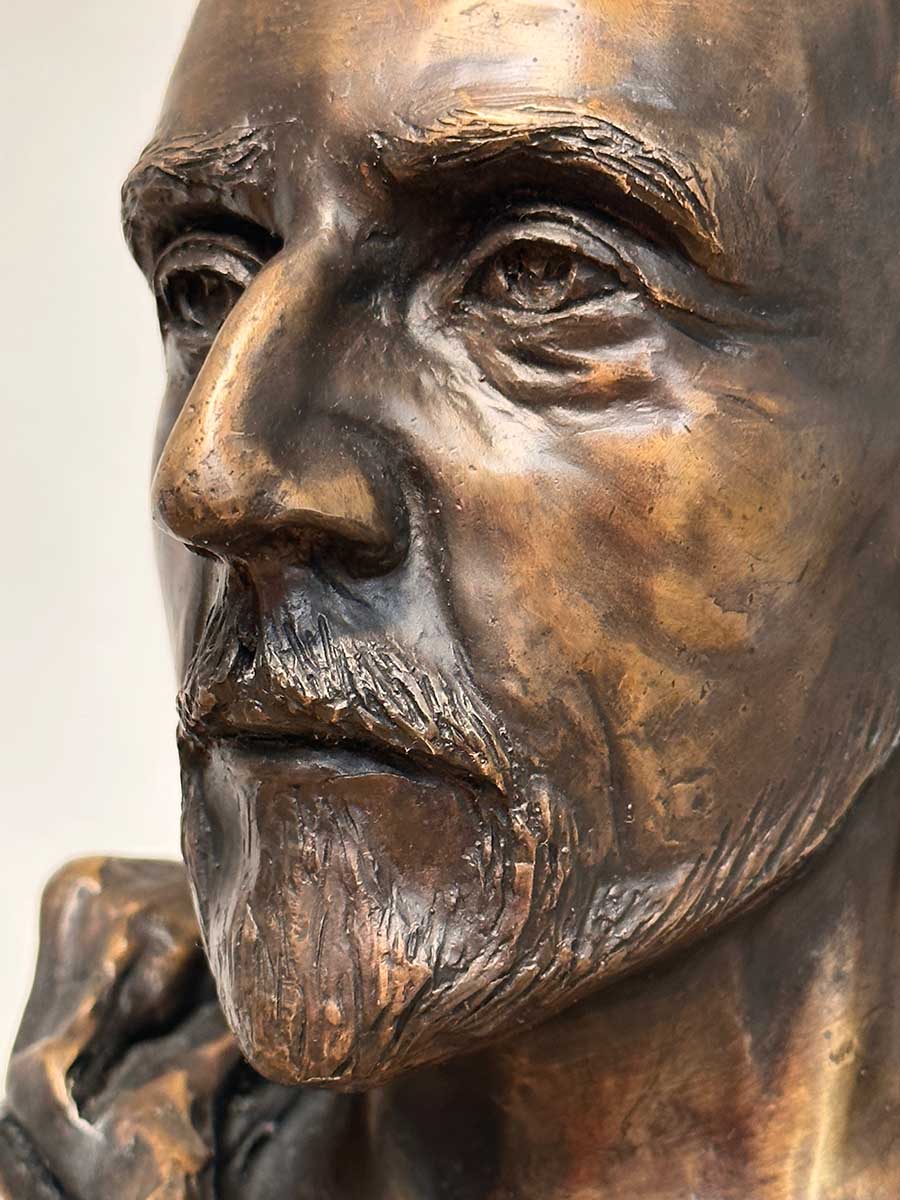
Polar Explorers
Norwegian, Irish & British

Ernest Shackleton
Irish Polar Explorer, 150th Anniversary
15th February 2024
Click on the image to enlarge.
15.02.1874 - 05.01.1922
Plaster
Ernest Shackleton is synonymous with Antarctic exploration and leadership.
He overcame unimaginable odds bringing home every man safely. Shackleton is celebrated as an iconic leader showing determination, courage and endurance.
The etch around the base reads:
"BY ENDURANCE WE CONQUER"
Height: 130mm
Width: 70mm
Depth: 35mm
Click on the image to enlarge.
15.02.1874 - 05.01.1922
Bronze Gilt
Ernest Shackleton is synonymous with Antarctic exploration and leadership.
The etch around the base reads:
"BY ENDURANCE WE CONQUER"
Height: 130mm
Width: 70mm
Depth: 35mm
Roald Amundsen
16.07.1872 - 06.1928
Plaster
was a Norwegian explorer of polar regions. He was a key figure of the period known as the Heroic Age of Antarctic Exploration.
The etch around the base reads: "VICTORY AWAITS HIM WHO HAS EVERYTHING IN ORDER"
Height: 132mm
Width: 78mm
Depth: 40mm
Click on the image to enlarge.
Roald Amundsen
16.07.1872 - 06.1928
Bronze Gilt
was a Norwegian explorer of polar regions. He was a key figure of the period known as the Heroic Age of Antarctic Exploration.
The etch around the base reads: "VICTORY AWAITS HIM WHO HAS EVERYTHING IN ORDER"
Height: 132mm
Width: 78mm
Depth: 40mm
Fridtjof Nansen
10.10.1861 - 13.05.1930
Is synonymous with Antarctic exploration and leadership. Later on in life the humanitarian and scholar received the Noble Price.
The etch around the base reads: "NEVER LEAVE A LINE OF RETREAT, IT IS A WRETCHED INVENTION"
Height: 135mm
Width: 75mm
Depth: 40mm
Click on the image to enlarge.
Fridtjof Nansen
10.10.1861 - 13.05.1930
Bronze Gilt
Is synonymous with Antarctic exploration and leadership. Later on in life the humanitarian and scholar received the Noble Price.
The etch around the base reads: "NEVER LEAVE A LINE OF RETREAT, IT IS A WRETCHED INVENTION"
Height: 135mm
Width: 75mm
Depth: 40mm
Robert Falcon Scott
06.06.1868 – 2903 1912
Plaster
Captain Robert Falcon Scott CVO was a British Royal Navy officer and explorer who led two expeditions to the Antarctic regions: the Discovery expedition of 1901–04 and the Terra Nova expedition of 1910–13
The Base
There are objects around the base of the bust depicting events and themes from Scott's fatal polar expedition. We have included the ponies, his ship, a motorised metal Sledge, a map of Antartica.
The etch around the base reads:
"FOR GOD'S SAKE, LOOK AFTER OUR PEOPLE"
Height: 133mm
Width: 65mm
Depth: 40mm
Click on the image to enlarge.
06.06.1868 – 2903 1912
Bronze Gilt
Captain Robert Falcon Scott CVO was a British Royal Navy officer and explorer who led two expeditions to the Antarctic regions: the Discovery expedition of 1901–04 and the Terra Nova expedition of 1910–13
The Base
There are objects around the base of the bust depicting events and themes from Scott's fatal polar expedition. We have included the ponies, his ship, a motorised metal Sledge, a map of Antartica.
The etch around the base reads:
"FOR GOD'S SAKE, LOOK AFTER OUR PEOPLE"
Height: 133mm
Width: 65mm
Depth: 40mm
Click on the image to enlarge.
This is a polar ornament incorporating the foremost polar explorers from Norway, the UK and Ireland. Roald Amundsen, Fridtjof Nansen, Ernest Shackleton and Robert Falcon Scott.
Here combined in a block resembling an iceberg as a desk ornament and paper weight.
Height approx 100mm
Diameter approx 100mm varying
Weight 0.5 kg
Click on the image to enlarge.
Life Size Bust in Plaster
Shackleton was an Anglo-Irish Antarctic explorer, best known for leading the 'Endurance' expedition of 1914-16.
Ernest Henry Shackleton was born on 15 February 1874 in County Kildare, Ireland. His father was a doctor.
The family moved to London where Shackleton was educated.
Rejecting his father's wish that he become a doctor, he joined the merchant navy when he was 16 and qualified as a master mariner in 1898.
He travelled widely but was keen to explore the poles.
With Scott and one other, Shackleton trekked towards the South Pole in extremely difficult conditions, getting closer to the Pole than anyone had come before.
Shackleton became seriously ill and had to return home but had gained valuable experience.
Height 55cm
Weight 18kg
Please click on the image to enlarge.
Height: 15.5"
Width: 10.5"
Depth: 6.5"
Metric:
Height: 394mm
Width: 267mm
Depth: 165mm
Weight: 8.6 kg
Disclaimer:
All dimensions, weight and colouring may vary due to the natural materials used and the throughout handmade process.
Fridtjof Nansen
This sculpture was created in cooperation with the Fram Museum in Oslo.
Fridtjof Wedel-Jarlsberg Nansen
10 October 1861 – 13 May 1930) was a Norwegian polar explorer, polymath and Nobel Peace Prize laureate.
He led the team that made the first crossing of the Greenland interior in 1888, traversing the island on cross-country skis.
He won international fame after reaching a record northern latitude of 86°14′ during his Fram expedition of 1893—1896.
Although he retired from exploration after his return to Norway, his techniques of polar travel and his innovations in equipment and clothing influenced a generation of subsequent Arctic and Antarctic expeditions.

Height: 14"
Width: 11"
Depth: 6.5"
Metric:
Height: 355mm
Width: 279mm
Depth: 165mm
Weight: 12 kg
Disclaimer:
All dimensions, weight and colouring may vary due to the natural materials used and the throughout handmade process.
Fridtjof Nansen
This sculpture was created in cooperation with the Fram Museum in Oslo.
Fridtjof Wedel-Jarlsberg Nansen
10 October 1861 – 13 May 1930) was a Norwegian polar explorer, polymath and Nobel Peace Prize laureate.
He led the team that made the first crossing of the Greenland interior in 1888, traversing the island on cross-country skis.
He won international fame after reaching a record northern latitude of 86°14′ during his Fram expedition of 1893—1896.
Although he retired from exploration after his return to Norway, his techniques of polar travel and his innovations in equipment and clothing influenced a generation of subsequent Arctic and Antarctic expeditions.















Please click on the image to enlarge.
Height: 15.2"
Width: 10.7"
Depth: 6.3"
Metric:
Height: 356mm
Width: 203mm
Depth: 1350mm
Weight: 10.4 kg
Disclaimer:
All dimensions, weight and colouring may vary due to the natural materials used and the throughout handmade process.
Roald Amundsen
This portrait sculpture of Roald Amundsen was created in cooperation with the Fram Museum in Oslo.
Roald Engelbregt Gravning Amundsen was a Norwegian explorer of polar regions. He was a key figure of the period known as the Heroic Age of Antarctic Exploration.
He left Norway in June 1910 on the ship Fram and reached Antartica in January 1911. His party established a camp at the Bay of Whales and a series of supply depots on the Barrier (now known as the Ross Ice Shelf) before setting out for the pole in October.
The party of five, led by Amundsen, became the first to successfully reach the South Pole on 14 December 1911.

Height: 14"
Width: 11"
Depth: 6.5"
Metric:
Height: 355mm
Width: 279mm
Depth: 165mm
Weight: 18 kg
Disclaimer:
All dimensions, weight and colouring may vary due to the natural materials used and the throughout handmade process.
Roald Amundsen
This portrait sculpture of Roald Amundsen was created in cooperation with the Fram Museum in Oslo.
Roald Engelbregt Gravning Amundsen was a Norwegian explorer of polar regions. He was a key figure of the period known as the Heroic Age of Antarctic Exploration.
He left Norway in June 1910 on the ship Fram and reached Antartica in January 1911. His party established a camp at the Bay of Whales and a series of supply depots on the Barrier (now known as the Ross Ice Shelf) before setting out for the pole in October.
The party of five, led by Amundsen, became the first to successfully reach the South Pole on 14 December 1911.









